Europe on a whirlwind: 19 days on a bus tour
- Andrea

- Mar 4, 2024
- 64 min read
Updated: 2 hours ago

A little bit of background📝
The year is 1996. My husband (W) and I, aged 25, are about to embark on our first ever bus tour, and our first proper exploration of Europe. We're from Australia and our 6-week trip was our first ever world wandering. It was the culmination of years of dreaming and 12 months of planning and saving. I've written this post in 2024, using my memories to guide me and the journal I kept at the time. This post is as much about documenting our trip as it is looking back in time to travel in the 1990s, before the days of Google, smart phones and Uber.
The trip is also a snapshot in time of my 25 year-old self and my first big international adventure. Reading through my original journal, I sounded so wide-eyed and in awe of everything. That's because I was!

Our 19-day bus tour of Europe was a big chunk of our six-week first big adventure in 1996. Our adventure started with an LA stopover, a whistlestop London experience, and a long weekend in Berlin. Then after the bus tour we hired a car and did a two-week road trip around England, Scotland and Wales.
I have to place a caveat on the photos that I've included in the post. They were taken on a 1990s camera, and scanned from the printed photos that are now almost 30 years old. The quality isn't great, to say the least. The 1990s fashions are also not great! To balance out the woeful quality photos, I've included some current ones from a range of sources, plus some gorgeous photos that our daughter, E, took in Italy during her solo trip in 2024.
Our whirlwind European tour💨
We did a Trafalgar tour which took us on a three-week chaotic adventure through France, Switzerland, Italy, Hungary, Austria, the Czech Republic, Germany, Luxembourg, and Belgium. The tour started and ended in London, crossing the Channel on the ferry from Dover to Calais and back again on a charter bus.

Why did we decide to do a tour, the two of us self-confessed introverts? Our reasoning was that it was the best way to gain a taste of Europe for our first foray onto the continent. It seemed a lot easier to place our wanderings in the hands of a tour company in those days, back before we were researching and booking things online ourselves. The world seemed less accessible then, something to wonder about and explore armed with only what we'd read in books or seen in films and on tv to guide us. That sense of wonder was kind of cool, though. It made everything we saw and experienced so incredible! That may sound old fashioned now, but I guess it was part of the adventure, knowing so much less about where we were heading.
💭The pros and cons of our decision to do a tour will become apparent as you read through the post. I've also summarised my thoughts on the tour at the end of the post, given my reflections on what the experience mean to me, and noted my most vivid and lasting impressions. |
Right, let's go!
Leg 1: London to Paris 🚌
We'd spent the night before the tour began at the Tower Thistle hotel after arriving back in London from Berlin, in preparation for the early start the next day of the tour from that hotel. The Tower Hotel, as it's now called, is quite well known as it features in lots of films and TV shows set in London, largely for its proximity to Tower Bridge and its café that sits adjacent to the Thames.
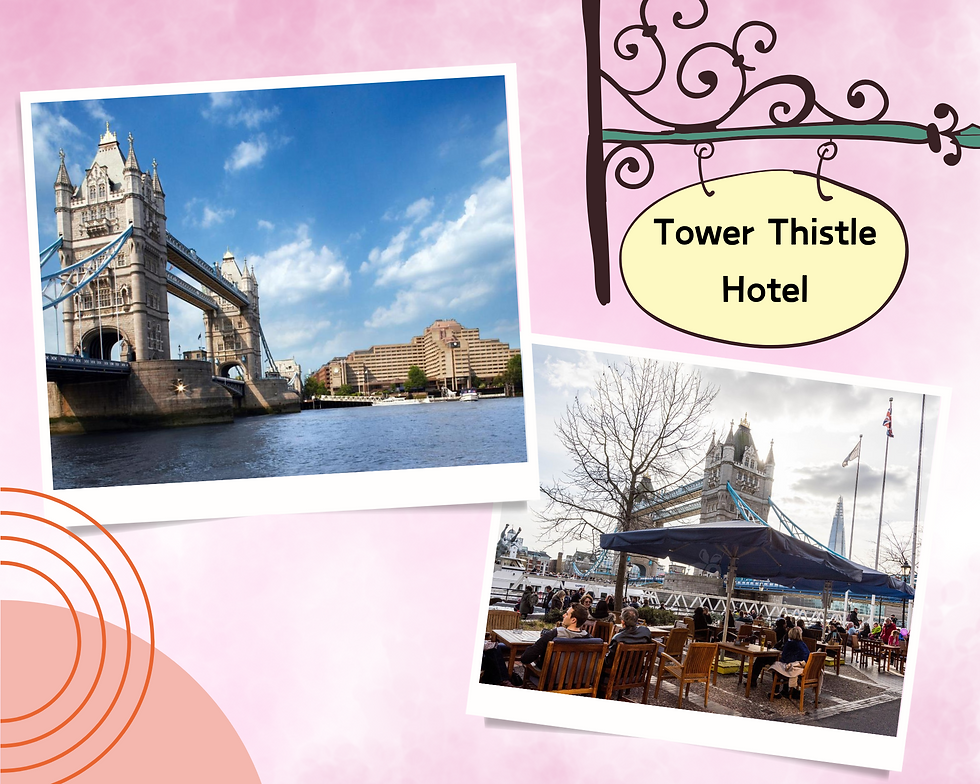
After a week on our own, we approached the tour with both excitement and trepidation. I had dreamed of visiting the places on the tour itinerary since I was a child, but I wasn't sure how I'd go cooped up in a bus for 19 days with a bunch of strangers. Day 1 of the tour was a long, too. London to Paris is 450km, around seven hours of travelling time by car or bus. That includes two hours from London to Dover, the ferry crossing (around 90 minutes) and then three and a half hours from Calais to Paris.

We were told to meet in the lobby at 5.30am but we ended up waiting for ages until the tour director, Graeme, arrived. The first part of trip was on board a charter bus through London out to Dover. The Chunnel had opened two years earlier but we were to cross the English Channel on the ferry from Dover to Calais. I've since taken the Eurostar from London and Paris (twice, actually) but I am glad we got to experience the channel crossing on the ferry.

The trip through the countryside to Dover was lovely. It was such a welcome change to be in open, green spaces after a week in crowded cities. Being on the tour bus with 40+ other people was a bit of a shock, though. We initially felt very hemmed in and wondered what we had signed up for!
Even after only a few hours on the tour it was a relief to be out of the bus and on the ferry once we were off to France. Such a cool experience! The crossing was smooth and it was awesome to see the white cliffs at Dover as we departed. We'd had no time for breakfast with the early start, so we bought something to eat and amazingly, I kept the receipt! I think it was the chicken tikka sandwich that did it to me...We'd never heard of chicken tikka!
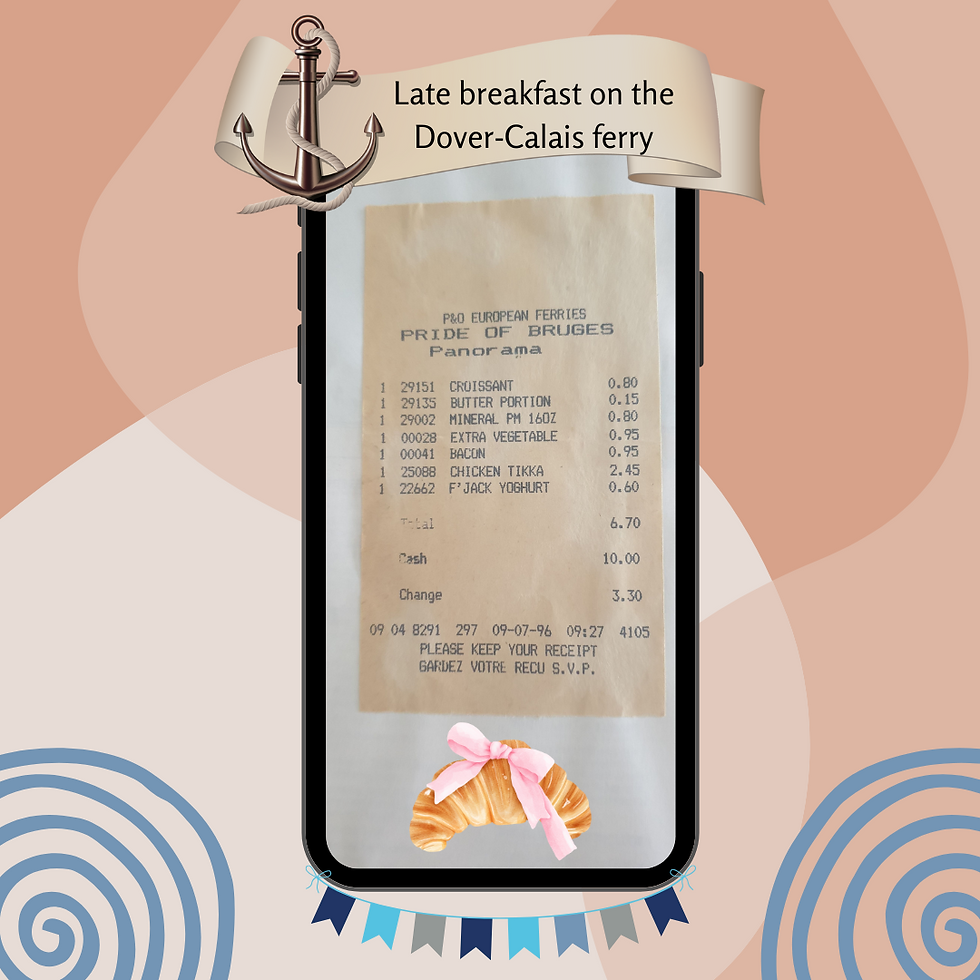
We met our Belgian bus driver, Luc, after disembarking in Calais. We boarded the tour bus, taking our allocated seats. Graeme told us that we'd be rotating around the bus as the tour progressed. I was still feeling unsure about our decision to do a tour but super excited to be heading to Paris. We felt a bit overwhelmed on that first day and struggled with being part of such a big group, realising that we were to be with them for a whole 19 days. Eek!
The trip to Paris took us through picturesque countryside along the motorway. We didn't stop other than for refreshments at a roadhouse, but Graeme pointed out the WW1 battlefields in the Somme and Vimy Ridge areas as we passed by. The roadhouse stop gave us the chance to scope out our fellow travellers. We introduced ourselves to a New Zealand couple (at the time in their late 30s/early forties) whom I will refer to throughout this post as T&D. We clicked with them instantly and came to rely on them for company throughout the trip.
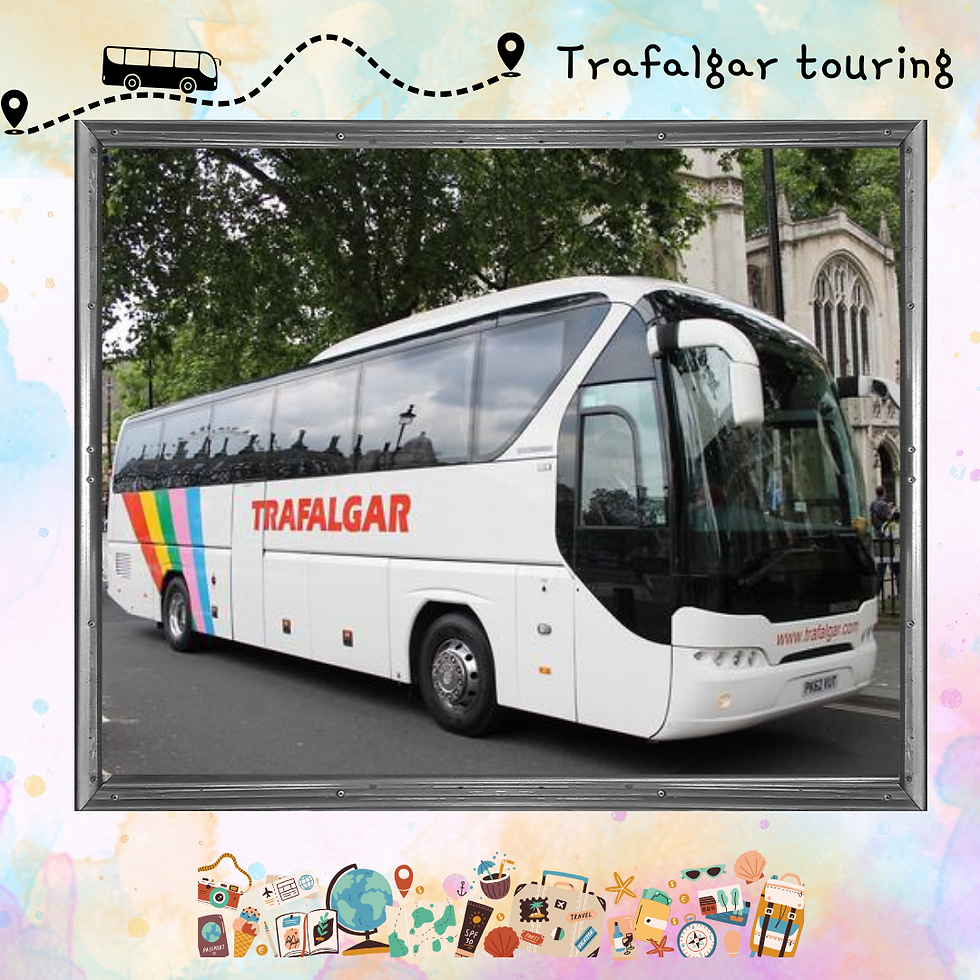
I recall that most of the rest of the group were Canadian, American and Australian and they were all much older than we were. There was a family with a teenage girl and a woman around our age travelling solo, but the age bracket definitely leaned north of 50. (That sounds odd to write now that I am in that age bracket!) We'd opted for an open-age tour rather than something specific to our age group. The tour itinerary factored the strongest in our decision, but also because we hardly fit the under-25-party-your-way-around-Europe demographic!
We drove into Paris late on day 1, after what seemed like hours and hours of travelling. I couldn't quite believe that I was heading into Paris. I was quite nervously anticipating my experience of the city. I kept craning my neck to catch a glimpse of the Eiffel Tower but all we saw were the city outskirts, framed by industrial structures and loads of apartment buildings. It all seemed a bit overwhelming, but that was probably just a mixture of excitement and the super early start to the day.
Our hotel was on the Left Bank and located in a pretty dodgy area. My first impressions of Paris did not live up to my expectations as I was looking for the chic and the glamour and hadn't seen it to that point. Our tour director seemed annoyed at the quality of the hotel, but to us it was fine. Our room was small but clean and the bed was comfortable.
Although we had paid around $4000AUD for the three-week tour (and this was a lot of money at the time to us), there was a bunch of optional extra tours that could be booked and paid for once the tour had commenced. We soon realised that some of the optional trips weren't really optional at all if you wanted to experience the key sights in each location!
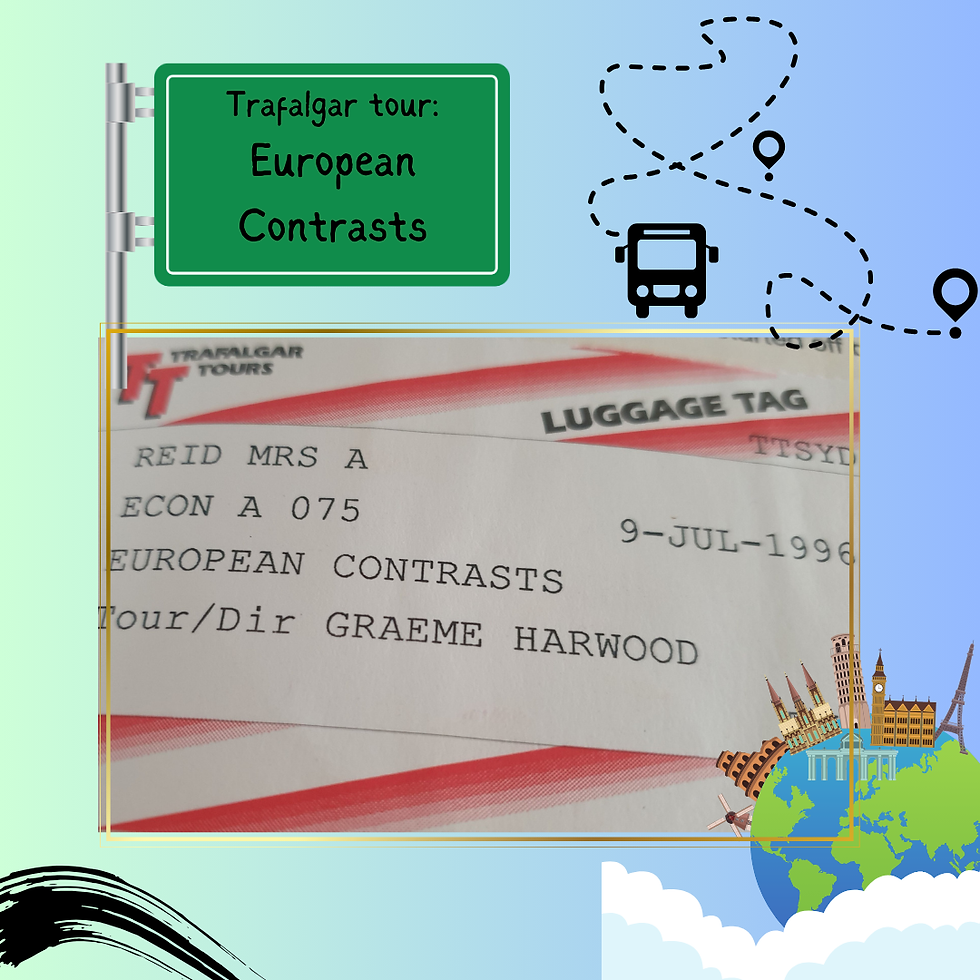
Our first optional tour was an evening drive around the city. The highlight, of course, was our first glimpse of the Eiffel Tower in all its sparkly greatness. This was a real pinch-me moment for me, to see such an iconic structure with my own eyes!

Before it got dark, we had braved late afternoon Paris traffic and drove past the Arc de Triomphe. We also stood out front of the beautiful Sacre Coeur church, although we didn't go inside. [There was generally a lot of rushing about that afternoon, so we only had glimpses of iconic sights.]
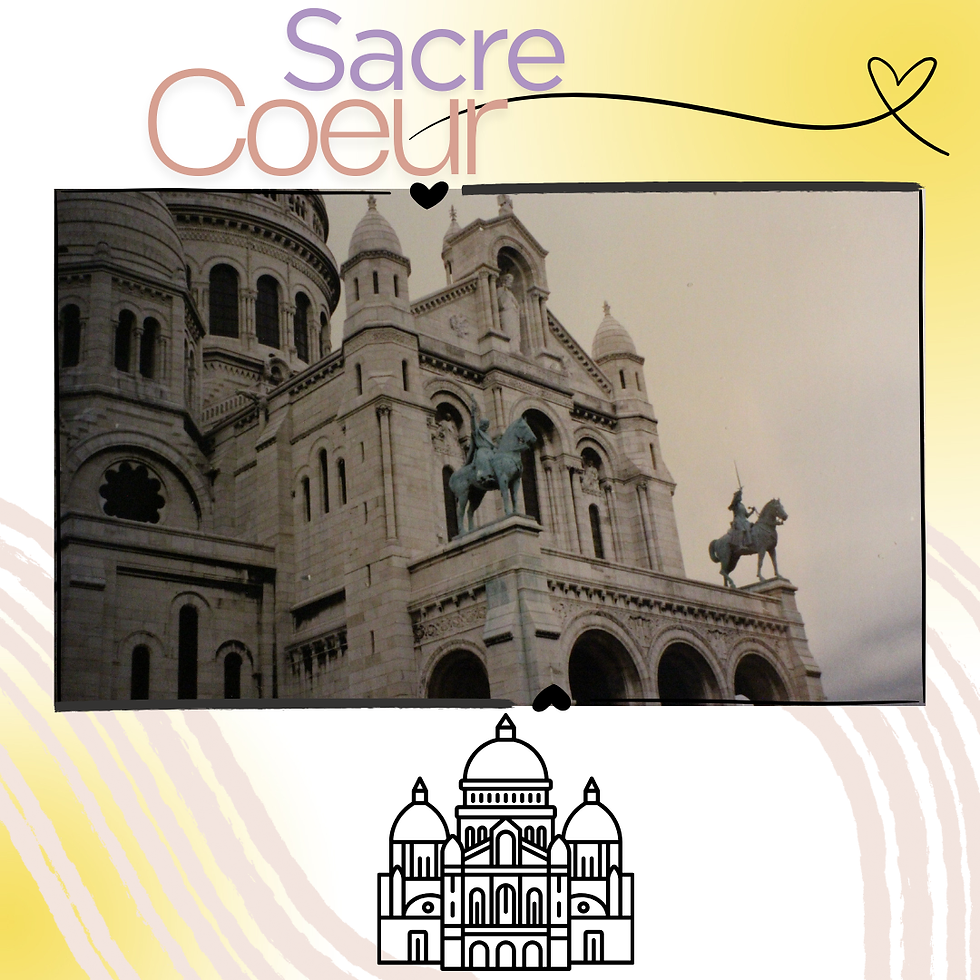
Later we stopped in Montmartre. I was excited to see the hilly streets and white buildings, just as I imagined Paris to be. My crummy photo doesn't do it justice, but I can still remember how thrilled I was to be able to see Parisian buildings up close.

We stayed in Montmartre for dinner and ate with T&D at a restaurant recommended by our tour director, Au Petit Creux. I remember we ordered a hot dog and lasagne - not very French!

It was lovely to have the chance to wander around Montmartre where we bought a Paris print from a stallholder that we had framed when we got home. It still hangs on our wall to this day. Here it is:
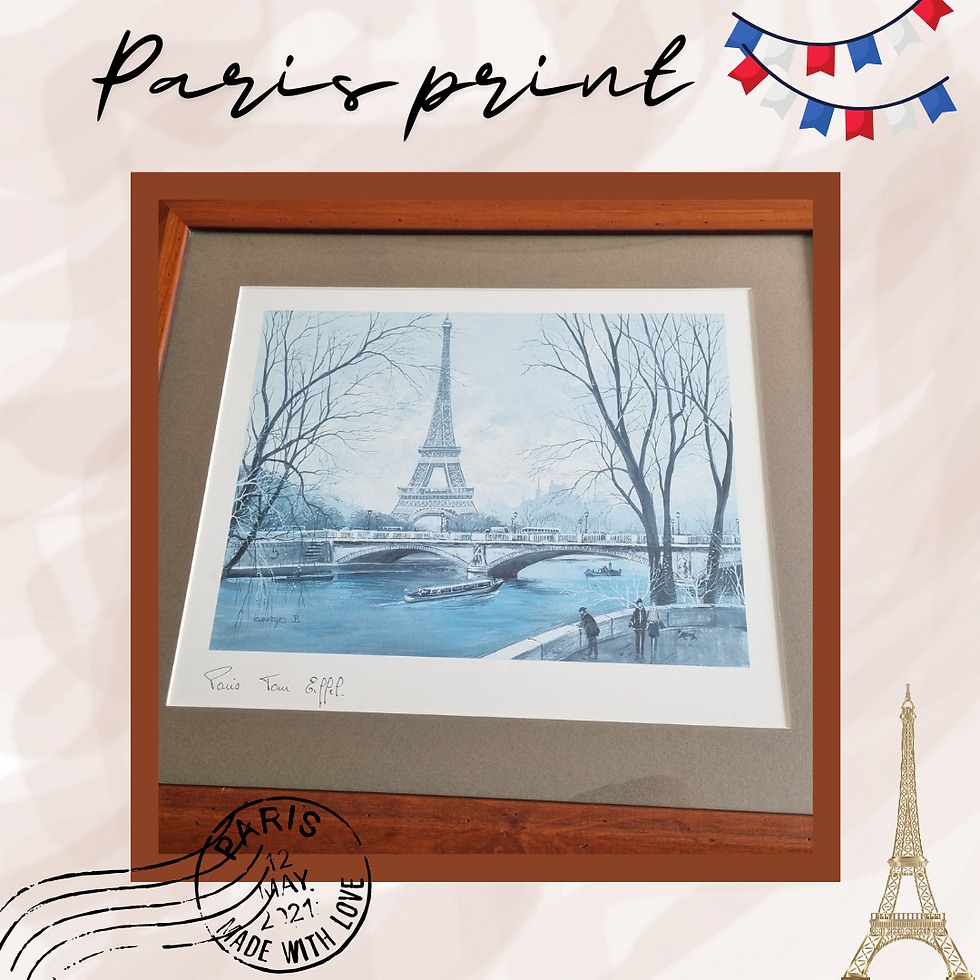
👜We decided we'd buy one item from each country we visited, partly because we didn't have much money in those days, and partly because we were away for six weeks and had limited space in our luggage. The Paris print was our France memento. |
Day 2 of the tour was spent exploring Paris, partly from the bus and partly on foot. We had a local guide, Stephane, who showed us around Notre Dame, with its magnificent front façade and stained glass windows. I loved the gargoyles! The cathedral was built in 1163 in French gothic style. I don't have any surviving photos of Notre Dame, but here's one I took during my 2022 Paris wanderings (post to come).

The rest of the tour was from the bus, passing the Louvre, the Sorbonne, the Opera House, the Arc de Triomphe, and down the Champs Elysees. It was something of a whirlwind experience of iconic structures but that's what you get on bus tours! It was only years later, when I visited Paris again and stayed for several days that I really felt like I'd seen the city (post to come, as noted above).
The mad dash around the city in the bus was included in the overall tour itinerary but to cruise the Seine River and go up the Eiffel Tower was a paid optional extra. We signed up for it of course! The river cruise was fab for the wonderful views of Parisian buildings and the many bridges with their golden columns. I think this is where my love affair with European architecture began. Unfortunately, it was cold and windy on the river cruise and we couldn't hear the guide, but it didn't matter, as the views were spectacular.

One of the advantages of a guided bus tour is the ability to skip the line at major sights. As it was July, the queue at the Eiffel Tower was long and we would have waited for hours if we'd been on our own (back in the day before timed entry tickets could be purchased online). Instead, we took the elevator straight up to the second floor.
I am terrible with heights so I felt nauseous when I looked down from the viewing area. The views are amazing, though, even if it wasn't a sunny day when we visited. The tower is so imposing when you see it up close, too. I had no idea of its size until that day.
The Tower stands at 330 metres, around the same height as an 81-storey building. It's the tallest structure in Paris, built between 1887 and 1889 and named after Gustave Eiffel, the engineer whose company built the Tower. It was originally built as the centrepiece for the 1889 World's Fair and as a centennial celebration of the French Revolution.

The afternoon was free time and even after only two days on the tour, we were quite glad of some time to ourselves. This is where the Google days of travel are better for figuring out what to do and how to get to places on the fly. We just had to wander around, as we weren't sure where to go.
We opted for the Opera House drop off point. We bought crusty bread rolls for lunch from a stall and crunched through them sitting on the steps of the Opera House after wandering around the entrance hall. The Opera House was opened in 1875, built at the behest of Emperor Napoleon III. It seats 1979 patrons.
I remember two things from our pitstop: One was how rude the server was where we bought our lunch as we asked for our food in English, not able to speak French at the time. I know that sounds stereotypical, but that was our experience. The second thing that struck me was the contrast between the stylish Parisians we saw on their lunch breaks and the beggars on the steps of the Opera House.
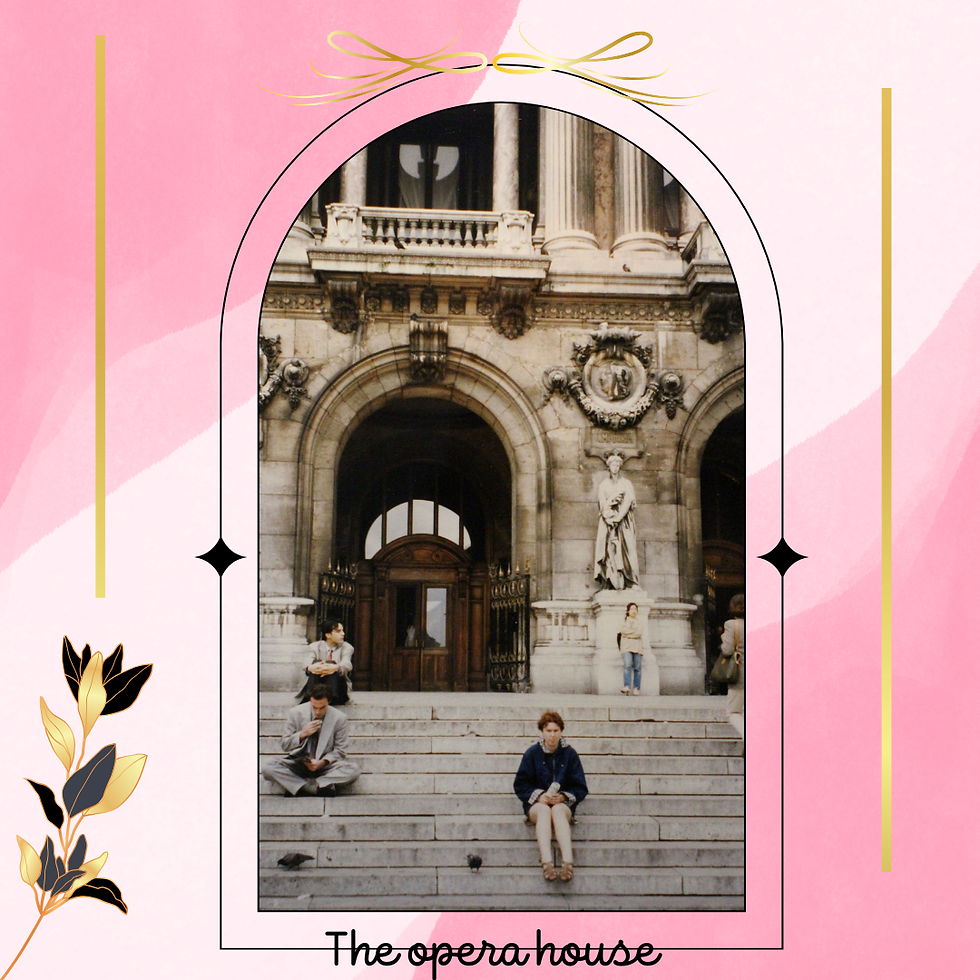
The sun finally came out and it was a glorious afternoon. After lunch we had a poke around the huge Galeries Lafayette department store with its impressive dome and stained glass ceiling. It was nothing like any shops we had in Australia! Awesome. The below photo was taken on my 2022 visit to Paris (post to come) as I don't have any photos from our tour.

We walked to the pick up point at the Louvre then and spent some time enjoying the sunshine and people-watching. It was a shame that we didn't go into the Louvre, but the line was long and we wouldn't have had time to see much of the museum's treasures. Again, I had the chance to visit later, when I was in Paris in 2022 (post to come).
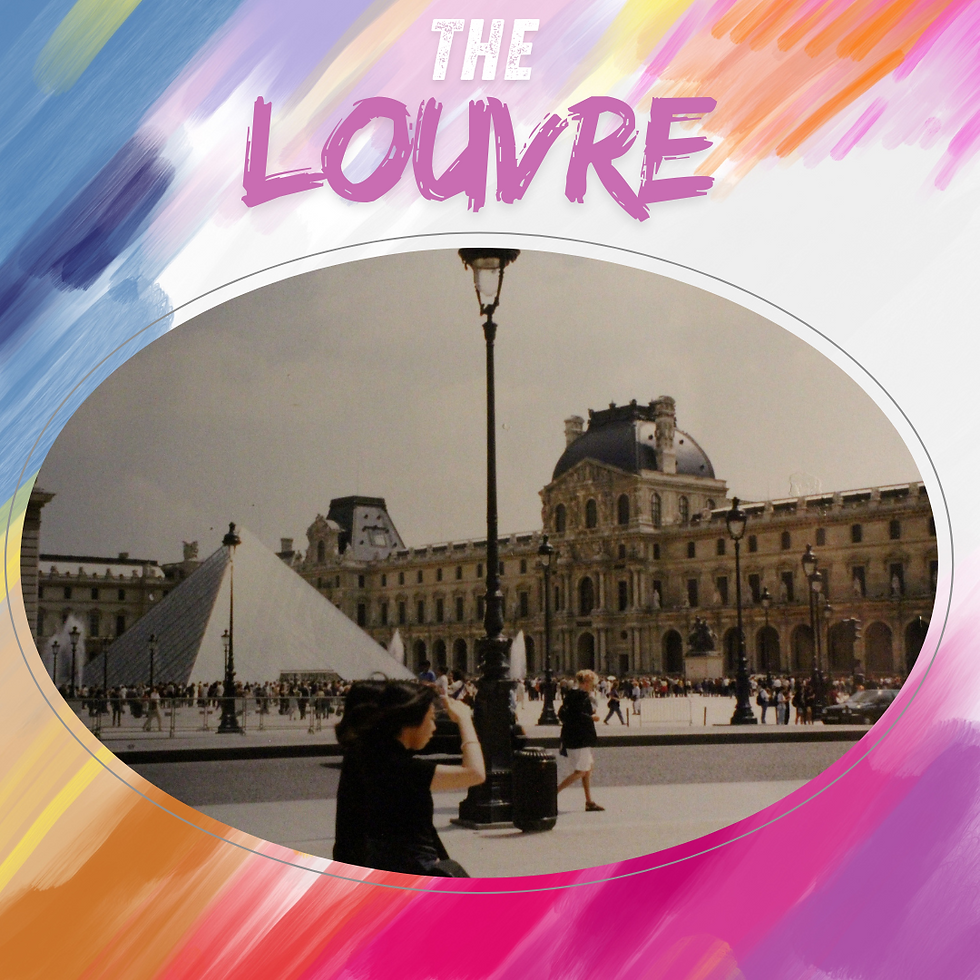
We had to organise our own dinner once back at the hotel, but wandering around the dodgy area near our hotel proved fruitless (and a little scary, if I am being honest). In the end we found ourselves back at the bakery next door to the hotel where we bought a light meal and had a relaxing evening in our room.
For more Paris wanderings, see my post on my 2015 work trip and 2022 adventure with my daughter (post to come).
Leg 2: Paris to Lucerne 🚌
Day 3 was a big travelling day. We made the 645km trek from Paris to Lucerne in Switzerland. We stayed for two nights in Engelberg, another 35km up into the mountains from Lucerne.

The first part of our day was the journey from Paris to Beaune, around 300km and a 3-hour trip. We headed south-east from Paris, stopping at the wine-producing town. The town was gorgeous - quaint cobbled streets and tiny shops. Beaune is the wine capital of Burgundy in the Cote d'Or department between Lyon and Dijon. It is a walled town with battlements and ramparts. Even though our stay was short, I loved it, and felt much more attuned to my surroundings than in Paris.
We did a wine-tasting thing in a cellar although it was a bit lost on me, a non-drinker. Lunch was fresh crusty bread and fruit as we wandered around the town.
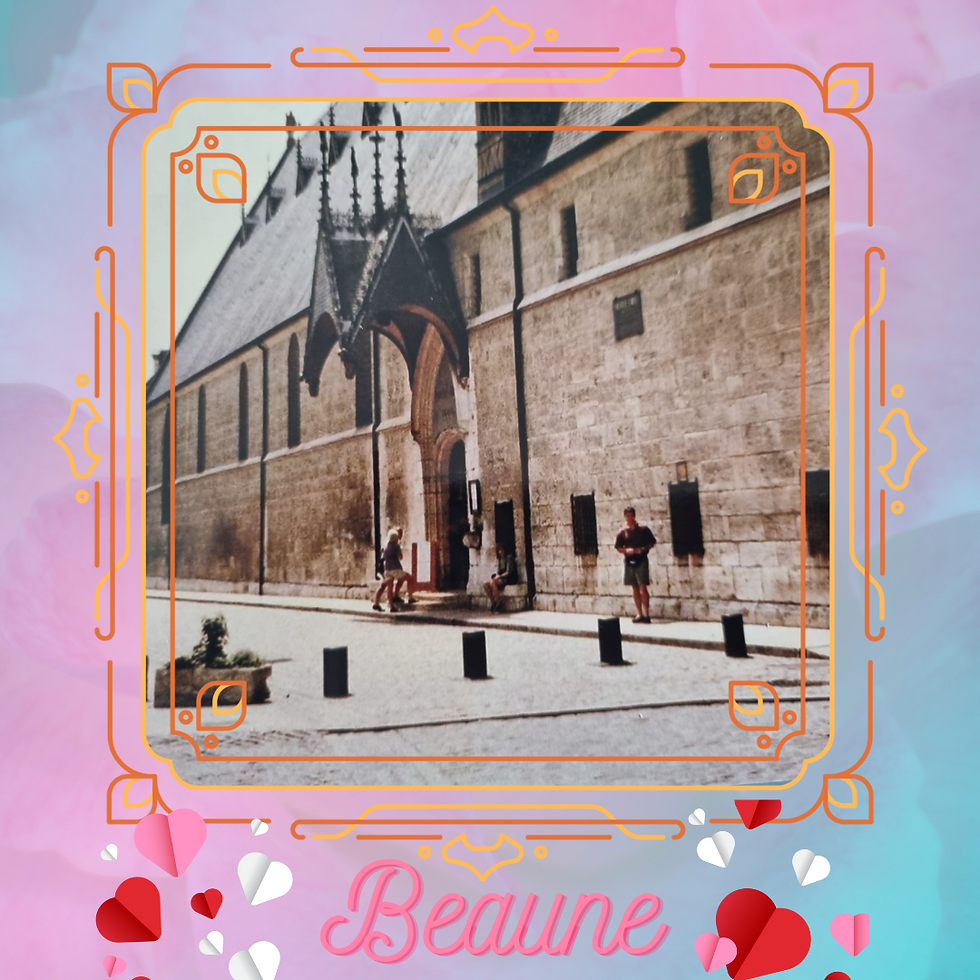
The afternoon was a 4-hour journey into Switzerland though absolutely beautiful French countryside. That was it for France, until our return to Calais for the ferry back to Dover at the end of the tour.
Our France experience💭I loved the journey through the beautiful French countryside and our stop at Beaune. My love affair with European landscapes still remains to this day and it's safe to say it started on this trip. I remember at the time feeling a little underwhelmed by Paris but perhaps my expectations of one of the world's most famous cities were too high. That said, I remain not entirely in love with the city still (unpopular opinion, perhaps), despite three subsequent visits. The Eiffel Tower was cool, as were the ornate buildings and bridges, and I loved the limestone apartment buildings and wrought iron balconies in Montmartre. I've had the chance to see a lot more of the city since this first visit, but I still don't feel a connection to it. I'm not really sure why, it just doesn't vibe with me. |
We crossed into Switzerland via Basel, an industrial town on the border. Switzerland was simply stunning, just like the chocolate box pictures!
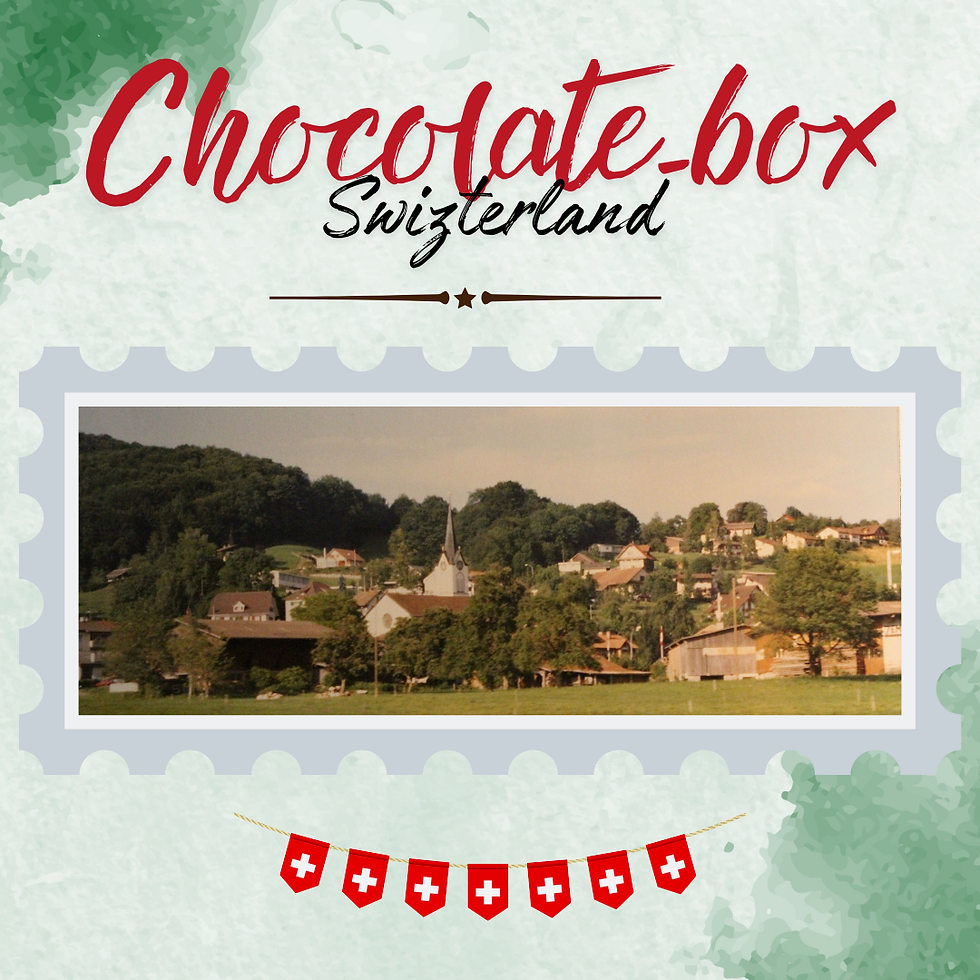
We stayed in the beautiful mountain town of Engelberg for Leg 2. Our hotel (Europaischer Hof Hotel Europe) was stunning. It is a gorgeous 19th century building with chandeliers in the common areas, large foyers and wide hallways. It was renovated in the early 2000s, but the photo below from the hotel website is still how I remember it.

The view from our room was amazing! That night, we had our first hotel dinner. I noted in my journal at the time that it was our first 'proper meal' in several days. I wrote down what was on the menu: soup, veal, and chocolate mousse. (These were my pre-vegetarian days.)
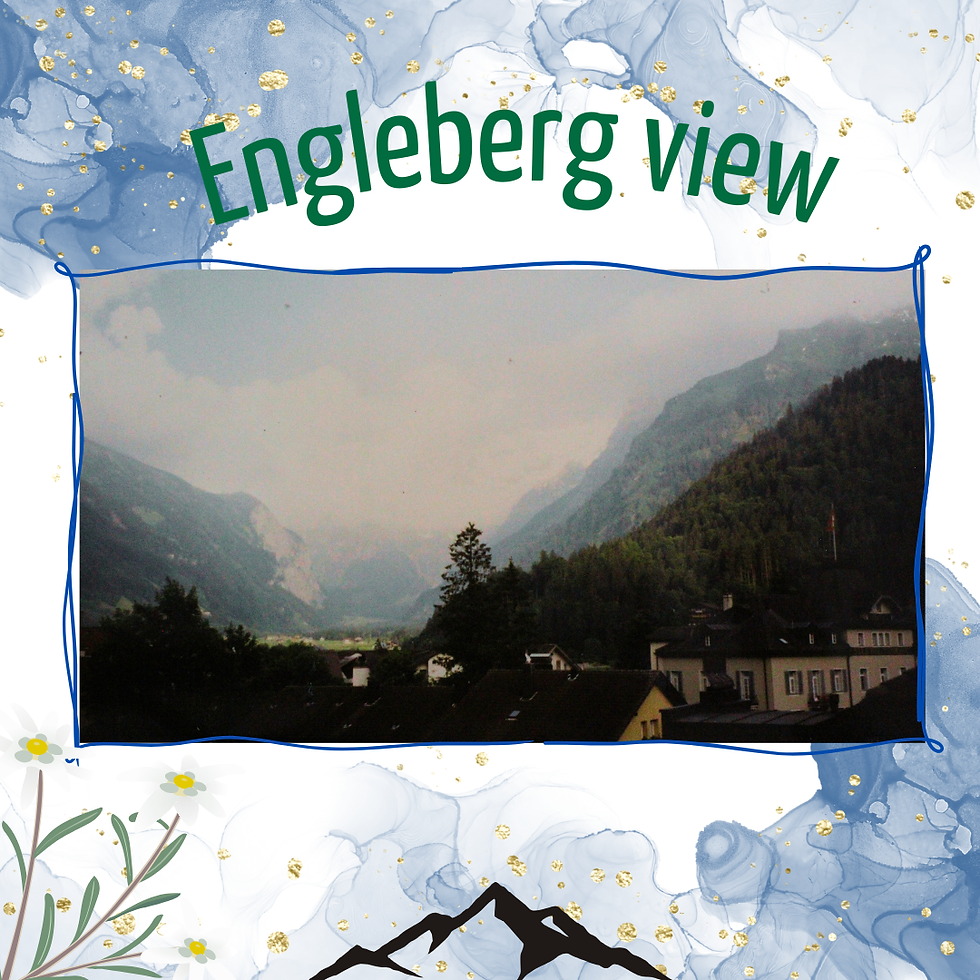
Day 4 was a beautiful day in the mountains and we were thrilled to be heading up Mt Stanserhorn first thing. We travelled by cable railway then cable car up the 6000-foot mountain. The views were totally worth travelling on the cabled transport that made me feel a bit anxious (it didn't seem all that safe to me).
It was a little foggy up top, but we still saw magnificent views of the mountains, complete with cow bells clanging in the distance. We climbed up to the lookout for a better view and felt quite short of breath at that altitude. It's incredible, right, even if my photos aren't great.

After coming back down the mountain we drove into Lucerne, one of the prettiest cities I have ever seen. Before lunch, we had made a stop at the Lion Monument, hewn in 1820-1821. I still recall to this day being moved by the carving in the rock face of a lion defeated in battle, the agony of defeat so clear on the lion's face. The monument is a memorial to Swiss guards killed during the French Revolution in 1792.

Lunch was at Restaurant Stadtkeller, a super touristy fondue and Swiss folklore show. Yeah, it was cheesy (see what I did there?) but fun just the same. The fondue was very rich and I found it too much for my palate, but there were also sausages and potatoes and a yummy dessert cake. The folk show included yodelling, flag throwing, dancing, and Swiss horns and bells. Hilarious.

We had free time to wander around the city after lunch. What a beautiful place Lucerne is, and I loved our afternoon wanderings. The city simply took my breath away! We'd had fun in the morning on our mountain trip and at lunch, but it was nice to be on our own for the afternoon, without a schedule, just wandering around and soaking up the atmosphere. We walked across the famous covered bridge and along parts of the Reuss river. We had intended to buy a watch but sadly what we saw was out of our budget. We opted for a totally kitschy souvenir - a carved wooden plate.

Dinner was in our lovely hotel again, and another three-course meal of soup, a main, and a dessert (that I noted in my journal was something called "banana creme"). Three-course meals aren't really my jam, but the included meals meant we rarely had to buy food ourselves.
We were exhausted after a long day and lots of walking but excited to be heading to Italy the next day!
Leg 3: Lucerne to Florence🚌
Day 5 and the next part of our journey took us to Italy, descending the mountains from Engelberg and through the longest tunnel in Europe at 17km, the Gotthard Road Tunnel. There were constant traffic jams on the motorway as we battled with other holidaymakers and a series of toll booths. It was interesting to see the landscape change as we headed into the Italian region of Switzerland, from clean, pristine alps to a drier landscape and Mediterranean buildings.

Our final Switzerland stop was in Lugano, in the Italian-speaking Ticino region by the beautiful lake. This was a journey of 170km from Lucerne. We wandered around the cobbled streets, thrilled to be there on a market day, spending the last of our Swiss francs on fresh fruit and bread.

We passed by Lake Como later and skirted around Milan and Bologna before arriving in Florence late in the afternoon, having crossed the Northern Italian Plain and over the Apennine Mountains. It was a long day of travelling, but the beautiful and changing scenery made it all worthwhile. The journey from Lugano to Florence is 380km, taking over four hours.
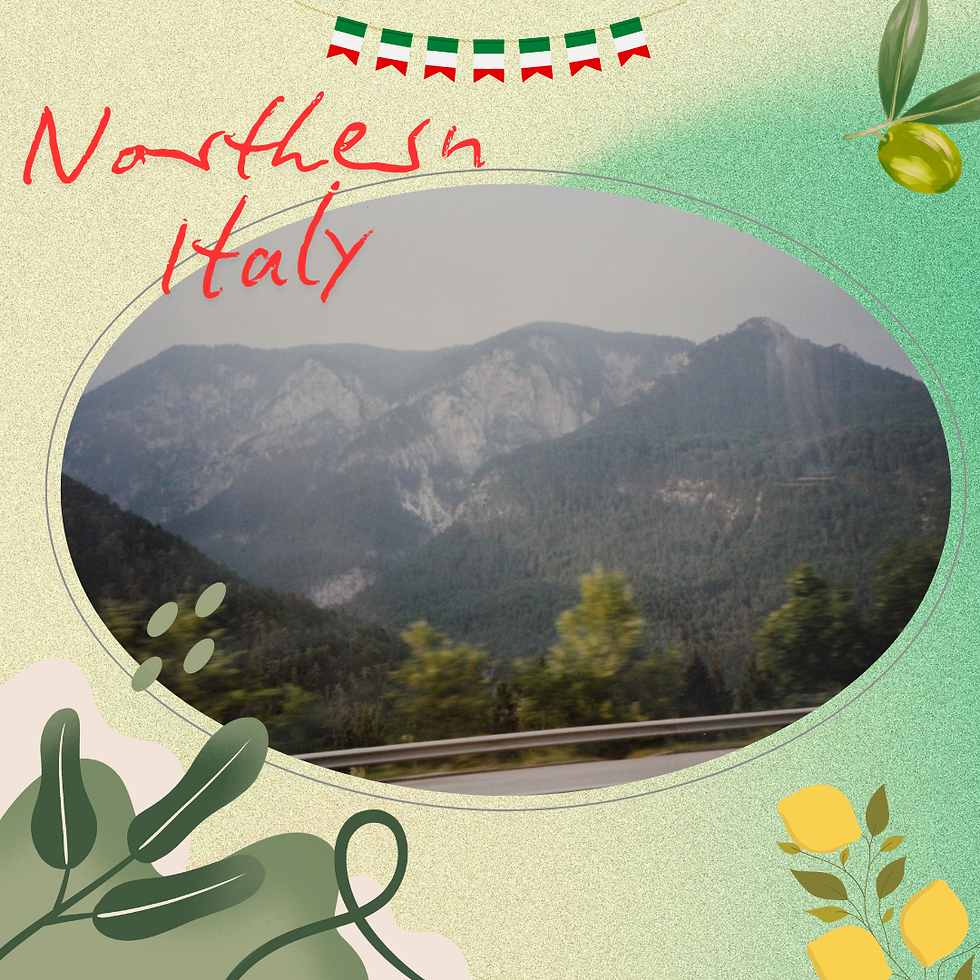
Before checking into our hotel we drove to Piazzale Michelangelo, for incredible views of Florence. There's a replica statue of David at the piazza, too. Our tour group photo was taken at the lookout. It was a real scream. The local photographer climbed up on a ladder to get the whole group into the shot. Unfortunately that photo does not seem to have survived our many moves over the years. Shame. I do still have the below shot from the piazzale, showing the beautiful Arno River and the city buildings and bridges.

That night we had an included dinner at a local restaurant of pasta and fresh fruit. After dinner we walked with T&D, our Kiwi tour buddies, along the river back to the hotel, crossing the gorgeous Ponte Vecchio bridge that dates back to 1345. Amazing! Our tour director was reluctant to let four of his charges out of his sight, but we convinced him we'd be fine. I didn't want to miss the opportunity to walk over the Ponte Vecchio as we didn't do that with the group the next day.
I wasn't able to capture the glorious sight of the Arno River and the Ponte Vecchio as the sun set, but I have included these stunning shots, taken by our daughter, E, on her 2024 Italian adventure, when she was 23.

My photos are completely rubbish, so I also wanted to include this one of E's that does some justice to the magnificent bridge. What a difference a beautiful day and a 2024 camera versus a 1996 one makes!
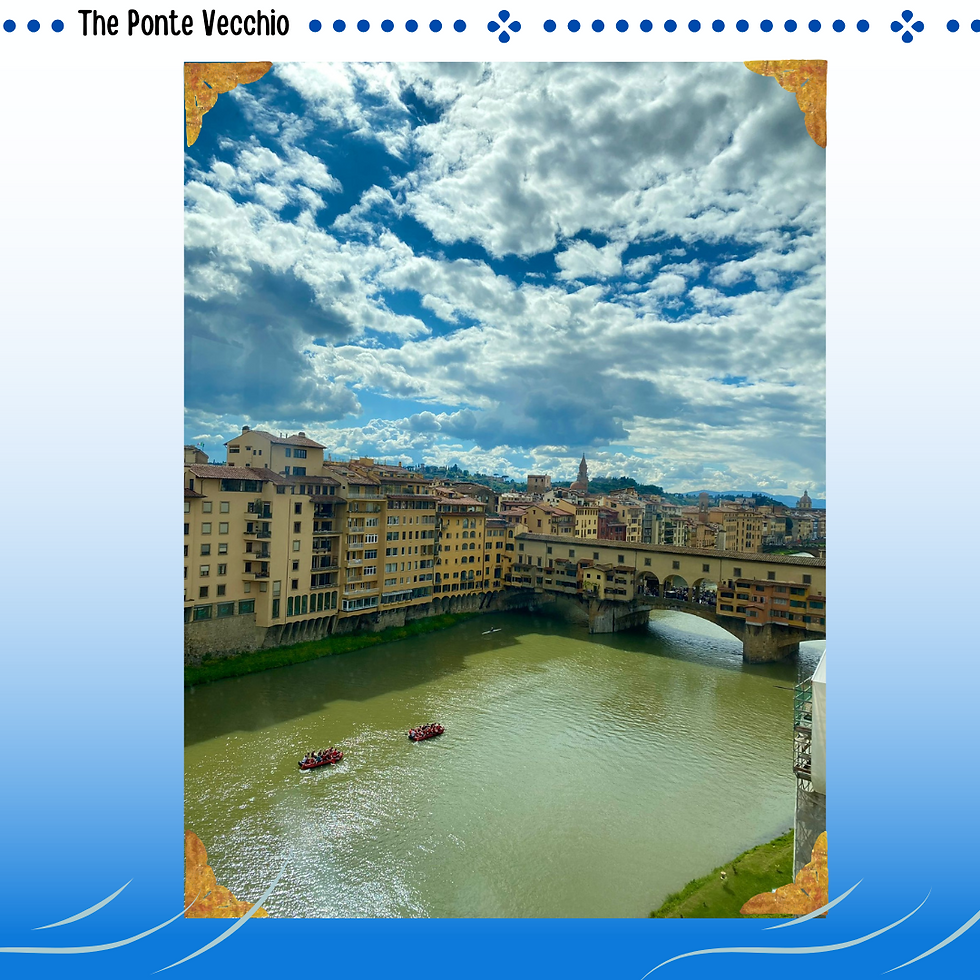
I absolutely loved Florence, something I hadn't counted on prior to embarking on the tour. I was more fascinated by the Germanic parts of Europe at the time and counted Italy as a nice bonus rather than a must-see. Perhaps having no expectations helped, but I just loved the beautiful cobbled streets, the distinct architecture, and the stunning bridges over the Arno. Here's another of E's shots to properly show you what I mean.

We had a lovely local guide, Francesca, to take us around Florence the day after our arrival, Day 6 of our tour. The Cathedral of Santa Maria del Fiore (The Duomo) was of course the highlight even though we didn't have time to climb to the top or even have a peek inside. I've included this simply stunning photo that E took from her climb to the top of the Duomo. I'm so sorry we didn't get to do this. It's one of the cons of doing a tour, seeing some things from the outside only.
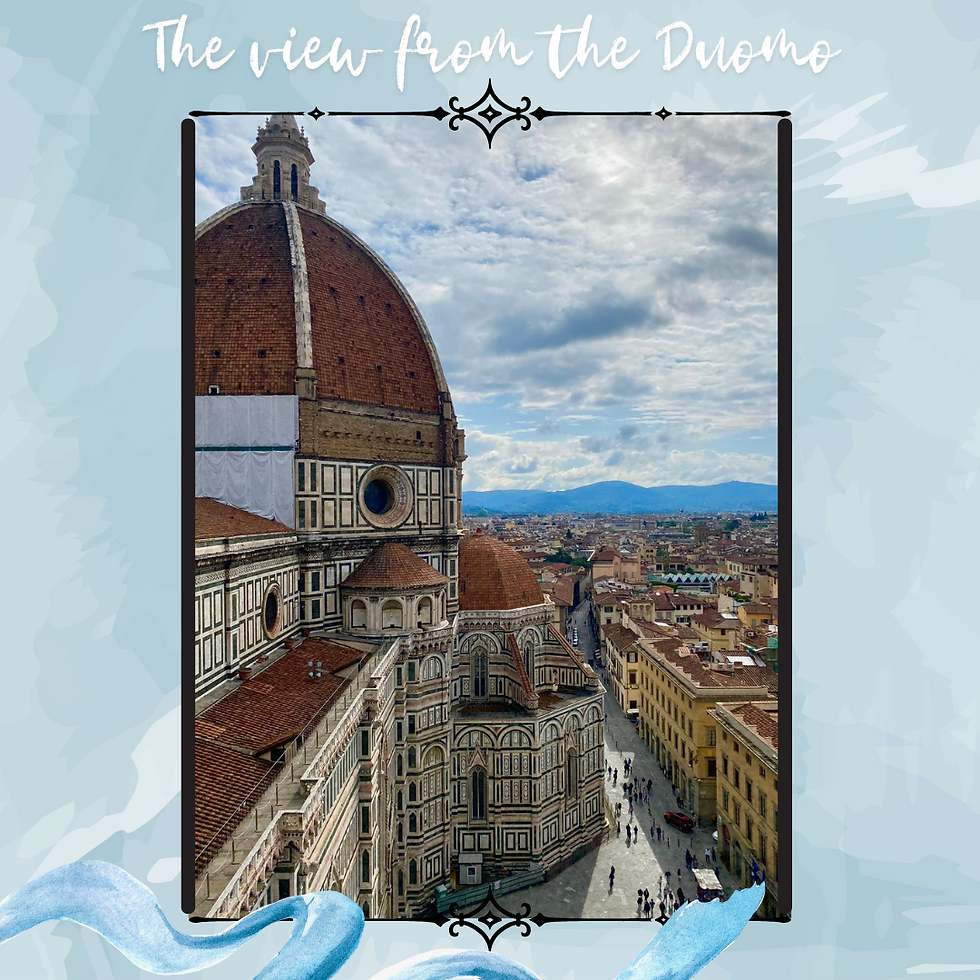
At least we had some time to take in the magnificence of the cathedral from the outside. Francesca showed us the 5th century Baptistry exterior, with its eight-sided green and white structure and sculpted doors, particularly highlighting the gold panels depicting Old Testament scenes on the east door (The Door of Paradise). The size and magnificence of the 13th century cathedral and Giotto's Bell Tower (85 metres high) just blew us away. The Cathedral is 153 metres in length and 90 metres wide and 90 metres high. The Cathedral's name, Santa Maria del Fiore, means Lady of the flower and is a nod to Florence, the city of flowers.

Other sights on our guided tour included the Piazza Della Signoria (housing another David replica where the original one stood, and a statue of King Neptune), Sante Croce gothic Basilica (dating back to the 1200s), and the Uffizi Gallery. Touring so many places in such a short time really limits the depth of your experience, sadly. We still fell in love with Florence, even though our visit was so brief and we saw most things only from the outside.

We did have an opportunity to wander around some typical Florentine streets, and I appreciated that. I still remember to this day the building in the below shot and how desperately I wished I could have seen inside it. This was the beginning of my love affair with European stone buildings 💞.
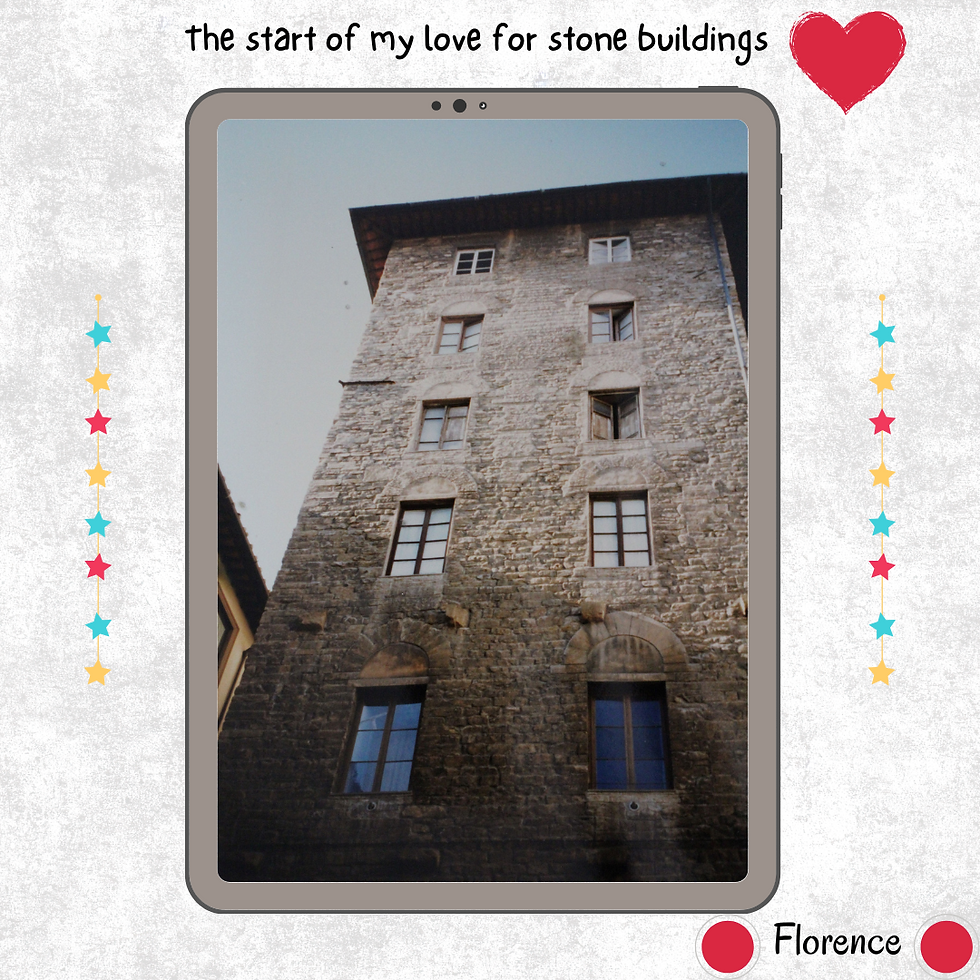
We visited famous the Peruzzi store on our tour and were treated to a leatherwork demonstration. I bought a wallet from the shop that I recall I used for quite some time after the trip.
We had then some free time to wander around the shops where we bought two little framed prints. The Ponte Vecchio one is pictured below, but I also bought one of the cathedral. We still have the prints on display at home.
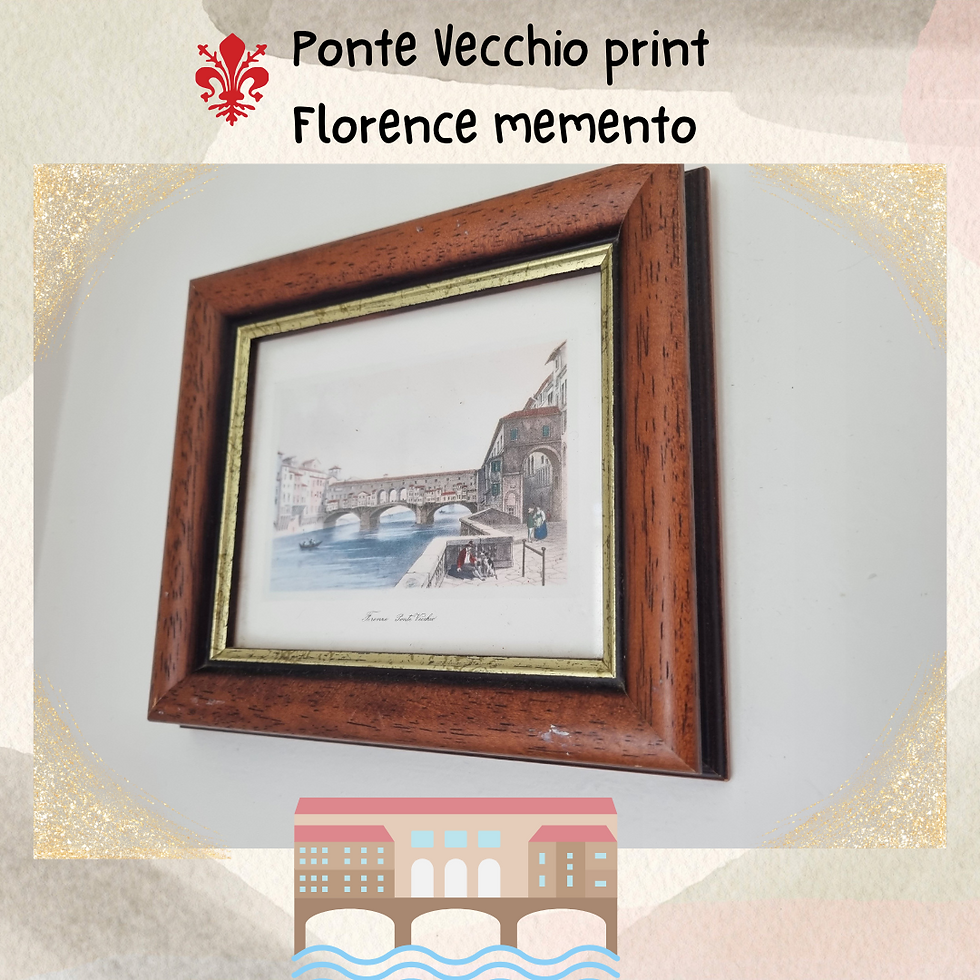
Leg 4: Florence to Rome 🚌
Unfortunately, we only had the morning in Florence before we headed to Rome on Day 7 of our tour. We stopped at a massive motorway pit stop for lunch. We'd never seen anything like it coming from Australia - a huge petrol station with restaurants and shops.
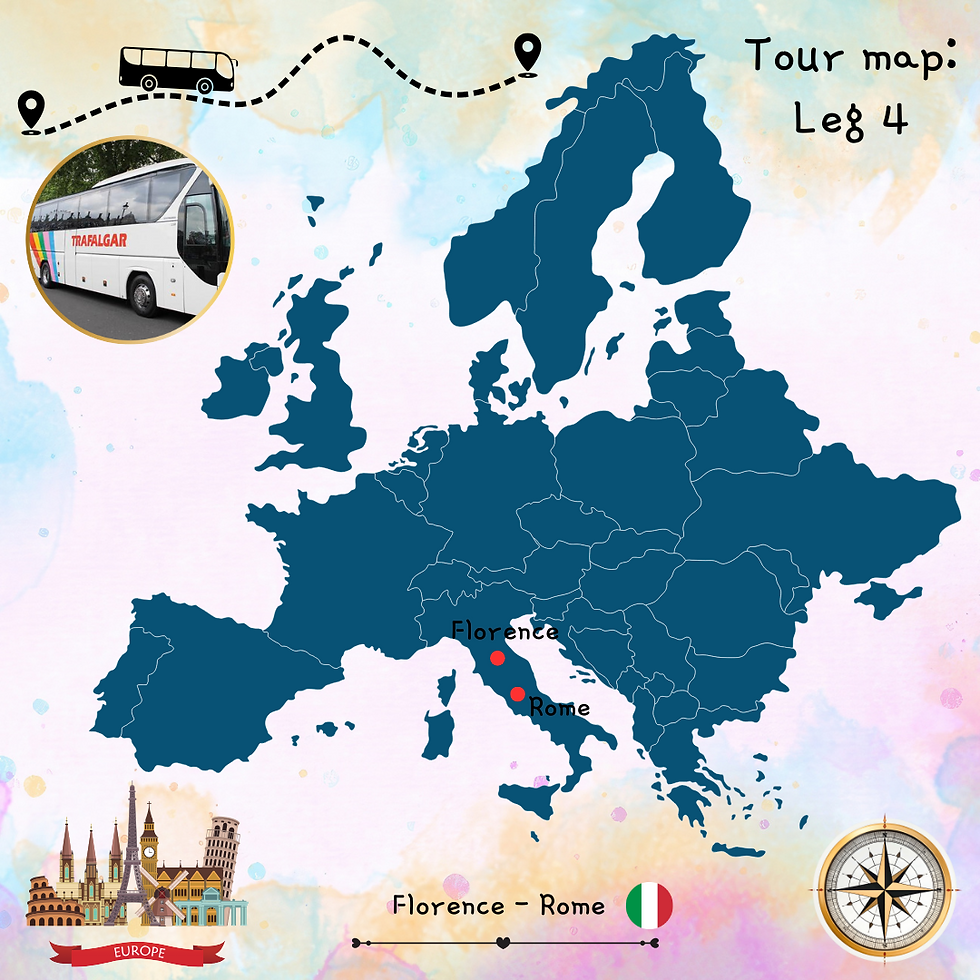
The journey from Florence to Rome is 275km, around three hours of travel. We arrived in Rome late in the afternoon to experience our first bout of hot weather. I remember we had a nap after the busy day and later chose to attend the optional extra dinner at Mino's restaurant in the city. The meal was huge - five courses including an entrée, two pasta dishes, a meat main, ice cream and fruit. There was traditional music to entertain us and serenading musicians. I remember the hot waiter who was kissing female diners on the cheeks and doling out flowers. It was completely touristy and over the top but we kind of just rolled with it. That said, I remember a bit of butt-pinching went on and that totally WOULD NOT HAPPEN today (at least, I hope/assume not!).
Earlier in the evening we'd stopped by the baroque Piazza Navona with its gorgeous three fountains dating back to the 1600s. So many fountains in Rome! (That's my anxiety on display in this photo. How could I be sad in the face of that beautiful fountain?)

After dinner we went on the evening tour around the city (illuminations tours, as Trafalgar love to call them), stopping for the traditional coin toss into the Trevi Fountain. D hit some random guy on the head with her coin! We drove past the Vatican and the Teatro di Marcello, an old theatre with apartments on top. European cities sure are pretty at night!
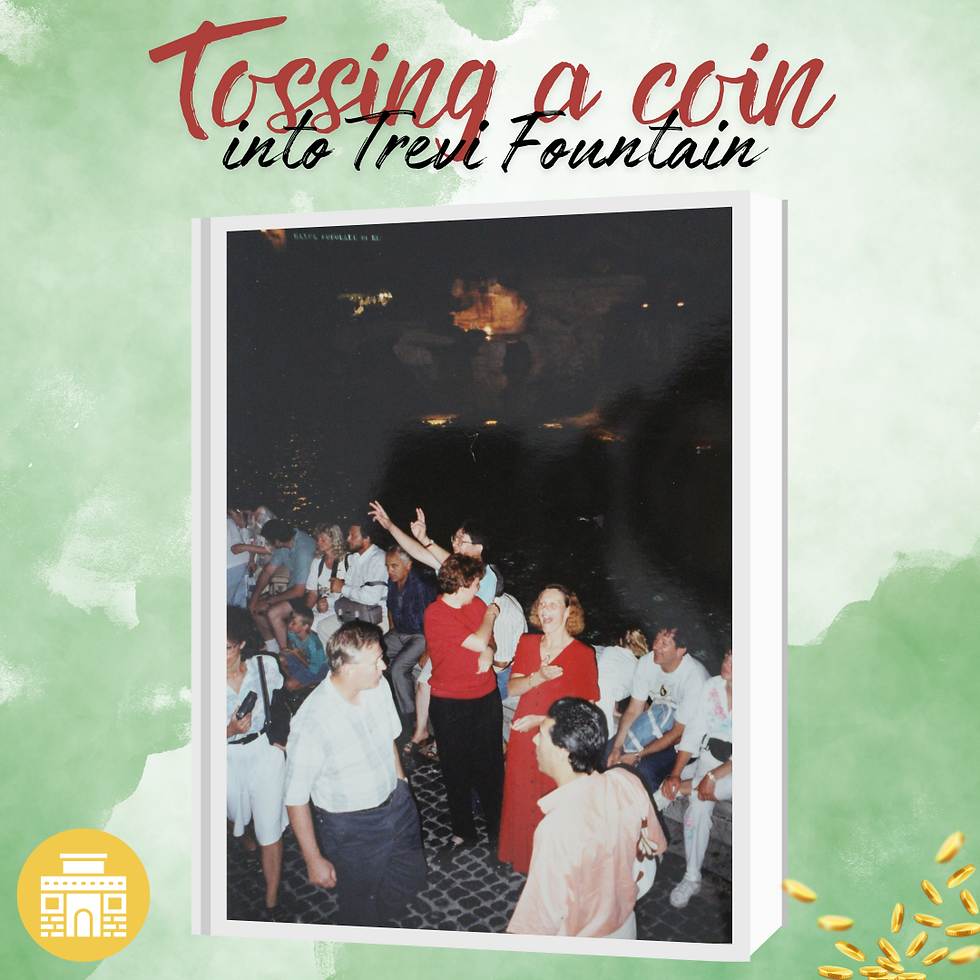
Did you know?ℹ️ The fountain was finished in 1762 after some years of construction. It is 20 metres wide and 26 metres high. The name comes from Tre Vie - three ways - as the fountain sits at the meeting point of three streets. Since 2007, around 1 million euros of coins are extracted from the fountain each year and given to charities. The myth of the coin-toss into the fountain originates from the 1954 film, Three coins in the fountain, and says that if you throw one coin, you will return to Rome; if you throw two coins, you will fall in love with an attractive Italian; and if you throw three coins, you will marry the person that you met. |
Here are some stunning shots taken by our daughter, E, on her trip to Rome in 2024, including the fountain early in the morning, sans people. Beautiful images!

The plan was to visit the Sistine Chapel the next morning (Day 8) and we made an early start to try to beat the crowds. There was a huge line up for the Chapel so we were shuffled away by our tour director who stuck to his mantra of "no queuing for Trafalgar travellers". Our visit to the Sistine Chapel was postponed until the following day as we had two nights in Rome.
Instead we met our local guide, Franca, a deliciously exuberant host, who helped us on our city tour. A lot of battling crazy Rome traffic and seeing things from the tour bus ensued. We drove past the AD 315 triple arches of Arco di Constantino, Trajan's Column (built in AD 113 with a statue of Peter added later to the top), and Castel Saint Angelo, the Castle of the Holy Angel, a papal fortress and prison. We crossed the Tiber River and saw the Garibaldi and Palatino bridges, and an excavation site at the Roman Forum. We also saw Tiberine Island, dedicated to the God of Medicine. The space was converted into a hospital in the 16th century and apparently you must be born there to be considered a true Roman. We swung by the Circus Maximus at Palatine Hill. I could just picture Charlton Heston riding along in his chariot. (These were pre-Gladiator days after all.)

I loved taking in all the history of the Roman sights but wished we'd had time to get off the bus to truly experience them. Again, this is the downside of a tour, and a whirlwind one like we did. You see a lot but you don't really see things.
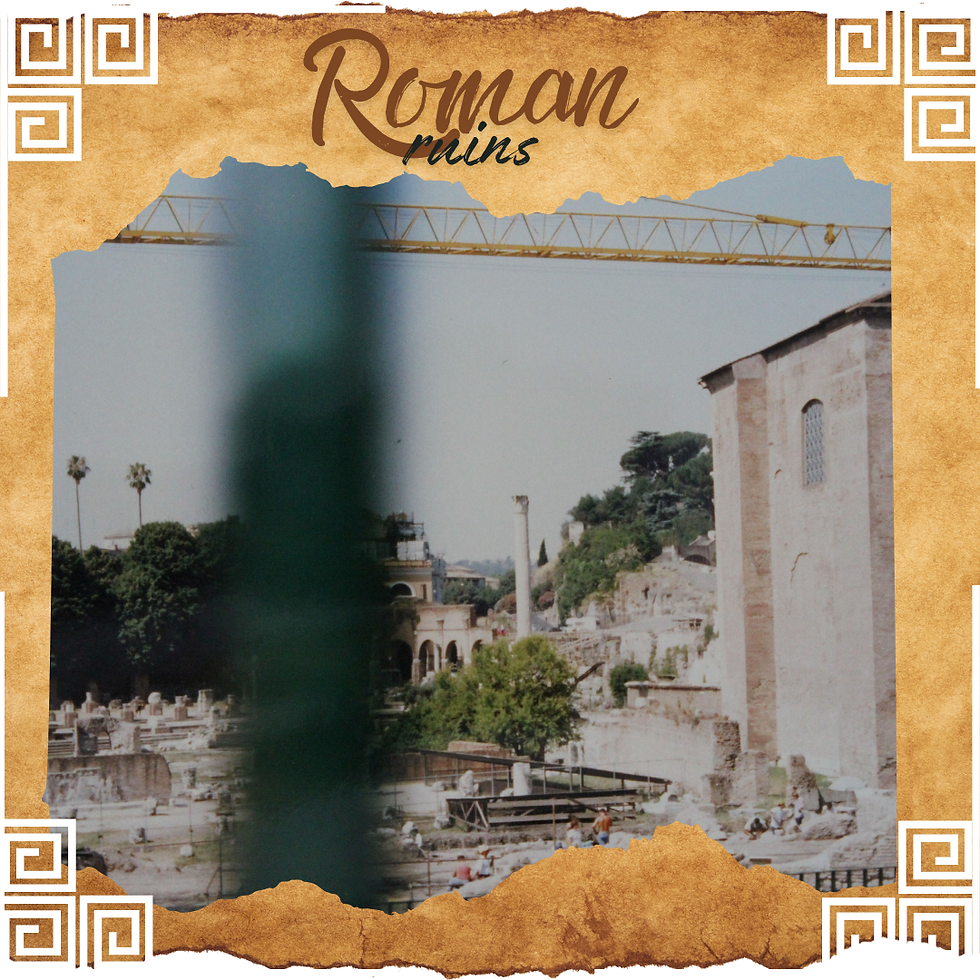
We did get off at the Colosseum. Yay! It was such a pinch-me moment to walk along the iconic structure but unfortunately for me, I needed a toilet break at that point in the day and spent most of our time there using the facilities. Oh, man. (No photos taken at the Colosseum, weirdly. I can't remember why not, other than my time being taken up finding the loo...)
I'm sure you know what the Colosseum looks like, but I've included this stunning shot of E's, with the ancient structure set against a brilliant blue sky.

We entered Vatican City mid-morning. The highlight of our whirlwind experience was our visit to St Peter's Basilica. The church is so ornate and at the time, one of the most magnificent sights I had ever seen. This time we were able to go inside where the church's beauty is even more evident. The basilica is huge, as is St Peter's Square, with its 240 metre wide space, Egyptian obelisk in the centre (brought by Emperor Caligula from Egypt in 1586) and the four-pillar deep colonnade.
The basilica was consecrated in 1626 and was built in Renaissance and Baroque styles. It is 220 metres long, 150 metres wide, and 137 metres high, with the capacity to seat around 20 000 people. Amazing! St Peter's Square (Piazza San Pietro) is also ginormous. I could imagine hordes of the faithful gathering to see the Pope, but during our visit it was peppered by a smaller crowd.

We tried to choose the optional tour extras carefully, to make sure we saw as much as possible with the limited time (and budget) that we had. Some of our fellow travellers seemed more keen on shopping so a bunch went off to do just that after our St Peter's experience. We elected to stay with the delightful Franca to see more of Rome. She was so enthusiastic about her home city and I loved the way she pointed out places of interest with what she called her 'magic wand', with its pink ribbon tied on the top.
Our first stop with Franca was at the Catacombs, the subterranean passageways used for burial between the second and fifth centuries. The dark and creepy passages, dating back to between the second and fifth centuries, led into Christian and pagan tombs inscribed with ancient symbols and graffiti. We loved it! Well old stuff is totally our jam.

There are more than sixty catacombs in Rome of hundreds of kilometres of underground passageways that hold thousands of tombs. Only five are open to the public; the one we visited as the Catacombs of San Sebastiano, 12 kilometres of tombs that are named after a soldier martyred for converting to Christianity. (Be sure to check out my 2022 Paris post once it's posted, as I visited the Paris catacombs on that trip. So cool.)

Franca then took us to the Pantheon. The temple dates back to AD 113-125 and has been a Catholic church since AD 609. Until modern times, the dome was the largest in the world, at 43 metres in diameter and 22 metres in height. I only have the below picture of the exterior and the dome isn't visible, but trust me, it's impressive!
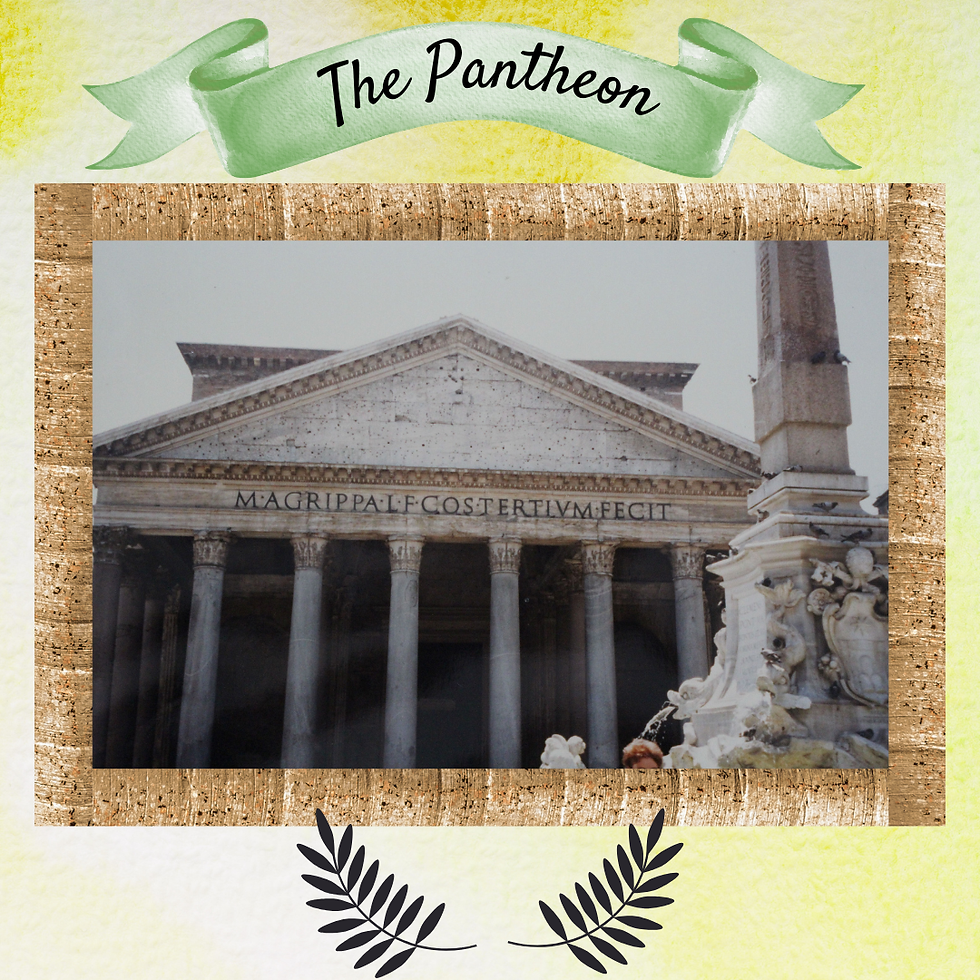
I remember the interior being simply magnificent, especially the shaft of light streaming in through the dome. There was a section inside that had been recently cleaned and the difference between that section and the remainder was so clear. As a history nerd, I just stood in awe of the building and the strength of its preservation over so many centuries.
This is a shot of the interior of the Pantheon from our daughter's 2024 trip. The dome is so beautiful, I just had to include this shot.
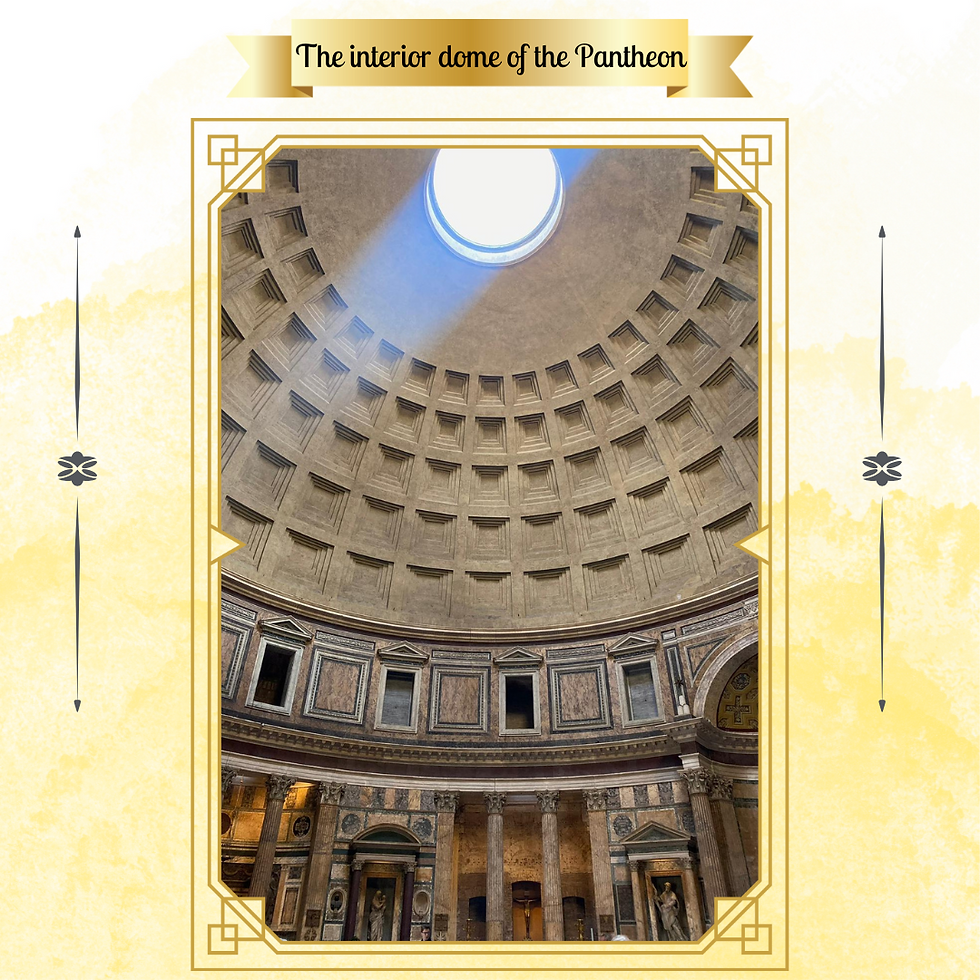
We had lunch in the square on which the Pantheon sits, trying to communicate with the server in a little sandwich shop. We also bought some delicious gelato but had to eat it super fast in the heat of the afternoon. Later we headed back to the hotel for a nap and then dinner in the hotel restaurant with T&D. We had pasta, of course!

The hotel (a Holiday Inn) was one of the nicest we'd stayed in so far quality-wise, but generic in comparison to the others we'd stayed in on the tour. The rooms were large and bright. The buffet breakfast was huge as well. We'd taken to filling up for breakfast and eating a small meal during the day, mostly fresh bread and fruit, as there was usually a substantial evening meal included. It stood out to us how much food our tour buddies were consuming as we travelled around. I don't know how they could fit it all those snacks and a big lunch as well as the hotel and restaurant meals. The amount of food on the tour was a bit overwhelming, actually.
Leg 5: Rome to Venice 🚌
Day 9 was spent returning to the Vatican then retracing our steps and covering half of Italy travelling to Venice. I was excited to have the chance to visit the Vatican Museums and the Sistine chapel. This tour was an optional extra and our Kiwi tour mates, T&D, opted to give it a miss. They got up early enough, though, to hang a happy birthday banner from their hotel balcony. It was my husband's 25th birthday that day. How cool to be turning 25 in Rome!

We were in the first group of people to enter the Vatican gardens that morning. We first walked around the Vatican courtyard and saw the huge pinecone and peacock, the Vatican symbols, and a hideous modern statue. The Vatican galleries were super impressive, with their ancient statues, tapestries and frescoes. You can see one of the galleries in the above collage of St Peter's. We peeked out the window and got a shot of the gardens (below), somewhere that tourists are not allowed.
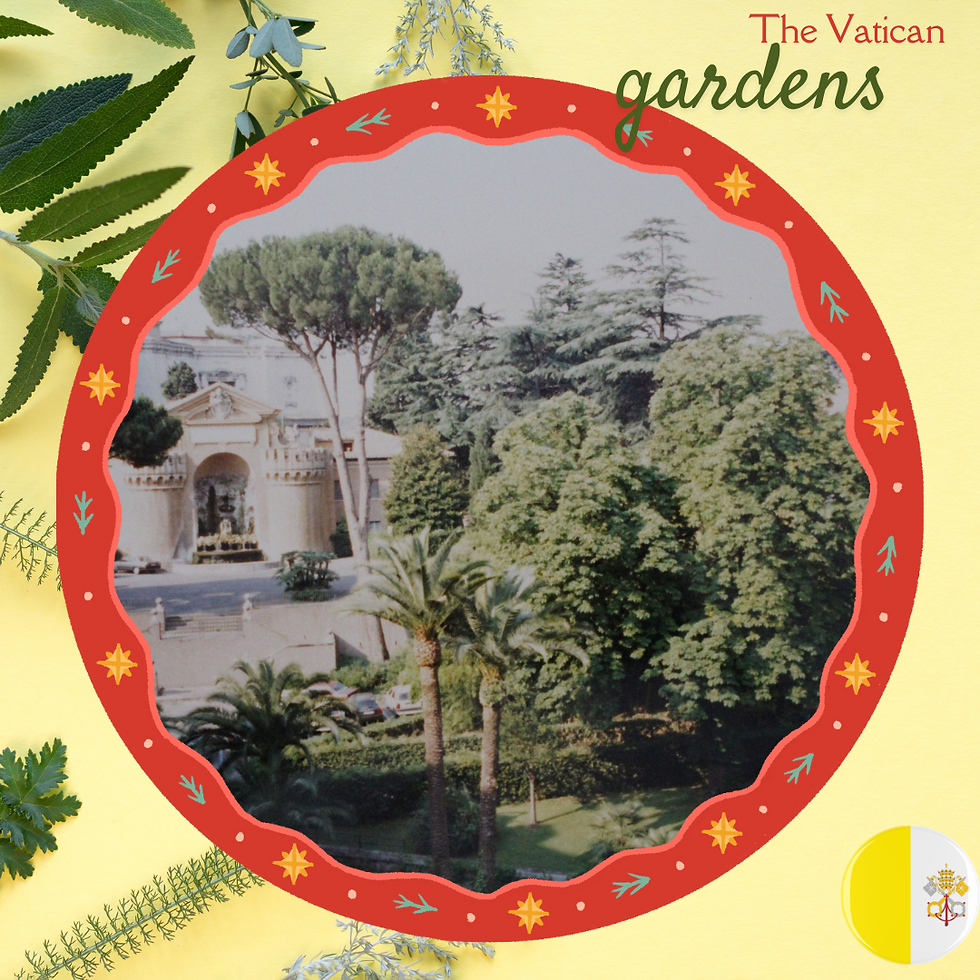
Later, we finally entered the Sistine Chapel. Franca showed up again to tell us about Michelangelo and the painting of the chapel. The ceiling is stunning, of course, but I was most surprised at how small the chapel was in reality, as somehow I'd expected something much bigger. It didn't help that the experience was wall-to-wall people. It was still incredible to see Michelangelo's work for real.

The wall frescoes date back to 1481, recounting the life of Moses and Christ. They were painted by Botticelli and Rosselli and others. Michelangelo painted the ceiling between 1508 and 1512, and it shows the Creation story and the Redemption of Mankind. The Last Judgement was painted on the end wall between 1536 and 1541. I couldn't quite believe I was there! I would have liked more time to take it all in, but we had to move on as we were leaving Rome after our visit.
On the way out of the chapel we had to go through the usual gift shop. We bought a print of the chapel ceiling (below) that still hangs in our home, from a nun behind the counter.
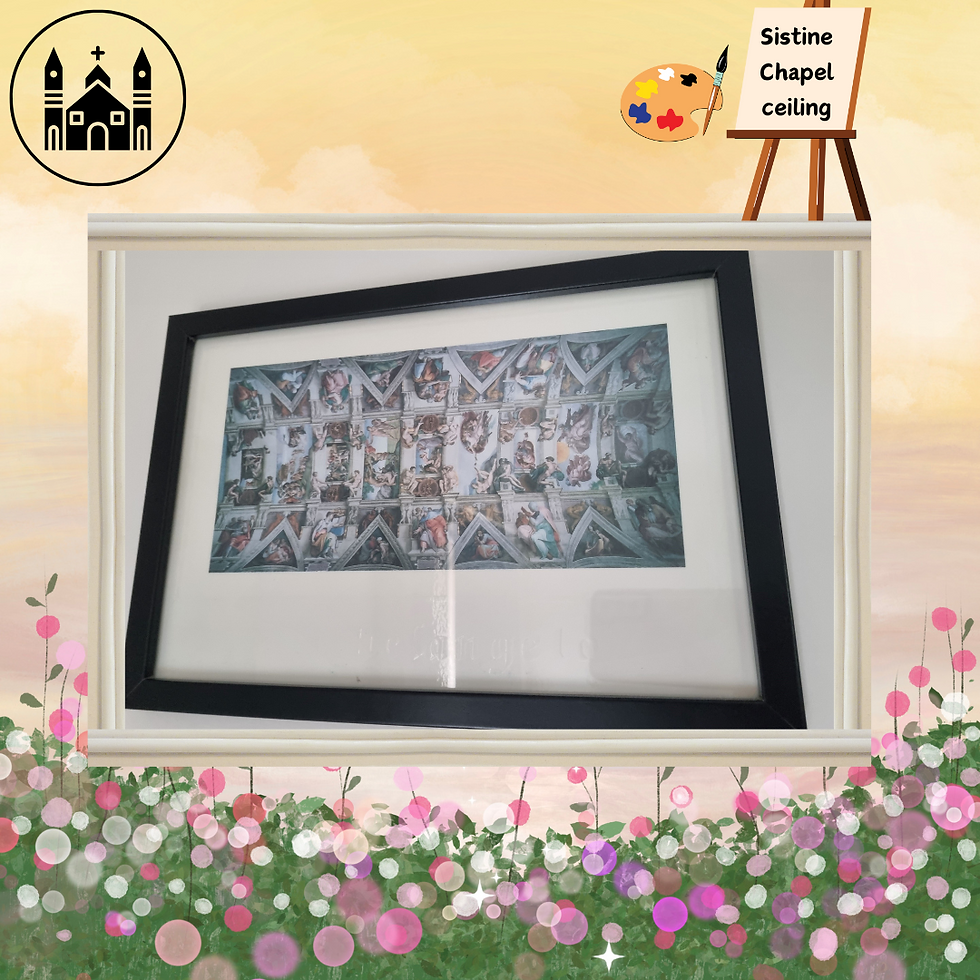
The rest of our day was spent travelling to Venice where we arrived around 5pm. We had to retrace our steps to Bologna then head across the Italian plain. Our hotel wasn't on the main island and some of our group complained about that, but we didn't care. The lobby was lovely and the rooms were clean. [I have no photos of the Venice hotel or of most of the other hotels we stayed in. I also didn't note in my journal the names of most of the hotels. Again, in the days before we snapped everything and could just "look things up"!]
Before we had dinner in the hotel, we went on the optional gondola ride. I mean, really, why was it optional? Who wouldn't want to do that? It was not the birthday experience we were expecting, though, as the gondoliers placed our group according to weight and we weren't able to sit together. I remember my terrible balance coming in to play as I tried to find my seat and the gondolier yelled at me in Italian until I sat properly where I was supposed to. Mortifying for a rule follower like me! It was a fun experience and a must-do, even if for us the weather was bleak and I found the canals were a bit smelly and dirty.
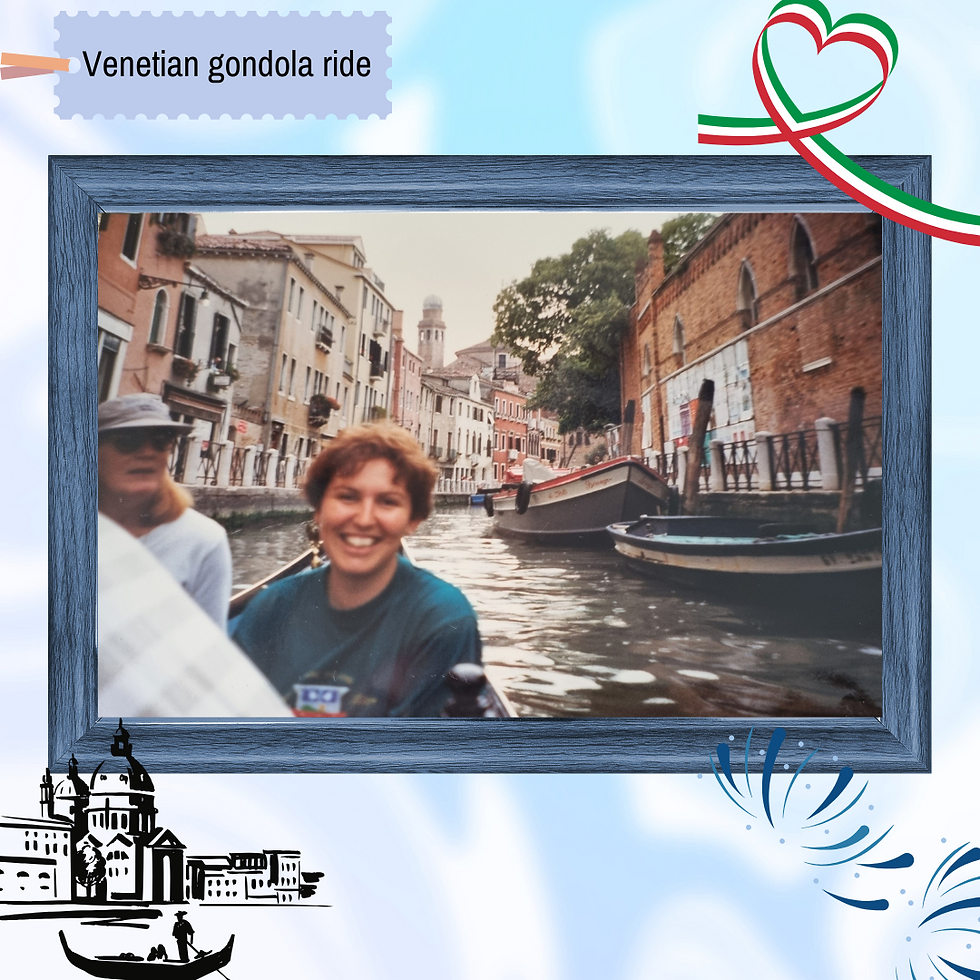
We awoke the next day (Day 10) to the news that our bus had been broken into the night before. Nothing was stolen but then we didn't leave anything on there at night. The main door was damaged and there was a huge crack across the front windscreen. Luc, our bus driver, was quite understandably upset, so he took off for the day and tried to see about getting the bus fixed.
We then headed off for our day in Venice, first travelling by launch to Rialto, the main Venice island. We went to a super cool Murano glass-blowing demonstration. Everything in the shop was beautiful but we didn't have to budget to buy anything. I was also worried about the glass breaking, whether we took it with us or mailed it home.
After the demonstration we had free time to wander around St Mark's Square and dodge the pigeons. It's a lovely square and all that, but Venice was my least favourite city in Italy that we visited. I think I found it dirty, even with the impressive basilica that dominates the square and the lagoon waters lapping the shore.
Here are some nice shots of St Mark's and the lagoon from our daughter's 2024 trip. E was lucky to have had better weather than we did even though our trip was in the middle of summer and hers was in spring.
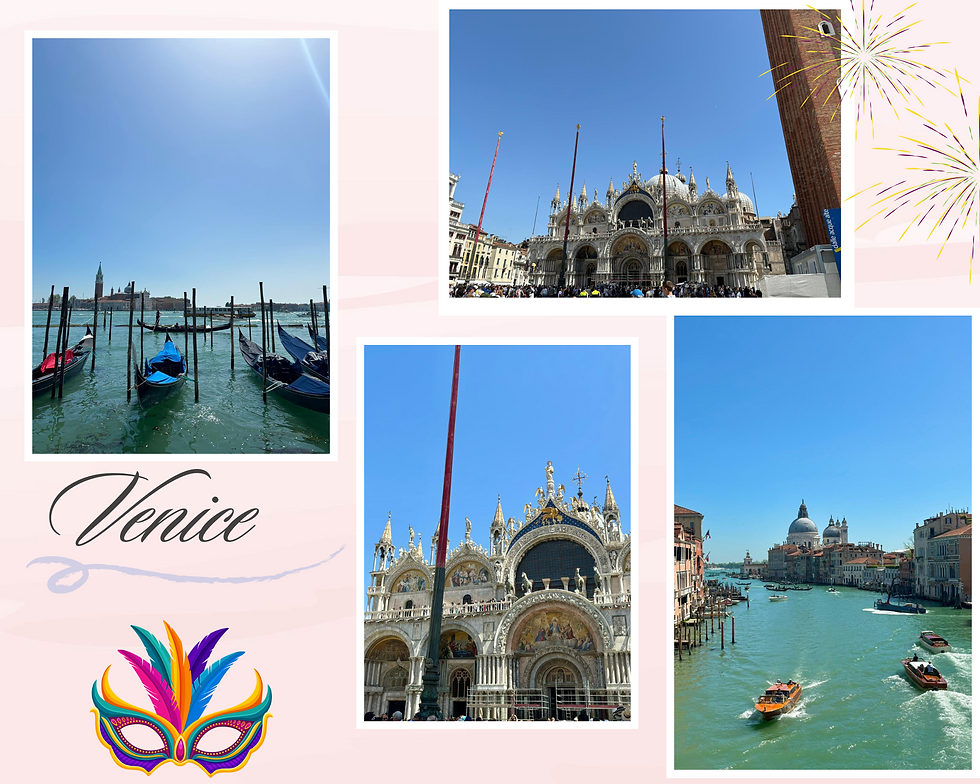
My photos are less impressive than E's, but hopefully you get the idea. You can see the Bridge of Sighs (bottom right hand photo). It joins the gothic Doges Palace to the New Prisons and is so named for the sighs to be heard from prisoners as they took their last look at freedom.

We opted for the additional tour in the afternoon to pretty Burano, one of the islands in the lagoon. I enjoyed the launch trip out into the lagoon as Venice looked lovely from out there, and being on the lagoon gives a different perspective on the city.
Burano is a quaint place, with lace markets, canals and bridges and houses painted in an array of colours. The weather warmed up and we had a lovely afternoon. It looks grey in my photos, but that's not how I remember it.
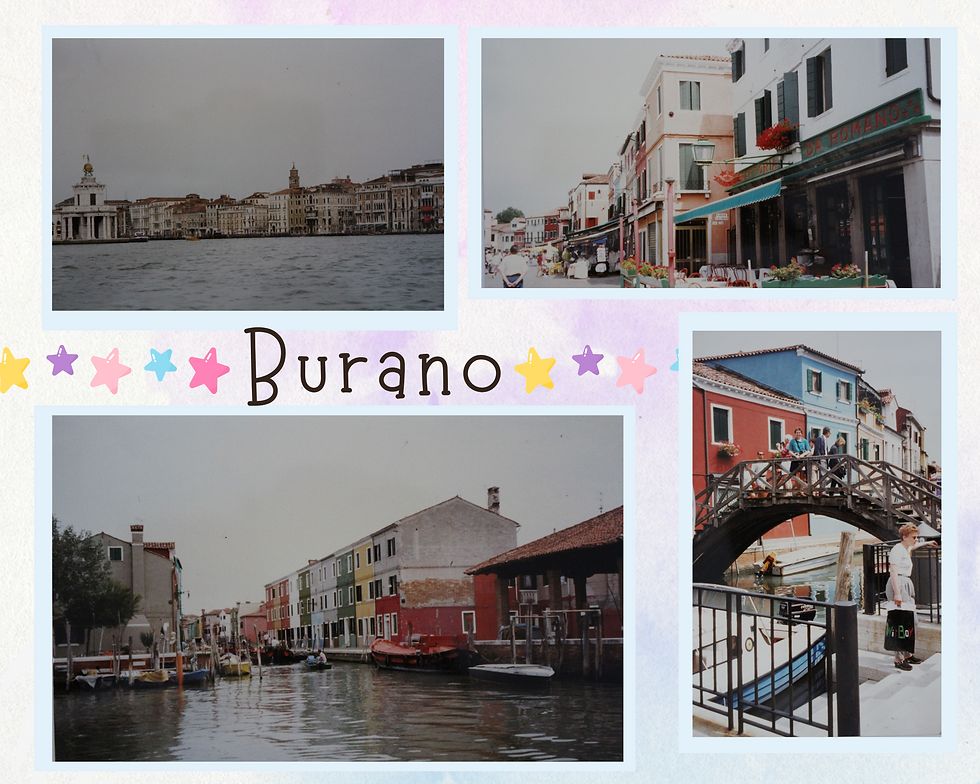
I wrote in my journal that we had a delicious lunch of pasta, seafood, fruit salad, and biscuits, and left full of food to wander around the markets. I bought a little lace umbrella that I still have kept as a nice reminder of the day.
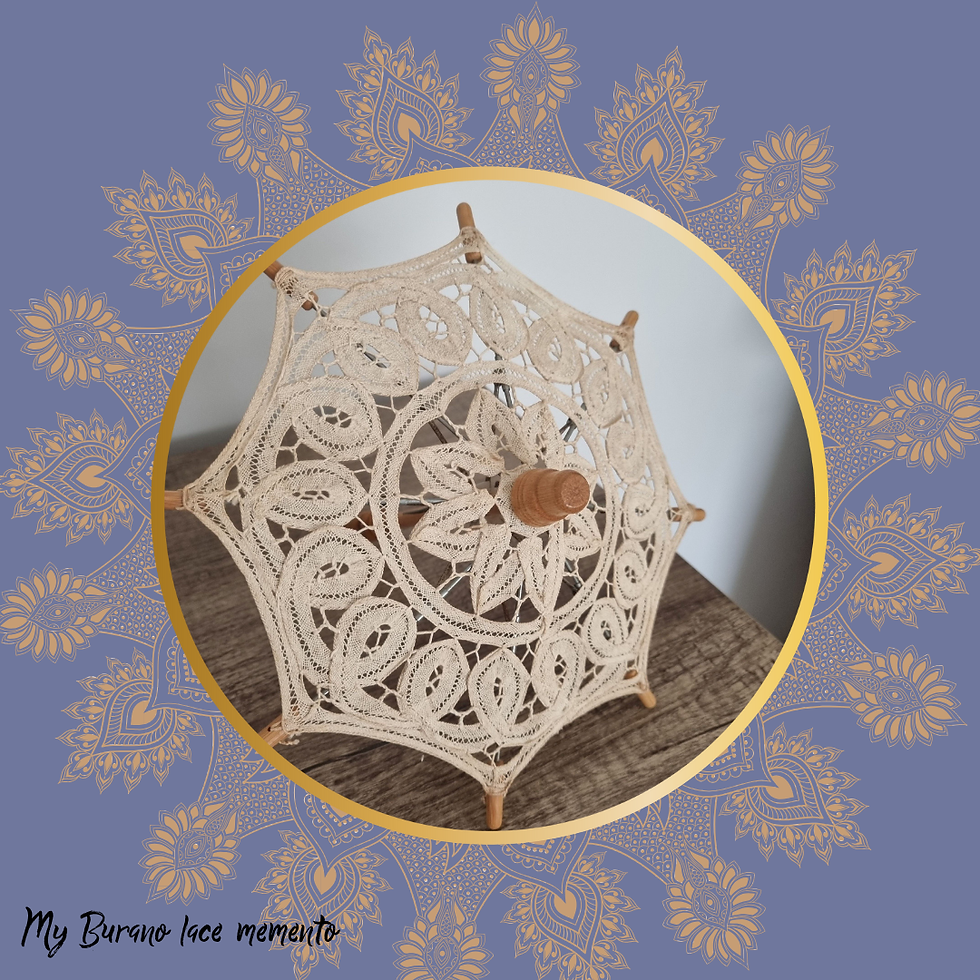
We waited for Luc to return with the bus once back at Rialto. He managed to get the door fixed but the windscreen stayed as it was. You can see the spider web pattern on the glass in the below photo that remained like that for the rest of the tour. It would prove to be a problem at one of our later border checks but when we drove through tunnels, the light hitting the pattern created a surreal image in the bus. I imagine today driving a tour group around like that would not be allowed!

Leg 6: Venice to Klagenfurt🚌
I am calling this part of our tour Leg 6, but it was really just a whip through Austria on our way to Hungary. We were late leaving Venice as a result of the broken door and window so it was late when we arrived in Klagenfurt after a 3-hour 285km journey from Venice.

We were supposed to stay in Villach, but I assume the late departure from Venice necessitated the change. Below is my only surviving photo of our brief stay in Klagenfurt, showing the hotel where we stopped overnight.
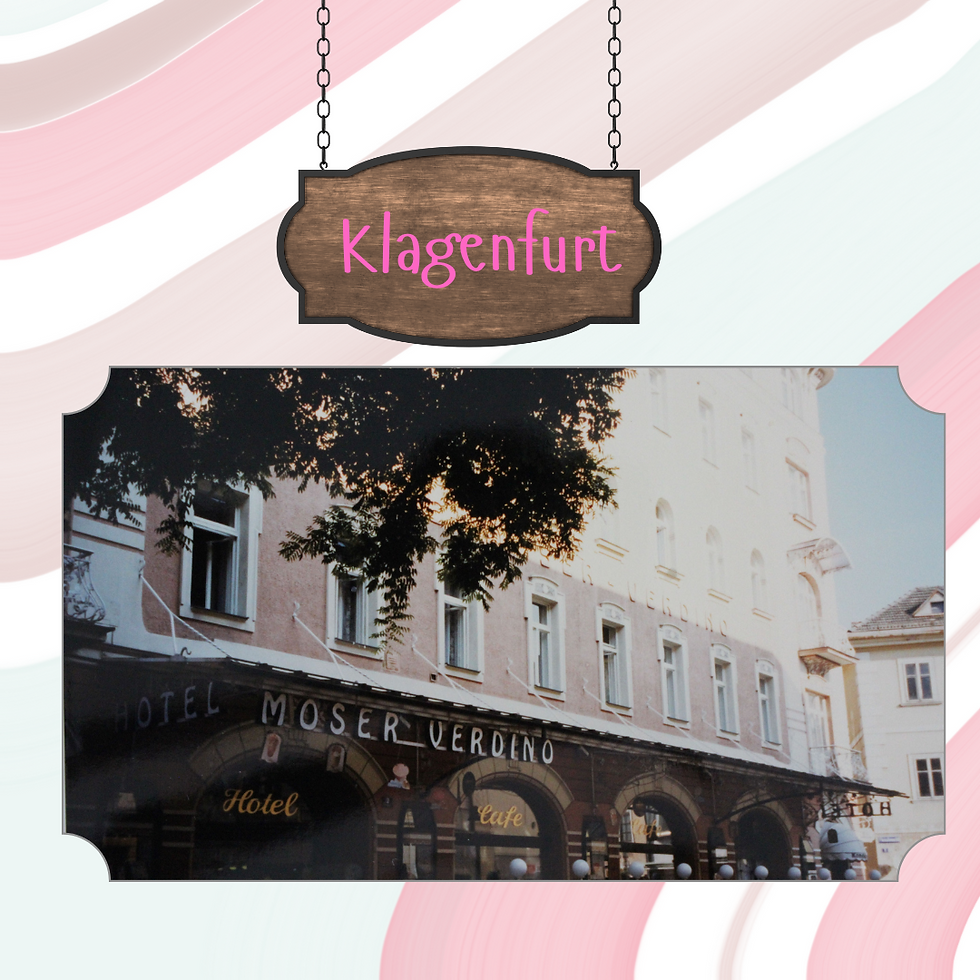
The drive into Austria was beautiful; so green, orderly and pristine after the chaos of Italy. Klagenfurt is a quaint town - so neat and tidy - and the hotel had lots of character. We went for a short walk to explore the town after another three-course dinner and headed to bed early as it had been a long day.
Leg 7: Klagenfurt to Budapest 🚌
We left Klagenfurt early on Day 11 to head to Hungary. We would return to Austria later in the tour, but for now, it was just a stopover of sorts on our way to Budapest. We stopped in the morning in Graz before making our way to the border. The journey from Klagenfurt to Graz is around 90 minutes (135km).

The below photo is the only one I have of Graz. I do remember that we spent most of our time searching for a loo and for films for our camera. Our search did give us the chance to absorb the vibe of the lovely, tidy town with its tram line in the centre. I recall buying the most delicious fresh bread and apricots for lunch as we wandered around.
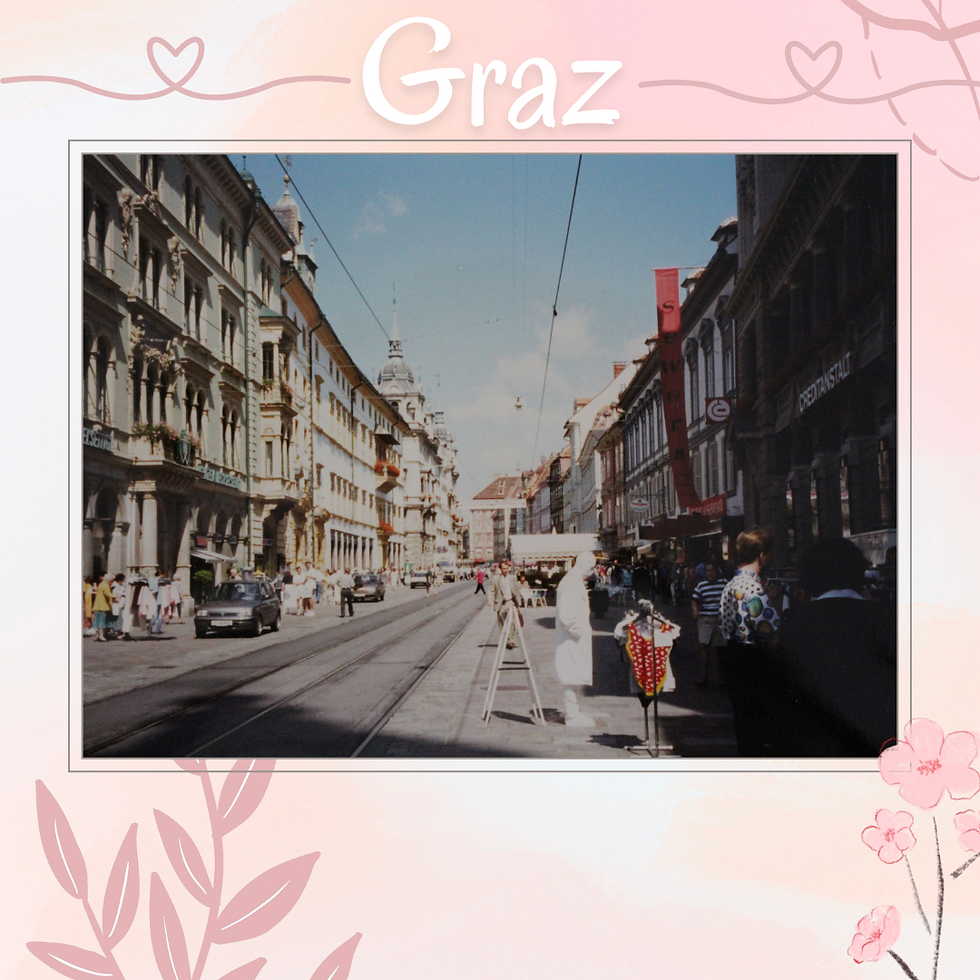
We drove past more mountain scenery and through little towns and endless tunnels on the way to the border after leaving Graz. The mountains in Austria were rocky and not as lush as the Swiss Alps but pretty just the same.
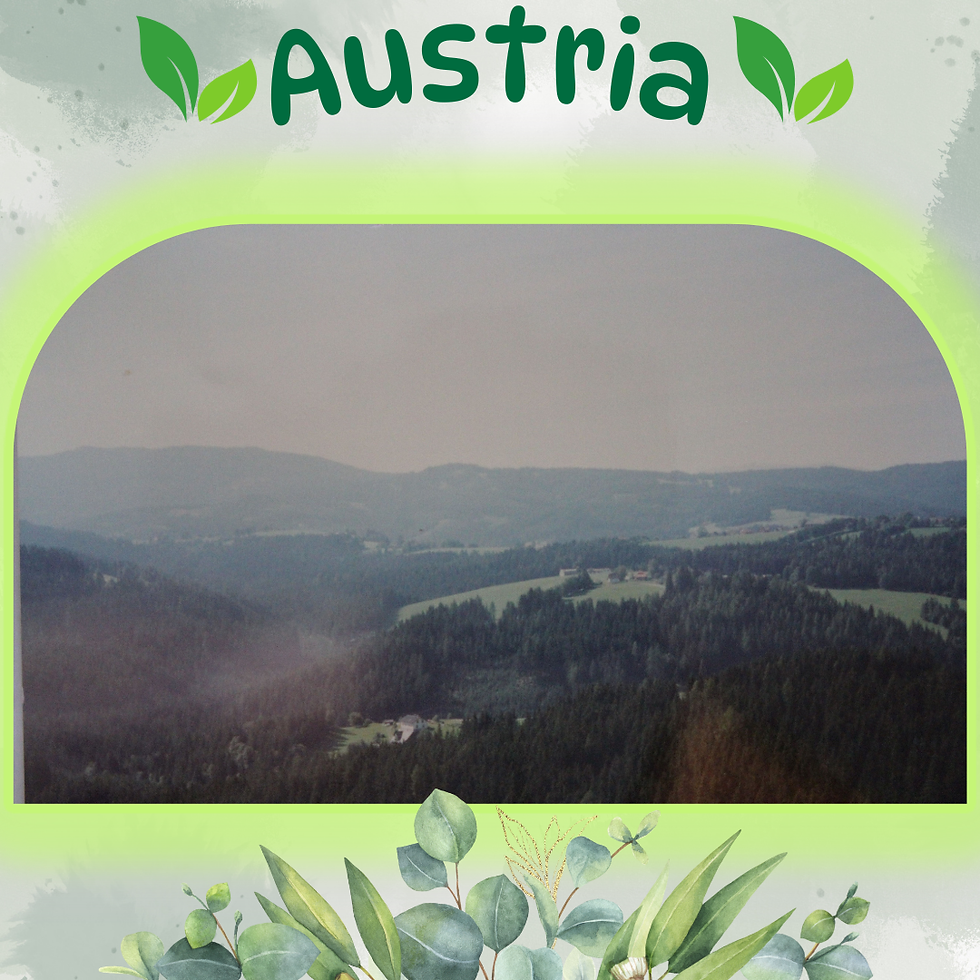
We had a slightly scary border stop on our way into Hungary as the guards came on board the bus to check and stamp our passports. Australians and New Zealanders had to have visas to enter Hungary back then. These were the days when when you had to send your passport to an embassy and have the paper visa affixed (see below). The guards took the passports, and we had to wait over an hour for them to return. When they did, they smiled at us the said "kangaroos". We smiled nervously back as they had giant guns on their hips and frightened the life out of us!
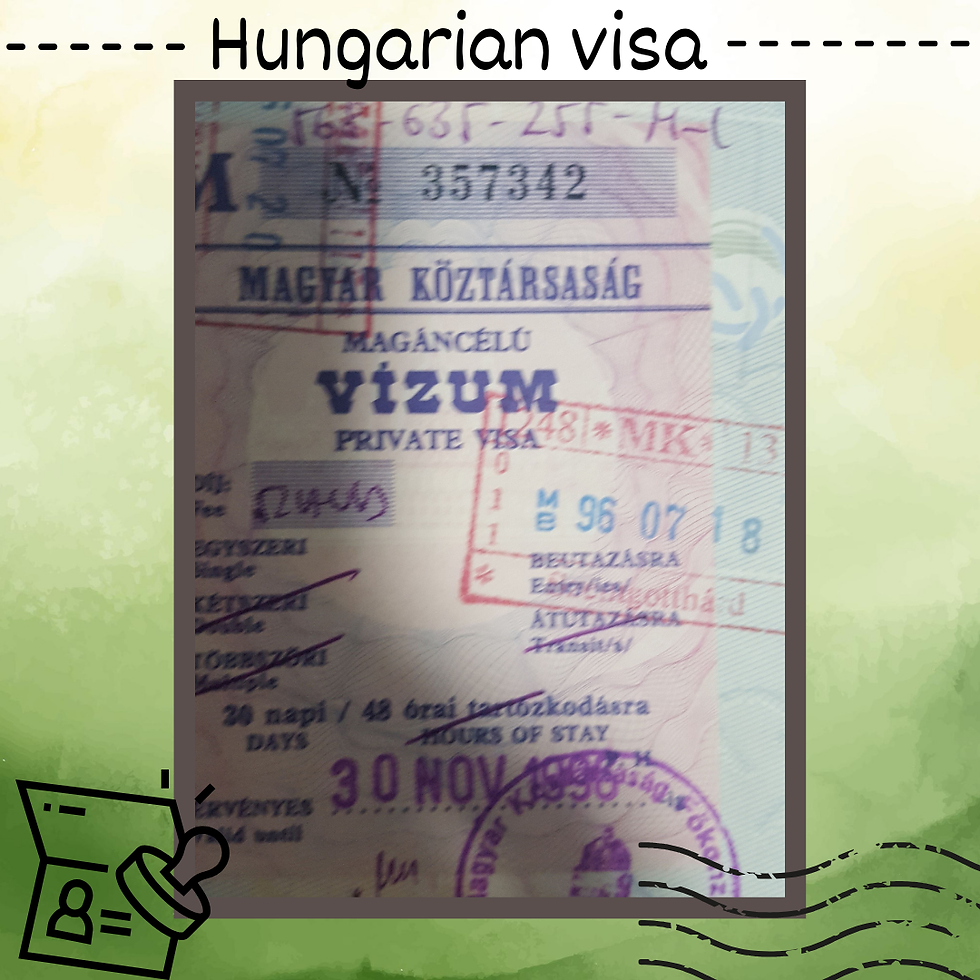
Graeme had told us all to stay on the bus at the border but people were hot and cranky by the time we were eventually waved through. The guards were not happy about the smashed window and initially demanded we had it repaired before they let us into the country. While we waited, the tour bus behind us gave the guards a bottle of wine and was let in without fuss.
My heart was beating fast after that encounter as nothing like that had ever happened to us before. We finally got through the border check and then Luc stopped the bus a few metres down the road so we could change currency. In 1996, you could not change money in former Eastern bloc countries outside of those countries as the currency was worth so little. We went into the little shop at the border - really more of a bar - and bought a Pepsi for the equivalent of 50 cents. It was so cheap in Hungary in those days.
The drama continued only a little way down the road. An unmarked police car pulled us over for allegedly speeding. I recall that Graeme paid the guards the (equivalent of) $20 'fine'. Graeme showed us the paperwork he received. It was like a raffle ticket you'd buy in a pub! Graeme and Luc feigned ignorance so we could move on without too much drama, advising the Hungarian couple on our tour who lived in Melbourne to sit quietly when they offered to translate. Those from our group who were sitting in the back of the bus told us later that the had spotted the police following us for some time, pointing and laughing at the bus. I guess foreigners then were something of a novelty and an easy target, and we certainly stood out with our brightly-coloured bus and spider web pattern on the broken front window. Graeme said the guards would probably take their families out to dinner on the money he gave them as $20 would have gone a long way in Hungary in those days.

It was a long journey to Budapest, around 4 hours all up from Graz (400km). The journey was a great opportunity, however, to roam around the Hungarian countryside and experience the simple, undeveloped rural parts of the country. We stopped at Lake Balaton, the largest lake in central Europe, before arriving in Budapest late in the afternoon.

We had a wonderful view of the sparkling Danube River as we drove into the city. I was keen to see what Budapest was like, in our second experience after Berlin of a former communist city. I am not sure what I expected - something less developed perhaps - but Budapest looked more like other European cities we'd been to than I thought it would, complete with American fast food places everywhere. Our hotel was rather flash, too, with its huge lobby and views of the city (and the women dancing in the window of the nightclub across the street...). Our lovely hotel dinner included goulash.
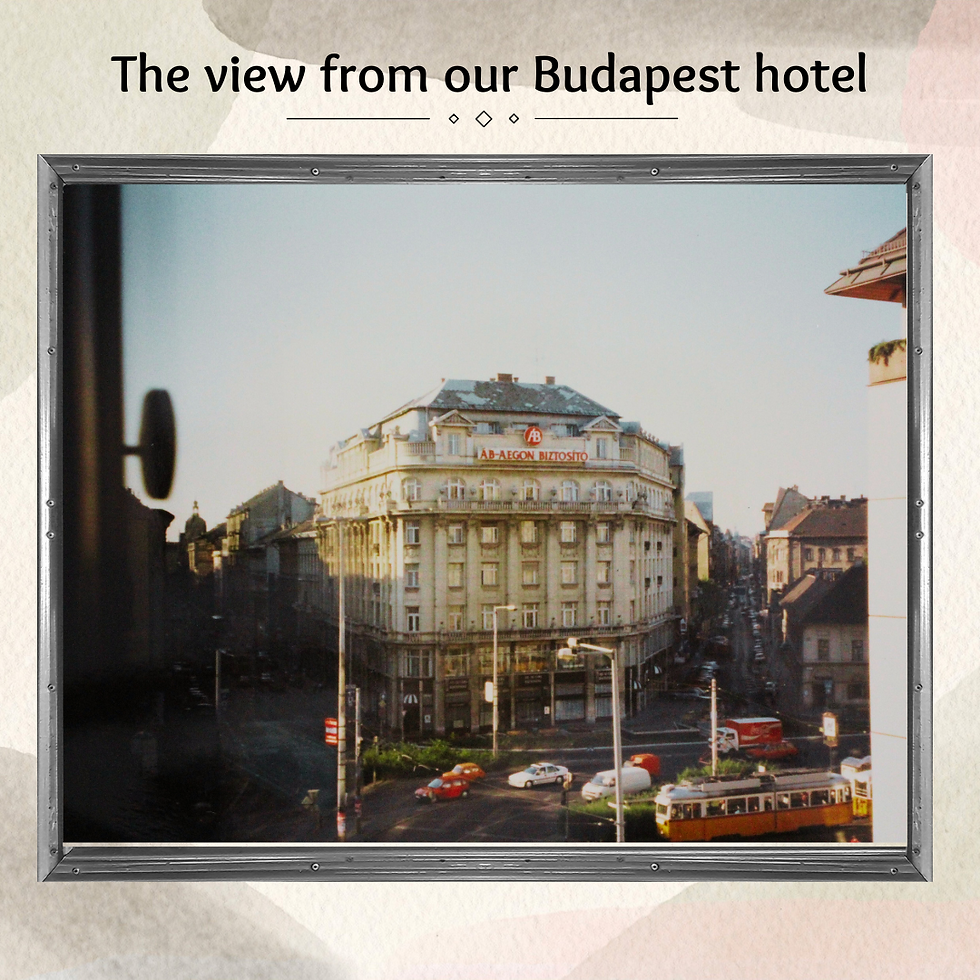
We had a call from a friend at home that evening who had been trying to reach us in Italy for my husband's birthday. I wrote in my journal at the time that our mobile must not have worked in Italy, but I don't recall much about how mobile phones worked in those days. I am surprised we even had one! It was not a smart phone, of course. Her voice sounded far away and it was strange to hear something familiar in an unfamiliar place. She said we sounded tired. That's because we were! Whirlwind tours like the one we were on are not for the faint of heart!
Day 12 saw yet another massive buffet breakfast before we were whisked away for a city tour. Our guide was Erika. She was a lovely woman, easy to listen to with a great sense of humour. I fell in love with Budapest instantly and would love to visit again to experience the city further. There is something unique about it - the river, the stunning architecture, the relaxed vibe, and the unique Buda and Pest sides to the city.
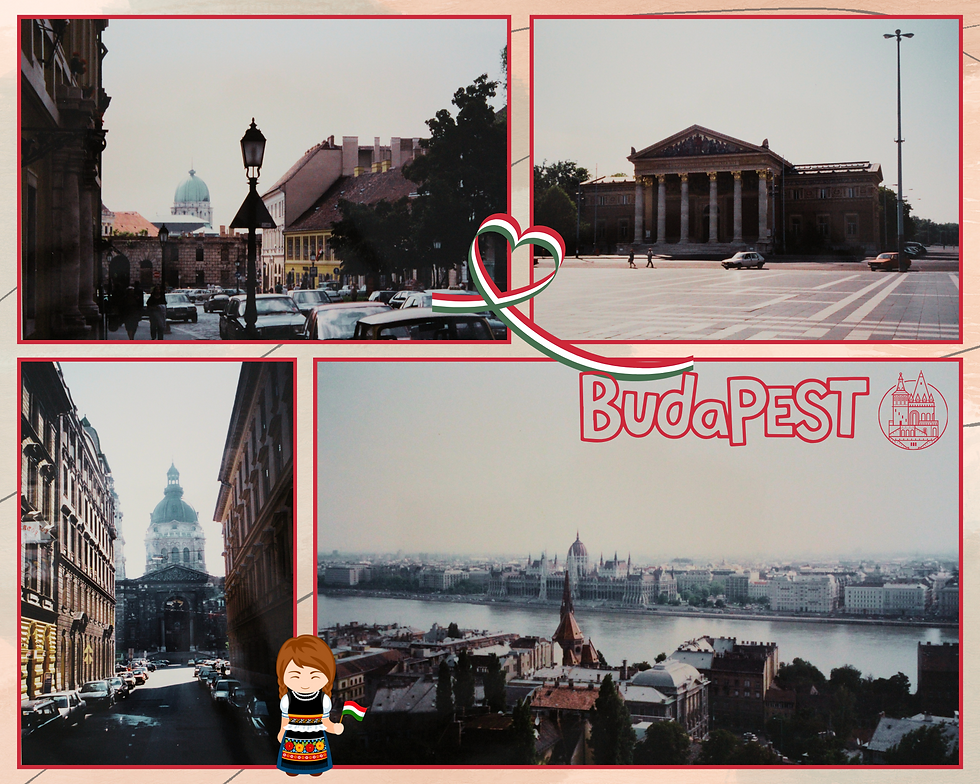
We drove around the city to take in the vibe then stopped at the ginormous Heroes' Square, where we were accosted by book and postcard sellers. Capitalism was alive and well, sadly. The square is a Millennial Monument containing a semi-circular colonnade with the Archangel Gabriel on the high column and carved statues of the Seven Magyar Chieftains who contributed to the founding of Hungary in the ninth century. In front of the monument is a cenotaph bearing a motto in memory of those who died for Hungary's freedom and independence.
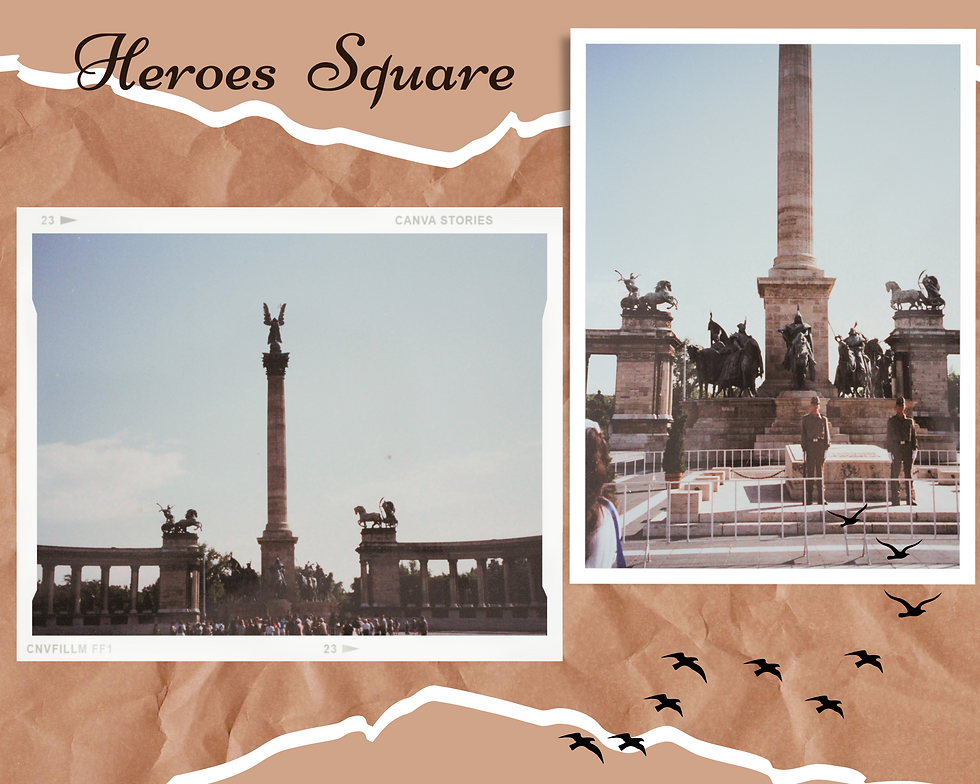
Our next stop was Fisherman's Bastion, a lookout tower near Buda Castle that affords panoramic views of the city. The original walls were built in the 1700s as part of the castle, protected by the guild of fishermen who lived under the walls. The current structure was built between 1895 to 1902. The main façade that sits parallel to the Danube is 140 metres long.

We had a poke around in Matthias Church (Church of the Assumption of the Buda Castle) with its beautiful stained glass windows. The Catholic church is thought to have been first built in 1015 and restored in the late 19th century. That's the church in the bottom right hand photo above.
Then we wandered around Holy Trinity Square where I bought the handcrafted wooden trinket box from a market stall that you can see here. I still have the box at home and it's one of my most treasured mementos.
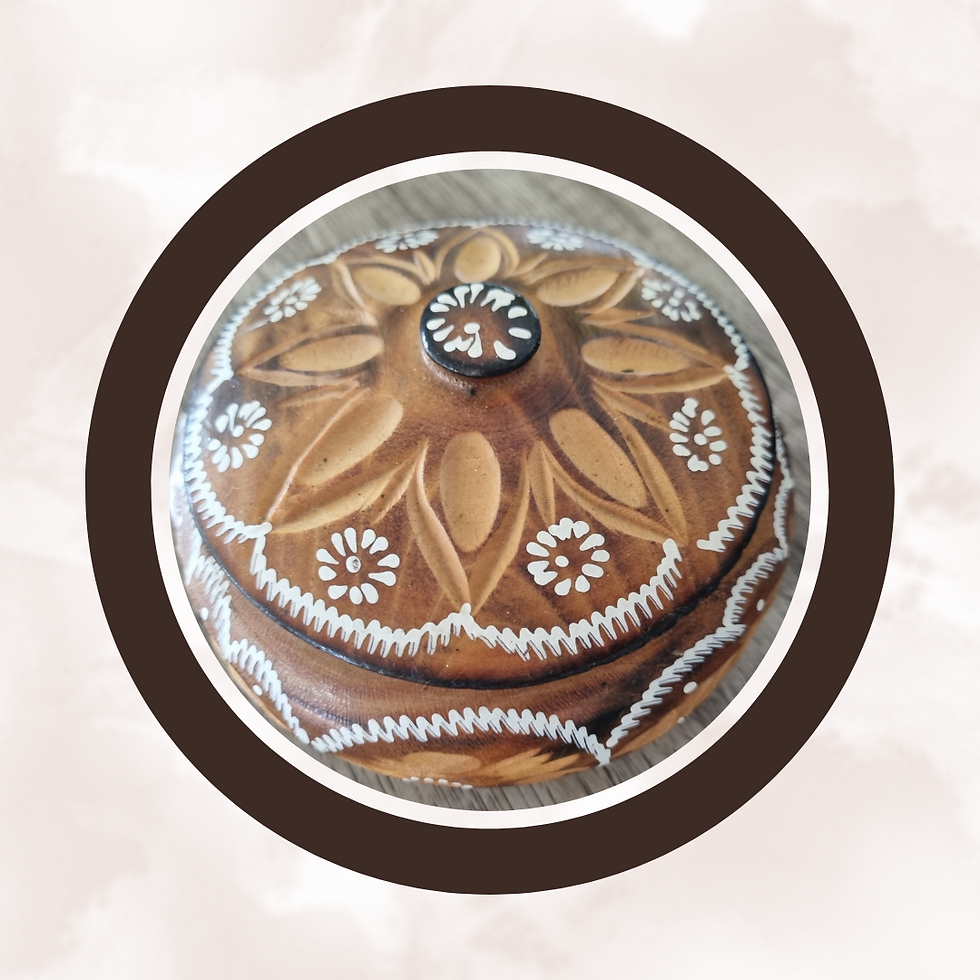
There were buskers playing traditional music as we wandered along the lookout and a strange elderly woman singing in the church. It was a rather surreal experience as we'd never been to such a place before. I loved it!
Fisherman's Bastion is one of the most spectacular parts of the city, I think. The views are stunning. This crummy photo, taken on our now-ancient camera, does nothing to capture the beauty of Budapest and the views from the Bastion, but this is where I fell in love with the city. I would return in a heartbeat and hope to do so one day.
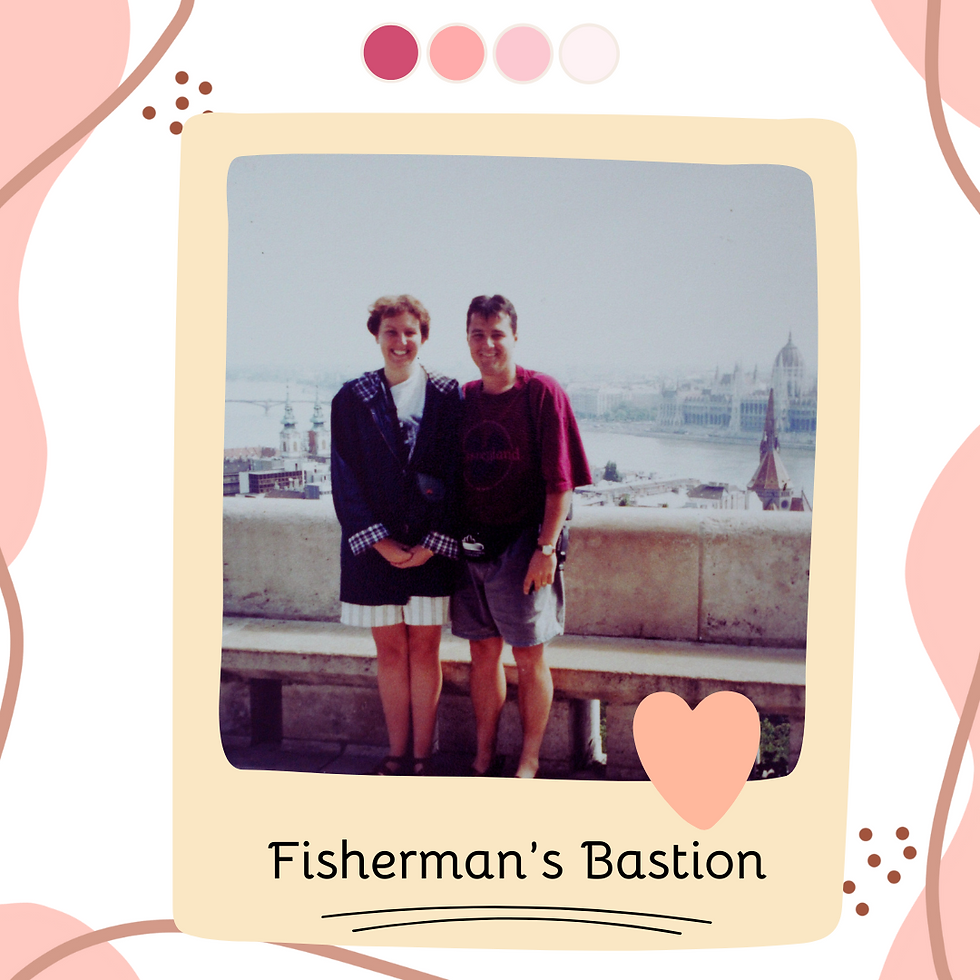
We spent the afternoon on an optional tour to visit the Hungarian Open Air Museum. The museum is modelled on the Swedish concept of skansen, meaning an open-air collection of historic structures (essentially a museum of buildings). The Hungarian museum was founded in 1967 and is Hungary's largest outdoor collection, showcasing Carpathian folk architecture. We loved the museum as the houses were beautifully set up to show what life was like in medieval times, compete with furniture and everyday tools and implements.

The museum is next to the quaint village of Szentendre with markets of handcrafted goods. We saw so many beautiful things and I have always regretted that we didn't buy something that day. We had a lovely (but massive) traditional Hungarian lunch then and climbed up a set of narrow stairs for views of the town and the Danube.

We had missed the free time to explore Budapest but we didn't regret our choice to go to the museum as we'd had a lovely afternoon. That said, I'm sure we only scratched the surface in the during our time in Budapest.
In the evening we did the 'illuminations tour'. Remember that is Trafalgar-speak for driving around the city at night. It's very cool, though as European cities are magnificent at night, with the bridges and ancient buildings all lit up. Part of our evening illuminations tour was a cruise on the Danube, one of the highlights of the whole trip.
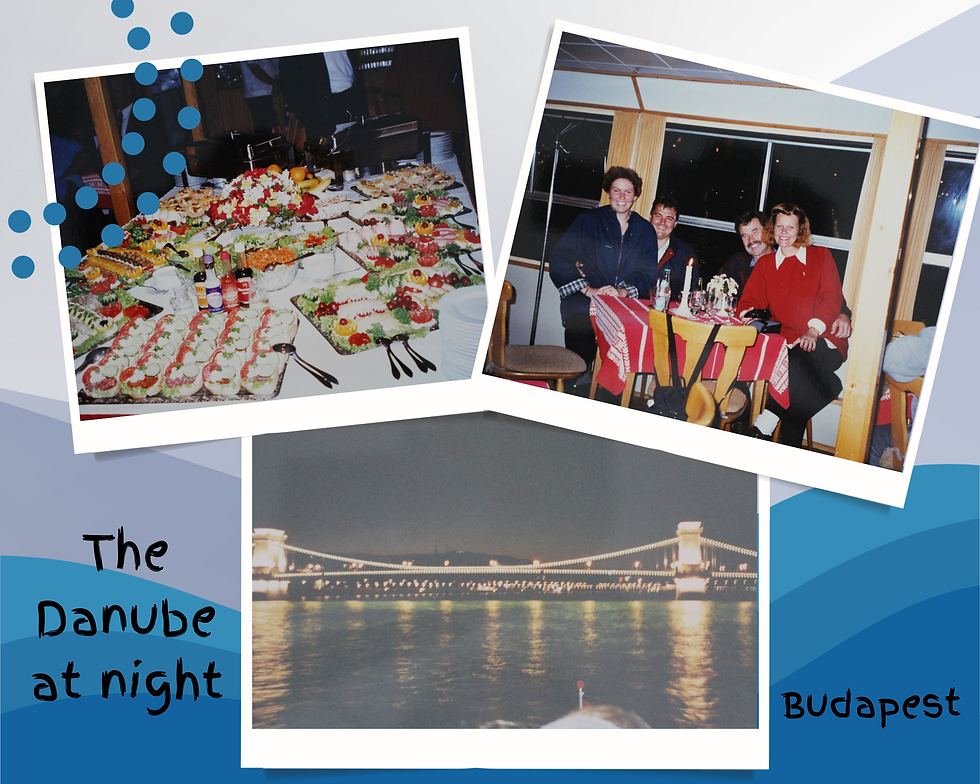
The terrible photos from my old camera do not do the river justice. It was stunning at night and we had a lovely evening. The traditional Hungarian buffet dinner was the boat was enormous, much of the food new and unrecognisable to us. It was super windy on the boat deck where we spent most of our time, hence my crazy hair in the photo above!
The next morning (Day 13) we opted for the optional tour to see the neo-gothic parliament building and Margaret Island. The Hungarian Parliament Building sits on Kossulth Square on the Pest side of the city on the eastern bank of the Danube. It was opened in 1902 and has been the largest building in Hungary ever since. It has a symmetrical façade and a central dome and is symmetrical inside, with two identical parliament halls on opposite sides of the building. We were fortunate to be able to see inside, to experience the beautiful elaborate wooden carved ceilings, frescoes and statues of Habsburg emperors.

Margaret Island lies in the middle of the Danube and is a beautiful landscaped recreation park with medieval ruins of past churches and nunneries. We went on a horse and carriage ride (see above photo) around the 2.5km long and 55m wide island, tried the medicinal waters from the island's mineral spas, and tasted a traditional Hungarian fruit cake (more like a cheesecake than what we know as a fruitcake). The island is named for Saint Margaret (1242-1270), King Bela's 11-year-old daughter who was sent to the convent that was established on the island. The island was originally called Rabbit Island in the middle ages as it was a royal hunting reserve. During the siege of Budapest during World War II, the island was the site of combat with advancing Soviet troops.
Our Hungary experience💭Hungary was one of my favourite countries of the tour. There were plenty of vestiges of the Communist regime evident and I liked that we were able to visit in the early days post-fall of the Iron Curtain. Our guide, Erika, was open and honest about life in Hungary and the economic challenges the country faced as it emerged from its communist history. Capitalism, although in its infancy, was alive and well, and there were sellers everywhere to tempt tourists to buy stuff, and American fast food restaurants on every corner. At that stage, the local currency was not worth anything outside of Hungary and there was a huge demand for foreign currency, so shops and sellers would accept just about anything as payment. Budapest had a relaxed vibe and I loved the architecture and the stunning Danube river. The countryside was pretty, with sunflowers everywhere, although the rural areas were quite undeveloped. |
Leg 8: Budapest to Vienna🚌
We entered Austria again with a relatively problem-free border crossing from Hungary after leaving Budapest late on the morning of Day 13. I do remember the young Austrian border guard, though, with a huge gun on her hip checking our passports as we passed through. We travelled 245km that day, from Budapest to Vienna via Gyor, around a 3-hour journey.

Our final stop in Hungary was in the town of Gyor, close to the border with Austria. Gyor is a lovely medieval town with an ancient vibe. I have a general memory of the town but recall that it was really only a pit stop so we could get lunch. We didn't have much Hungarian currency (forint) left so we pooled our money with tour buddies, T&D. We managed to scrape together enough for a burger each and a drink at McDonald’s. There were some language barriers, but we twigged that one of the servers spoke enough English for us to bumble through our order.
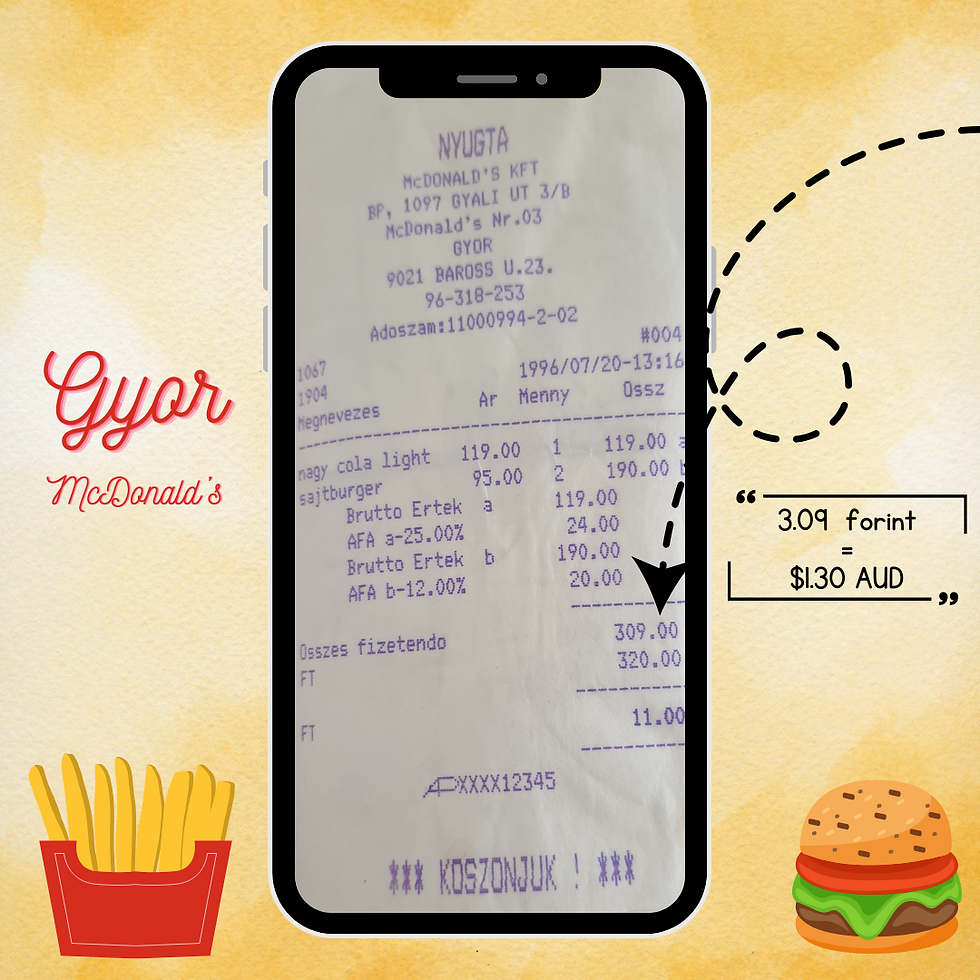
For some odd reason, the McDonald's receipt survived but I have no photos of Gyor! Check out this blog post by Kami if you want to read about Gyor.
We arrived in Vienna mid-afternoon and checked in our gorgeous hotel, the Parkhotel Schonbrunn, the former guest house of the Emperor Franz Josef. The hotel was originally a rest stop, opened in 1787 and expanded into an inn in 1823.
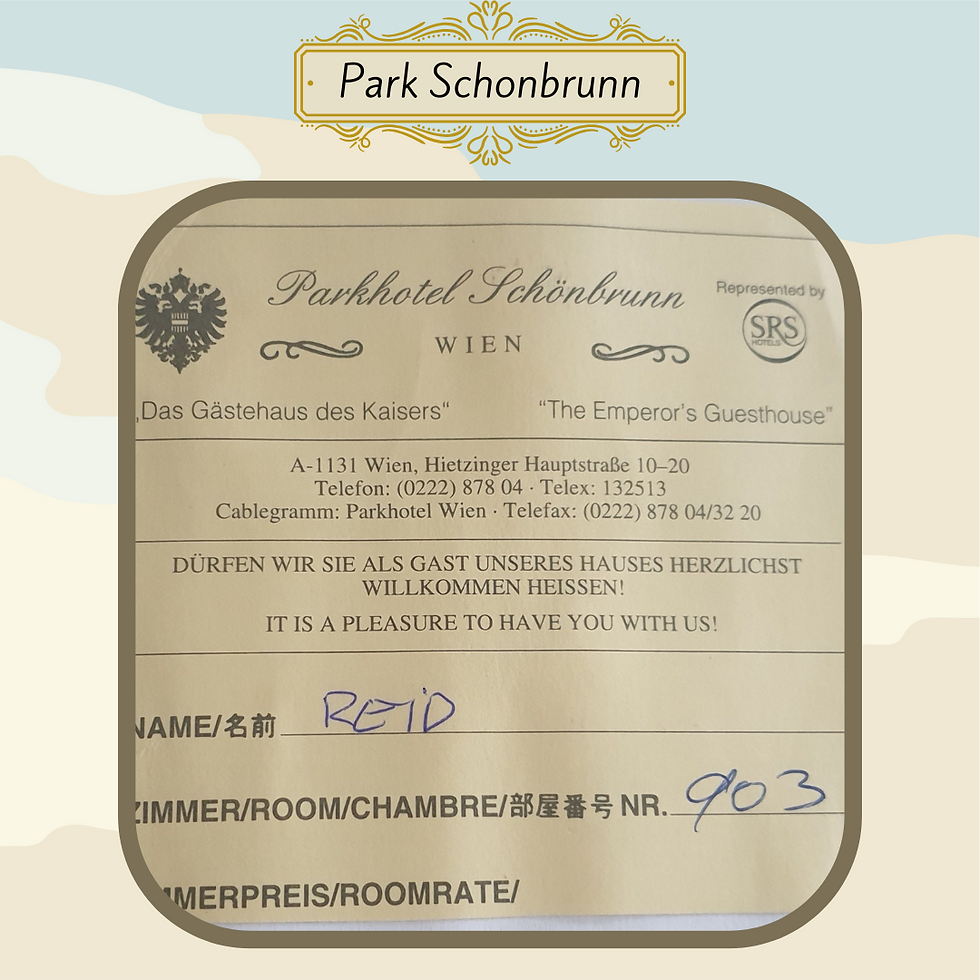
The hotel has a massive reception area, complete with chandeliers. Our room was filled with antique furniture. Many of the Emperor's guests stayed in the hotel, including Thomas Edison in 1911. It was used as a military hospital during WW2 and an officers' mess for the British occupation forces until it reopened as a hotel in 1954. The hotel was modernised and expanded in 2010 but we had the benefit of staying in the older version in 1996. How cool is all that?
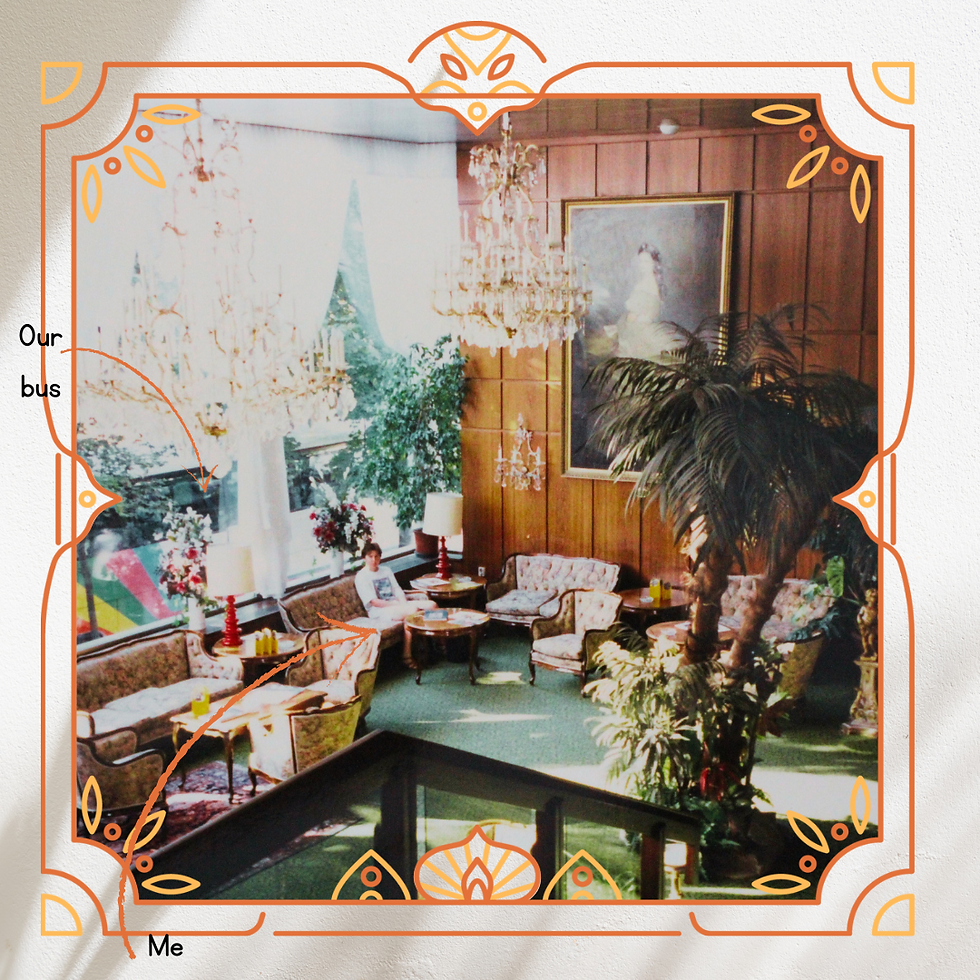
There was an evening excursion that included two places of interest and dinner. The first place we visited was the Fischer family distillery, the Old Vienna Schnapps Museum (Alter Wiener Destillerie), a family business since 1875. Their front office is resplendent with antique furniture, apparently used in some scenes in Schindler’s list.
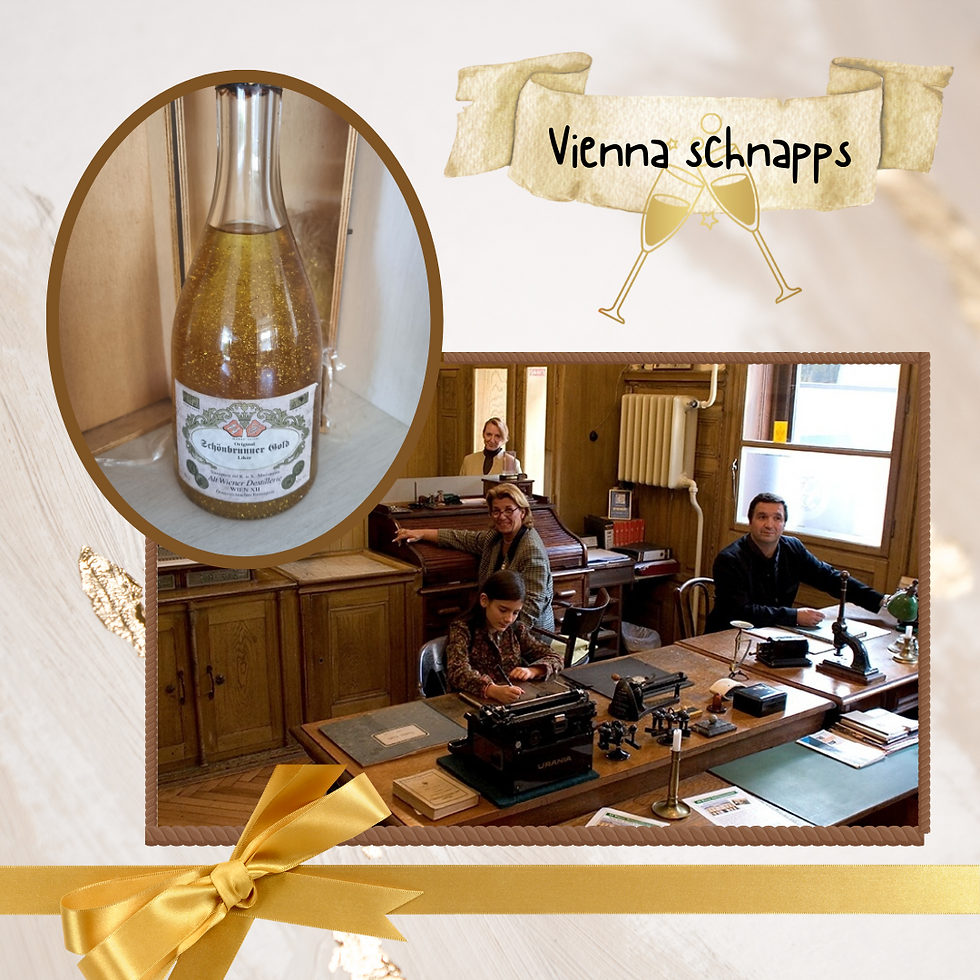
We had a demonstration on the art of making brandies, liqueurs and schnapps by an adorable cuddly Fischer family member (aka the guy in the dark shirt). We were able to taste some of the products. I’m not much of a drinker and even the small amount I tasted made me feel a bit woozy, especially since I’d not had much to eat that day.
We bought a bottle of strawberry crème liqueur and one of gold leaf liqueur (Schonbrunner gold), more for the bottle and wooden boxes they came in, to be honest. The gold leaf liqueur has survived, and to this day, still sits on a shelf in my house, unopened. That's it in the above collage. Unfortunately, one of our children knocked over the strawberry bottle when they were a toddler and broke it, before we had a chance to drink the contents.
After the schnapps tour, we went to Vienna Prater, an adventure and amusement park. Vienna Prater is home to the Giant Ferris Wheel (Wiener Riesenrad), built in 1897, standing 65 metres tall. The carriages are enclosed and can hold large groups of people in each, so not like a traditional ferris wheel with a seat for two people. The wheel went around slowly, and it was lovely to be able to enjoy views of the city.

After the ferris wheel, Graeme took us to Rosenberger’s for dinner, a Sizzler-style chain restaurant with self-serve salads, pastas, fruits and meats. The place is enormous, spread over two floors.
The night would not have been complete without an illuminations tour, of course! Vienna was stunning at night, especially the neo-gothic town hall. We also saw the Red Army Liberation Memorial (1945) with the fountain in front built in 1873. The fountain lights up a night with different colours. This is what it looks like during the day.
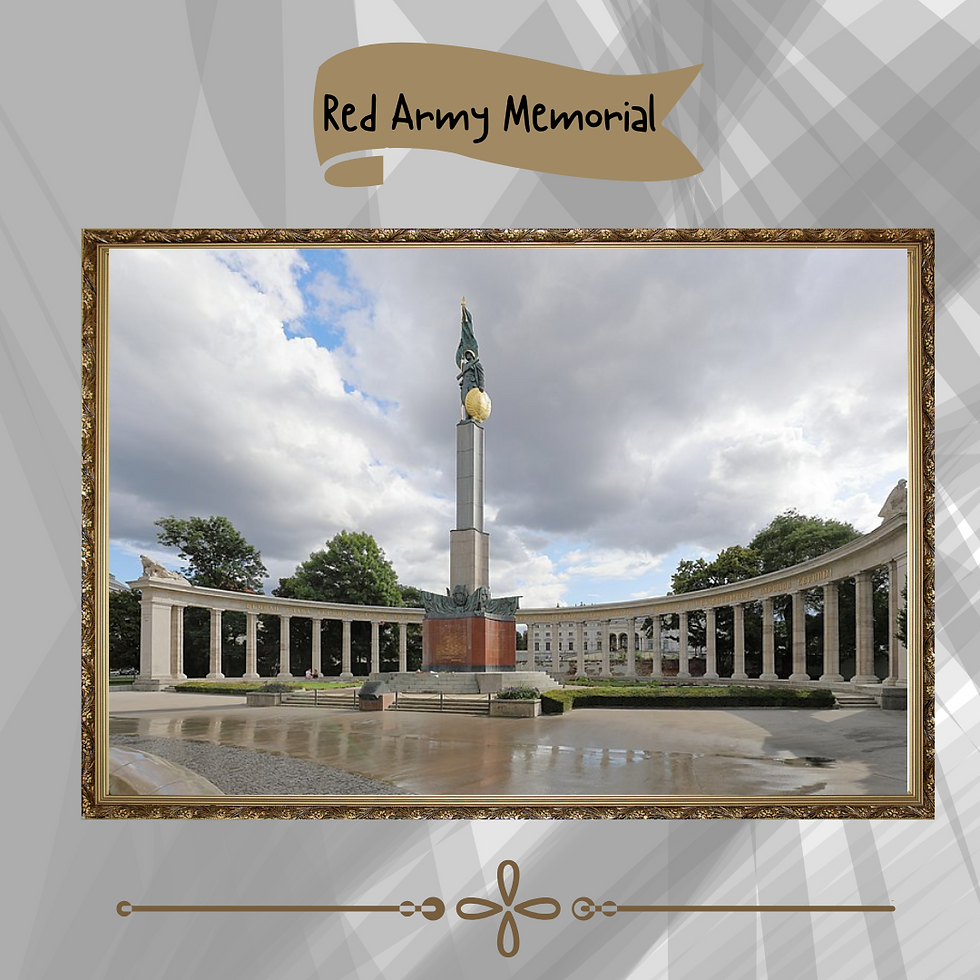
After breakfast on Day 14 in the hotel ballroom (complete with chandeliers!) we visited Schonbrunn Palace, one of the most important monuments in Austria. The Palace is modelled on Versailles and takes its name from its roots in an artesian well from which water was consumed by the court (schonbrunn means beautiful spring). The Baroque palace has 1440 rooms and spans 300 years of Habsburg history. It was once the summer residence of Maria Theresa Habsburg, who ruled from 1740 to 1780, and Emperor Franz Josef was born and died there. During WW2, the Palace was requisitioned by the British for office space and became a museum in the mid-1950s. The Palace and its gardens were entered into the UNESCO World Heritage List in 1996, the year we visited!
Our guide was Diane, an English woman with an Austrian father who had been living in Vienna for over twenty years. She was easy to listen to and really knew her stuff, so she gave us lots of interesting information about the Habsburgs. I remember thinking that the Palace was ornate, but a little ostentatious, with its gold-plated interiors. Now that I have been to Versailles (post to come), I completely get it! I preferred the magnificent gardens to the Palace itself, all beautifully laid out and landscaped. They are huge!
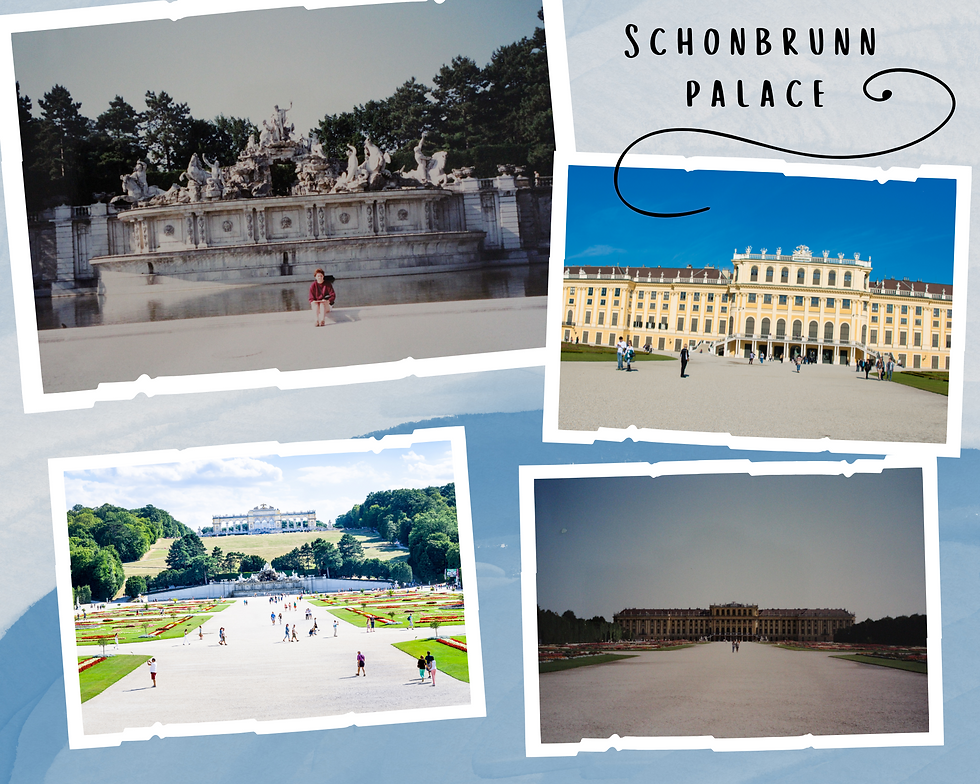
After the tour we joined the rest of the group for a jaunt around Vienna. Again, lots of things seen only from the bus, including the statues of Beethoven, Mozart and Strauss. We were able to get off the bus at Belvedere, the historic building complex that includes two Baroque palaces, an Orangery, and the Palace Stables, dating back to 1697. We really only wandered past the structures, and I wished we’d had more time to explore.
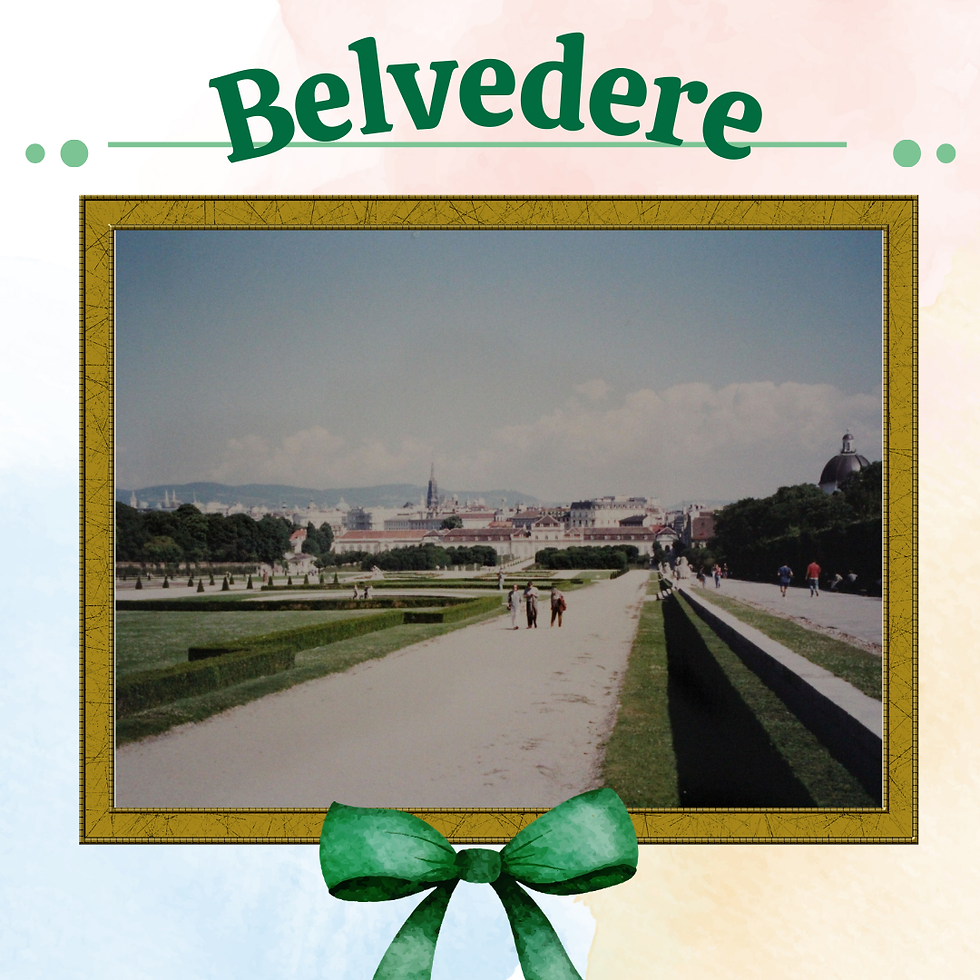
We walked on to the 19th century Heldenplatz (Heroes’ Square), a public space in front of Hofburg Palace where Hitler made his Anschluss speech in 1938. You can see the place where Hitler made that annexation speech in the below photo. The other building is the Natural History Museum, opened in 1889, that surrounds the square. As a WW2 buff, I couldn't quite believe that I was standing in a place of such historical significance.
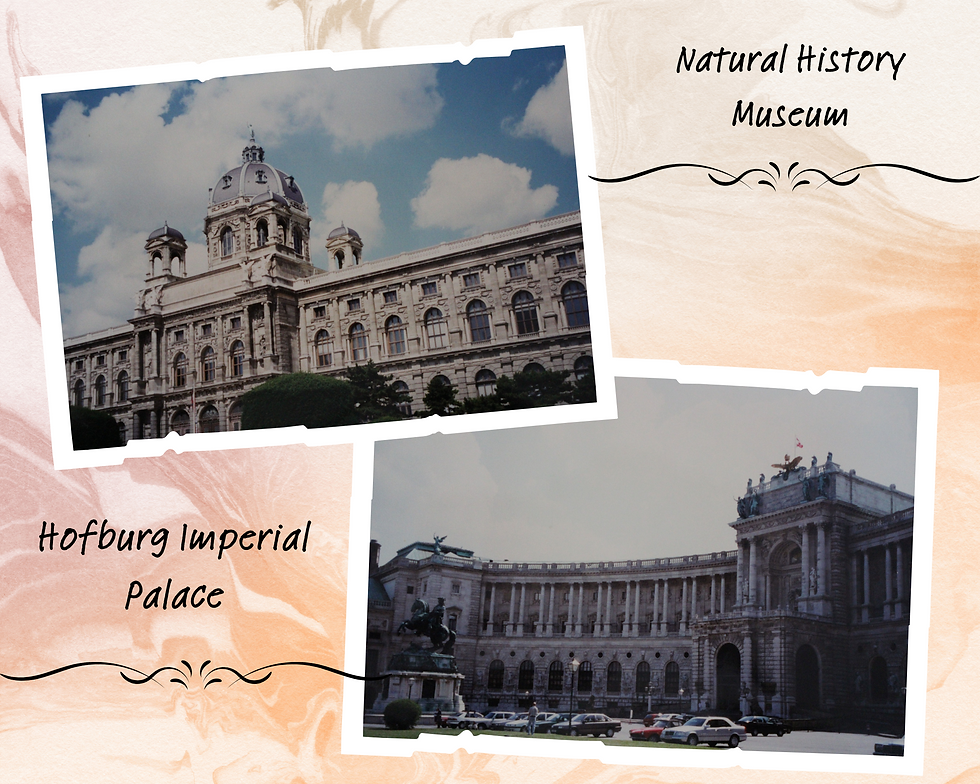
We then took a short wander to see the Maria Theresa monument, nestled between the Natural History Museum and the National Art Museum. The monument was unveiled in 1888 by Emperor Franz Josef. It is a huge monument, towering over four sets of statues, each representing facets of Maria Theresa's rule: her advisers, her administration, the military and the arts and sciences. The side facing the Natural History Museum has Mozart and Haydn statues.

The other notable building we saw was the State Opera House (Wiener Staatsoper). It is a 1700-seat building that was constructed between 1861 and 1869. We were told that the building was bombed during WW2 after apparently being mistaken for a railway station. It was restored in the 1950s.
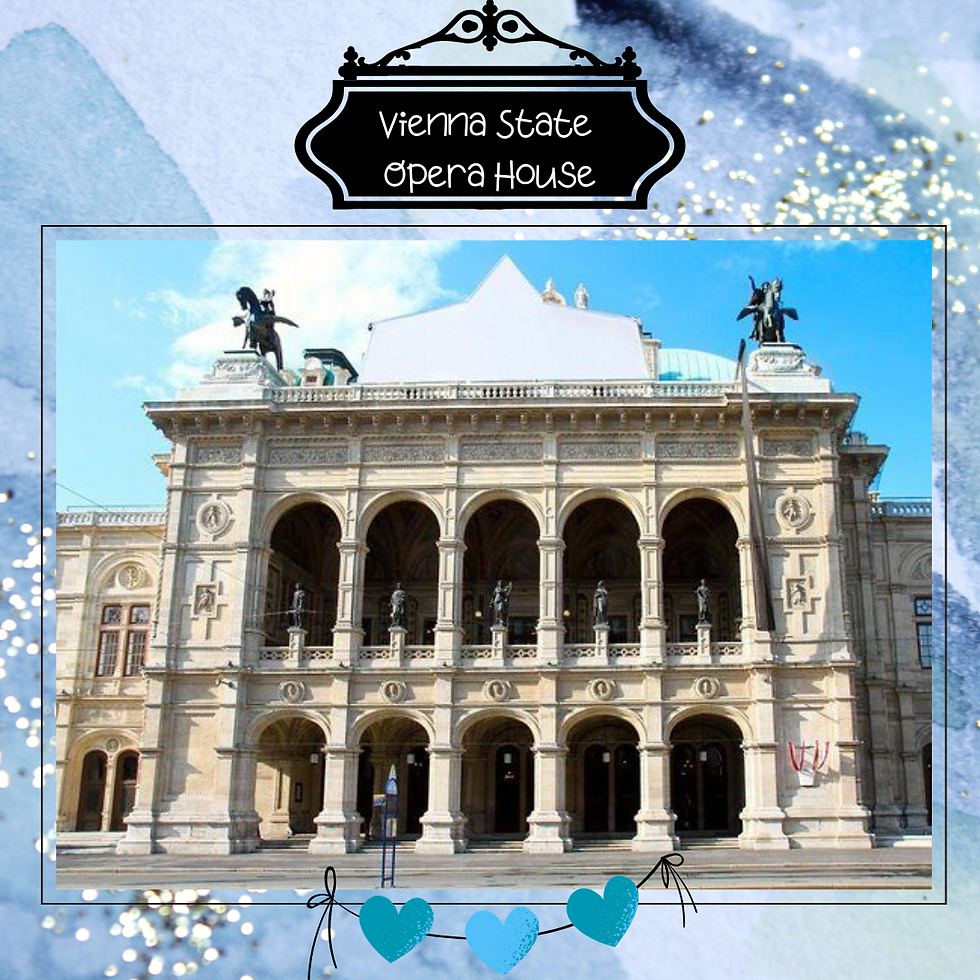
We were in Vienna on a Sunday and not much was open. We went to Rosenburger’s again for lunch and then wandered around the massive mall that forms the central city area. We found the Romanesque and gothic St Stephen’s cathedral that dates back to the 12th century at the top of the mall. We had a quick look inside while a service was being held. The photos we took aren't great, but hopefully you get the idea.

I wish we’d had more time in Vienna to properly explore and get more of a feel for the place. I say that about everywhere we visited, really, as tours like the one we did are a mere taster.
The morning visit to Schonbrunn Palace was an optional extra and in the afternoon, we did the second part of the tour by visiting the 17th century baroque-style Winter Palace of Prince Eugene (Hofburg) to view the Austrian crown jewels. The jewels aren't as ornate as the British crown jewels we’d seen in London. Super interesting, though, as Diane told us that they were originally constructed to symbolise Austrian history. Housed within the jewels is supposedly the wisdom tooth of John the Baptist and a piece of the Shroud of Turin.

One of the limitations of touring is that you are stuck with the tour schedule and back in 1996, there were no smartphones or Ubers to help you make the most of any free time. We just had to wing it during our rare moments of free time. This time our winging it worked. We were back at the hotel by mid-afternoon and met up with T&D for another walk around Schonbrunn gardens. We climbed up the 60 metre-high hill to the Gloriette, an imperial army monument since 1775 and now a coffee shop. The views of the Palace and gardens were lovely, and it was a glorious afternoon weather-wise. I’m glad we had the opportunity to properly explore the gardens and enjoy some nice weather.

Dinner was not included that evening and we ended up at the little restaurant next to the hotel with T&D. We had pizza and lasagne and giant ice cream sundaes. I remember the waiter, partly because he was handsome and had lovely blue eyes, but also because he thought we could speak German and started asking for our order in German without realising we could only understand the basics. We must have been looking at him blankly as he suddenly paused and started laughing uproariously. Throughout our meal he kept coming back to us, speaking in German, then laughing to himself. We couldn’t help but laugh, too, although he was probably laughing AT us rather than WITH us! All these years later I still remember that meal! Hot Waiter and his colleague waved madly at us as we left so perhaps they were just amused by the communication misunderstanding.
Our Austria experience🚌Austria, like Switzerland, lived up to my expectations as a neat and orderly country with spectacular landscapes. Other than our interactions with Hot Waiter, we got on OK with the language barrier. After Hungary, everything seemed expensive. I thought Vienna was a pretty, classical city although without a river as its main feature. The history made me feel connected to Austria and to Vienna, and I loved the historic buildings and our magnificent hotel. The visit to Schonbrunn was a tour highlight. |
Leg 9: Vienna to Prague🚌
We left early the next morning (Day 15) for the border, crossing without incident into Czechia (known as the Czech Republic at the time of our visit in 1996). Below is the visa we required to enter the country, stuck into our passport by the Czech Embassy in Sydney before we left Australia.
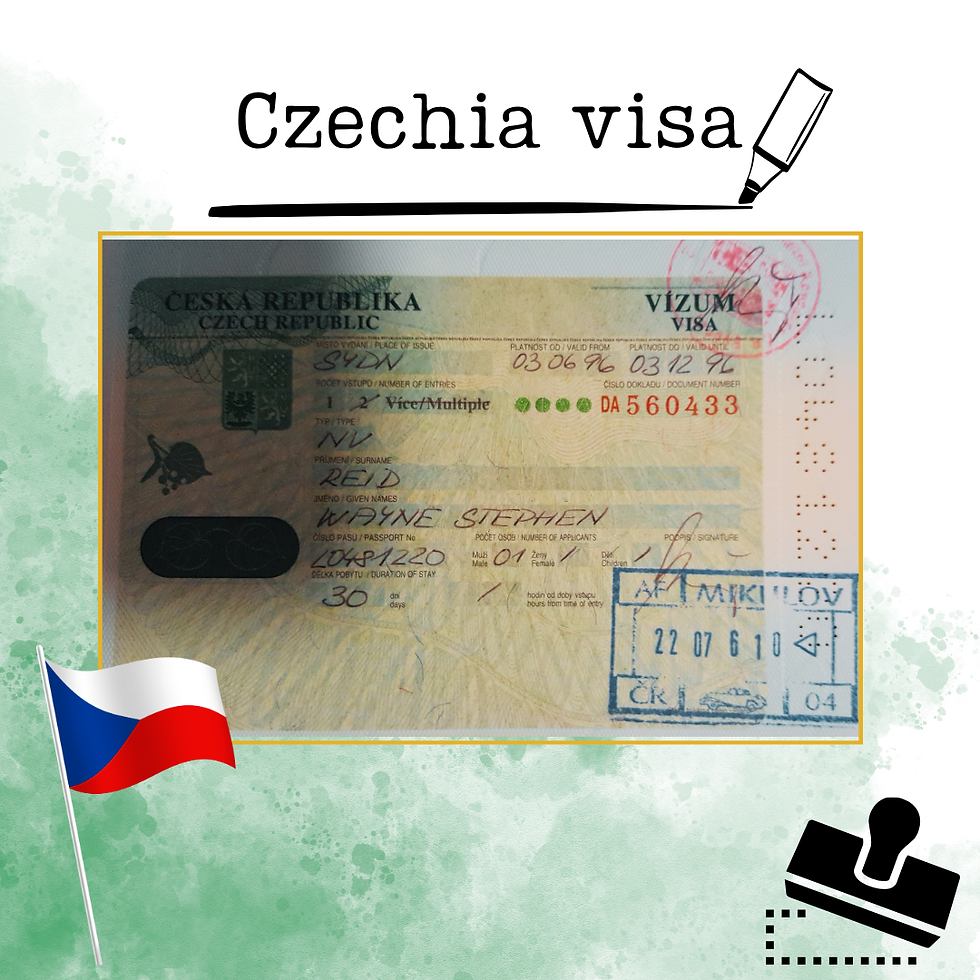
Our journey for Leg 9 took us from Vienna to Prague, some 335km and a 4-hour trip. was so excited to visit Prague! The below map charts our journey that day.

We made a stop along the way at the South Moravian town of Lednice, just inside the Czechia border and around 95km from Vienna. The quaint town has an 18th century castle once owned by a Liechtenstein family that is now a UNESCO World Heritage Site. I noted in my journal that the castle was a bit run down, especially the gardens, but it doesn’t look like that now. I recall that we bought some delicious fresh bread and a drink in the town for the equivalent of $1.20.
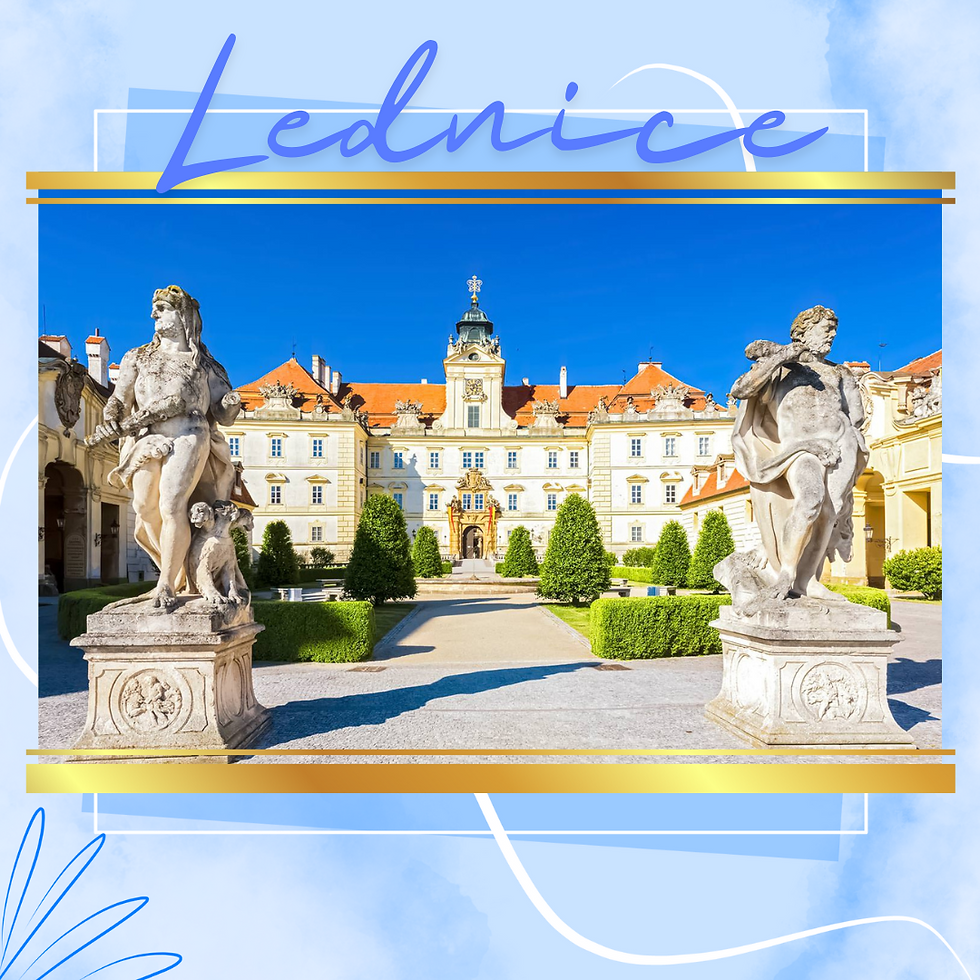
We drove another 60km towards Prague, stopping in Brno, a city under massive construction like we’d seen in Berlin. We wandered around the beautiful, cobbled streets and T bought a slice of pizza from what you’d call a pop-up shop these days. The server asked him if he wanted tomato sauce on his slice. Ha!
In Brno one of our tour companions had $800USD stolen from her bag while she washed her hands in the loos at McDonald’s. It wasn’t hard to spot the pickpocket gangs loitering around the eating area of the restaurant. Now that I think about it, $800USD was a lot of money back in 1996 (still is!). I’m not sure why she had so much cash on her. I know we’d eaten at McDonald’s in Gyor (out of necessity more than anything else), but back then it was better to avoid fast food chains, for both the food and the pickpockets.
I wish we'd taken photos on Brno, especially given the year that we visited. I am not sure why we didn't! You can read about Brno here. I do have this (rather bad) photo of the Czech countryside, taken from the bus, though.
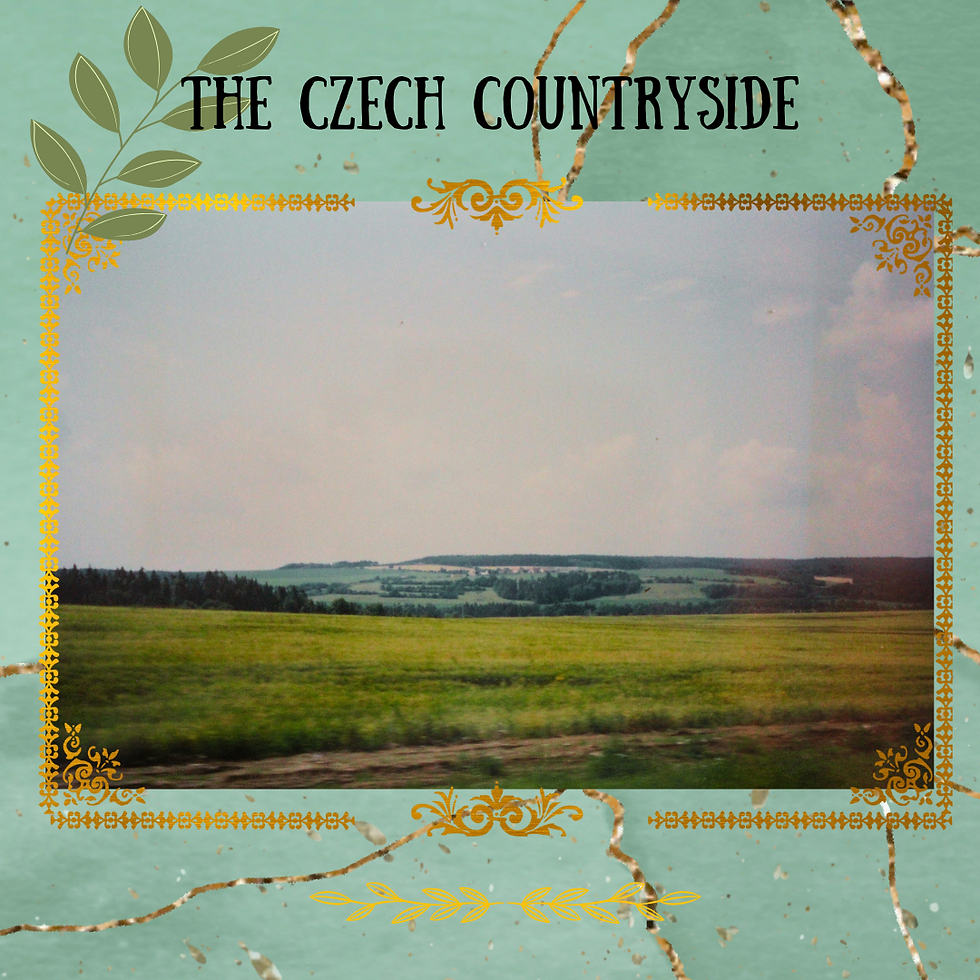
We arrived in Prague around 5pm after a 2-hour jaunt from Brno, checking into the Hotel Diplomat, all shiny and modern after the old world charm of the hotel in Vienna. Both hotels we stayed at in former Eastern Bloc countries were new and fancy, I guess to attract tourists in the early days after the fall of the Iron Curtain. Dinner was less hearty than we’d had in other hotels, but it was actually a nice gastronomic break. I wrote in my journal that we were served a tiny half tomato with some sort of fish paste on it, a small helping of beef stew, and a slice of strawberry trifle.

Day 16 of the tour and we were holding it together...just...We were nearing the finish line! Prague had long been a bucket list thing for me, so I was determined to make the most of our time in the city, even though I was starting to suffer from tour fatigue.
The buffet breakfast at the hotel was huge, and once again we were filled up with food that meant we were hardly in need of much during the day. Our local guide for our trip to the 9th century Prague Castle was Susanne, a lovely woman who unfortunately didn’t have the best English. We all struggled to understand her, and I remember that her information was a little jumbled so it was hard to get a clear picture of what she was trying to say. I felt so bad for her as she could see that communication was an issue.
Not to worry, it was a glorious day, and we had a lovely time wandering around the Prague Castle complex that overlooks the city. The castle is quite extensive (70 000 square metres in area) and hard to discern as a castle – more a series of structures (see below). St Vitus Cathedral, a gothic church on the site and the most important in the country, was built in the 14th century and features mosaics of The Last Judgement. You can see the church in the two shots on the top middle and right of the below collage.
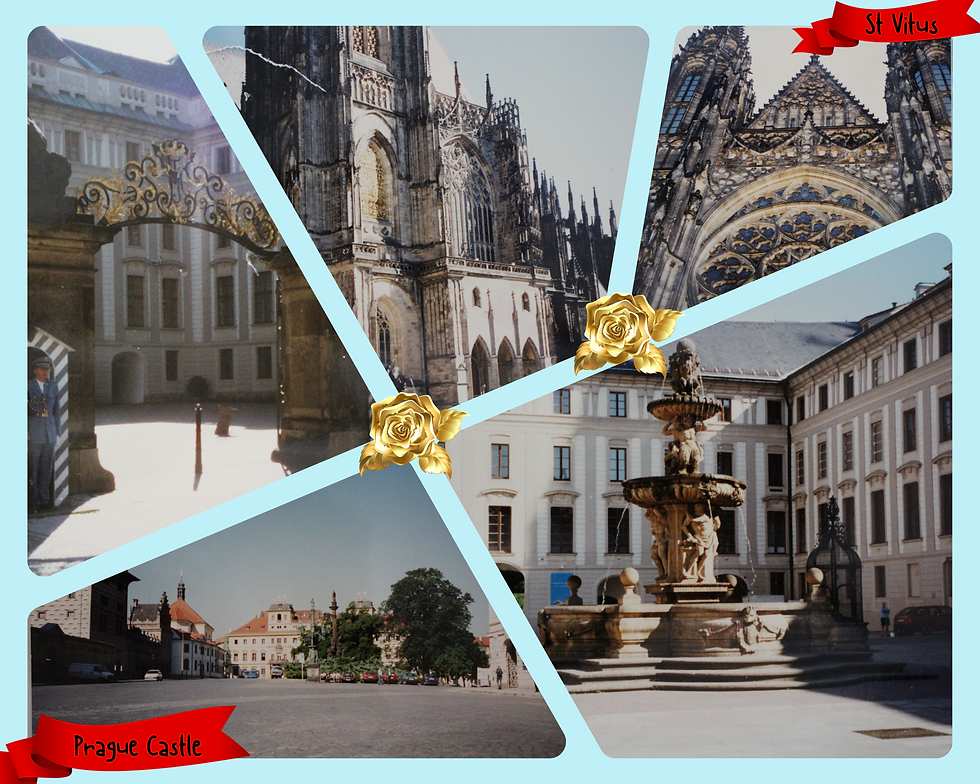
We were on our own after the castle tour and arrived in the Old Town Square at 11am, just in time to see the revolving figures of the apostles of the Prague astronomical clock (Prague Orloj). You can see how awesome the clock is, even though our pretty ordinary photo doesn't do it justice. I was so thrilled to have seen it in action. The clock dates back to 1410, and represents the position of the sun and moon in the sky, a bunch of astronomical details, and various Catholic saints. The Walk of the Apostles is an hourly moving of the apostle figures and other sculptures, most notably the skeleton that represents death striking the time, and a calendar dial with medallions representing the months.

The Old Town Square features several gothic buildings, including the 14th century Old Town Hall and Church of Our Lady before Tyn and the House at the Stone Bell. I loved our afternoon in Prague, wandering around and taking in the vibe, exploring little cobbled alleyways off the Square. We also walked to Wenceslas Square in the New Town, headed by the magnificent 19th century National Museum building (top left hand photo below). Prague, we 💓 you.

We walked across the beautiful Charles Bridge, the medieval stone arch bridge, first constructed in 1357, that crosses the Vltava River. The bridge is 516 metres long and 10 metres wide. It is a bow bridge with 16 arches shielded by ice guards and decorated by an alley of 30 statues. The statues were originally erected between 1683 and 1714 but have since been replaced by replicas, the originals of which are housed in the National Museum.

We rubbed the good luck plaque on the bridge (top left hand photo above), along with every other tourist. The statue and plaque commemorate St John of Nepomuk who was canonised In 1729, and is the only bronze statue on the bridge. I remember that we bought a print from one of the stalls near the bridge. We had it in a frame on our wall for many years until it unfortunately deteriorated. I did buy a book from one of the stores in the Old Square that has survived.

Czechia impressions💭I thought that Czechia was less in full swing towards capitalism than Hungary, so it felt more unaffected by change and masses of tourists. There didn't seem to be many American fast food restaurants around and there were fewer sellers out on the street than in Budapest. English was less spoken than in Hungary, but I could just imagine Prague in a few years, transformed into a major tourist destination. Again, I was glad we had visited before that happened. I loved the whole vibe of the city: the pretty River Vltava, the stunning Charles Bridge, and all the gothic buildings. The central area of the city is compact and easy to walk around, buildings tightly packed together with quaint, narrow cobbled streets in between. I’d so love to go back one day! |
Leg 10: Prague to Munich🚌
We’d been travelling for almost a month by the time we headed to Germany, and on the tour for 16 days. It was all starting to feel relentless and overwhelming. Sixteen days may not sound like much, but it is when you hurtle around a continent at a cracking pace!
We were up again early on Day 17 for our 400km, 4-hour drive to Munich, stopping at the beer-brewing town of Pilsen, where we used up our remaining Czech crowns on some fresh bread and muesli bars. The weather had turned cold and dreary, and we found Pilsen a bit depressing, drab and grey as you might expect an old Communist town to be. Luc got lost driving the bus out of Pilsen to the border and his arguing with Graeme over directions added an hour to the trip (no Google maps back then!). Getting lost did give us the chance to see lots of the area in and around Pilsen, though!
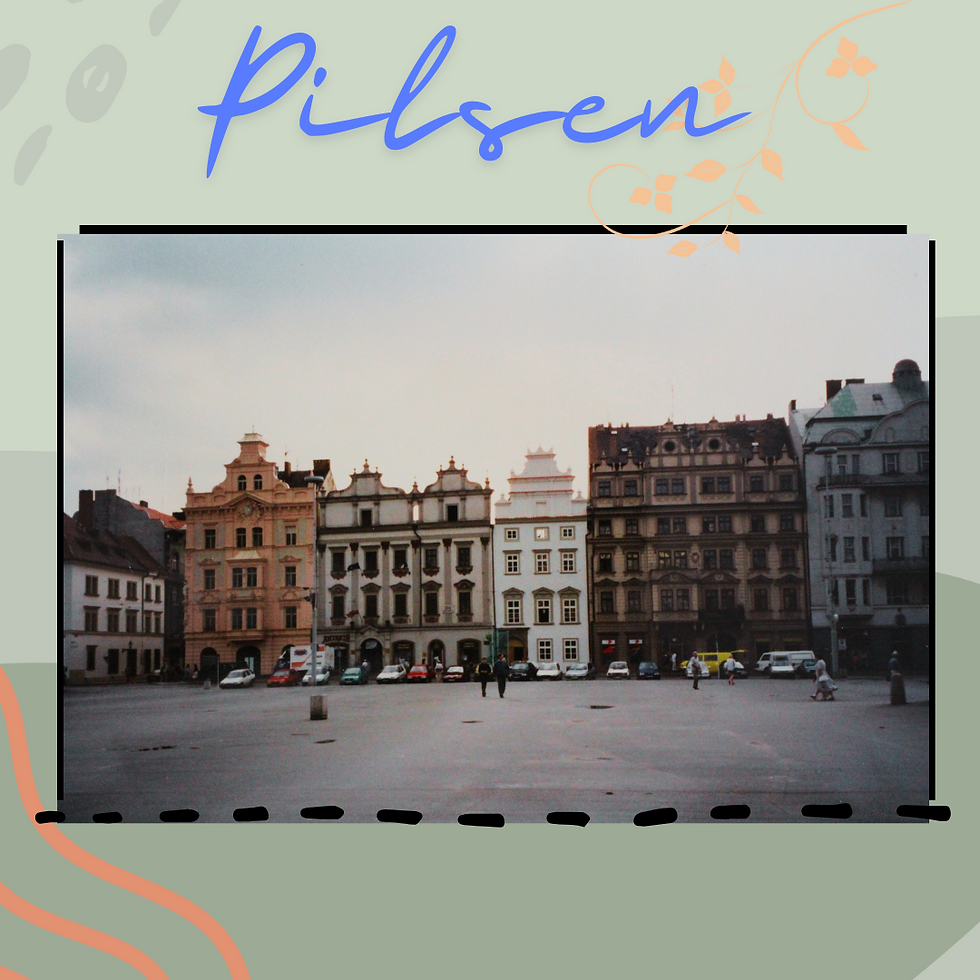
Once Luc found his bearings, we were speeding down the autobahn after a hassle-free border crossing into Germany, breaking at a motorway stop for lunch. We just bought snacks as we had food from the Pilsen stop. Most of our tour companions lined up for a hot meal at the motorway stop; another time when we marvelled at the food these folk were putting away!

We enjoyed the lush green landscapes and quaint orderly villages we could see from the bus as we headed to Munich. The only photo I managed to take doesn't quite capture how pretty the German countryside is, but then we were whizzing past it all day, so...

We arrived in Munich at 5pm, just in time to see the glockenspiel at work in Marienplatz Square. The clock was completed in 1908 and has 43 bells and 32 life-sized figures. It re-enacts two stories from Munich’s history from the 1500s. So cool!

We then visited the famous Hofbräuhaus beer hall for a stein of beer and some German oompah music. Super touristy, I know, but it was a lot of fun. The beer hall was originally built in 1589 but was largely destroyed by Allied bombings during WW2, to be faithfully reconstructed by 1958.
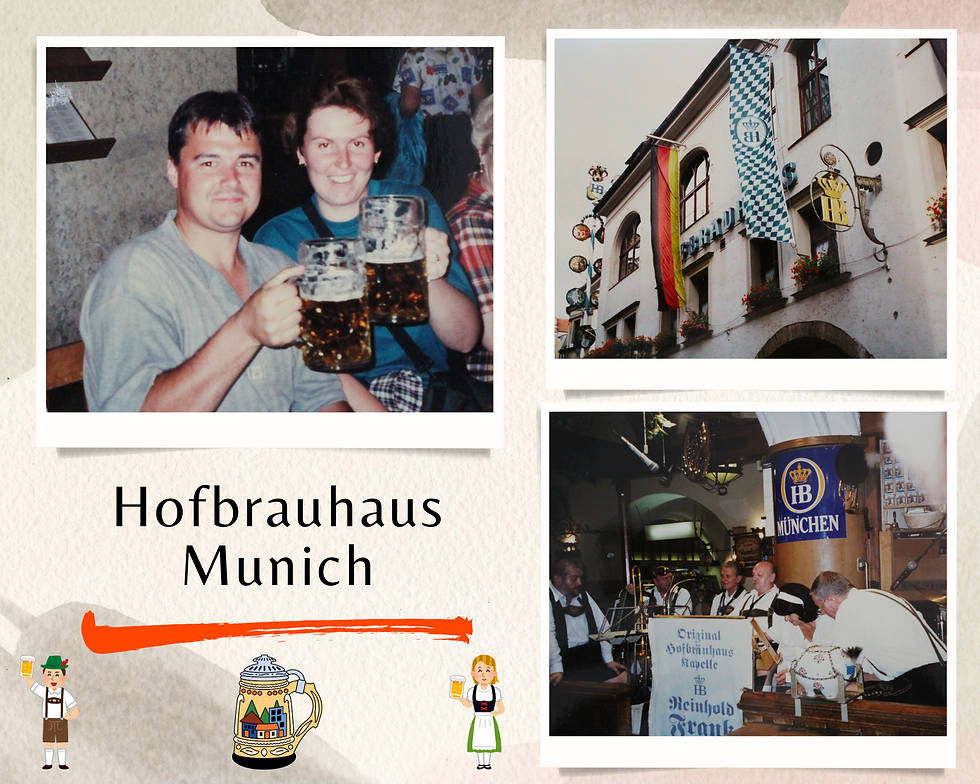
We stayed in the Hilton in Munich which was a bit of a surprise as it was posh, and we felt completely out of place. Ha! That’s the thing with tours (well, at that time anyway), the hotel isn't known until the evening of arrival. The hotel is the least interesting part of travelling to me, but what was interesting was the variety of places we stayed in across the trip. We were intrigued to see what the rooms were like at the Hilton but they weren't as posh as the swish lobby. The dinner was an incredible buffet with every food you could imagine, though!

Leg 11: Munich to Koblenz🚌
I woke up feeling like I was catching the cold that was circulating the group. That’s another of the cons of touring – being at such close quarters with a large group of people is a sure way to get sick. The weather didn’t help as it was cold and cloudy, and it showered in the afternoon. Day 18 was another long one. We travelled 520km from Munich to Koblenz via Heidelberg, plus a little Rhine jaunt from St Goar.

We’d had no time at all in Munich, just the evening before, and we were off again in the morning of Day 18, driving to the outskirts of the city past the BMW Headquarters and the Olympic Stadium. We had been told the night before that there would be a surprise addition to our itinerary the next day and we guessed it was a visit to the concentration camp memorial at Dachau. I was glad we would visit such an important historic site (and to add to our experience at Sachsenhausen in Berlin), as were many others in our group. Some of the group, however, thought it was a terrible idea and refused to get off the bus when we arrived at the camp. At the time I thought this was a strange attitude, but I assume they had their reasons (even though I don't recall those reasons being talked about).
Dachau is quite different to Sachsenhausen as there are more buildings preserved and it is more like a proper museum. Sachsenhausen felt very raw, but at the time, it probably didn't have as many visitors as Dachau. We had quite a bit of time at Dachau, so were able to watch a film on the rise of Nazism and wander through the brilliant but disturbing exhibition of photos and artefacts. Still today I am affected by the two concentration camps we visited, as the horrors of the Nazi genocide become so much more real when you stand in the places where it was committed.

Dachau is around 30km north west of Munich. I bought the below booklet at the museum. It gives the fascinating history of the town, dating back to 500 BC. Interestingly, one page of the booklet is dedicated to the Nazi period. I imagine the town will be forever associated with the concentration camp, though.
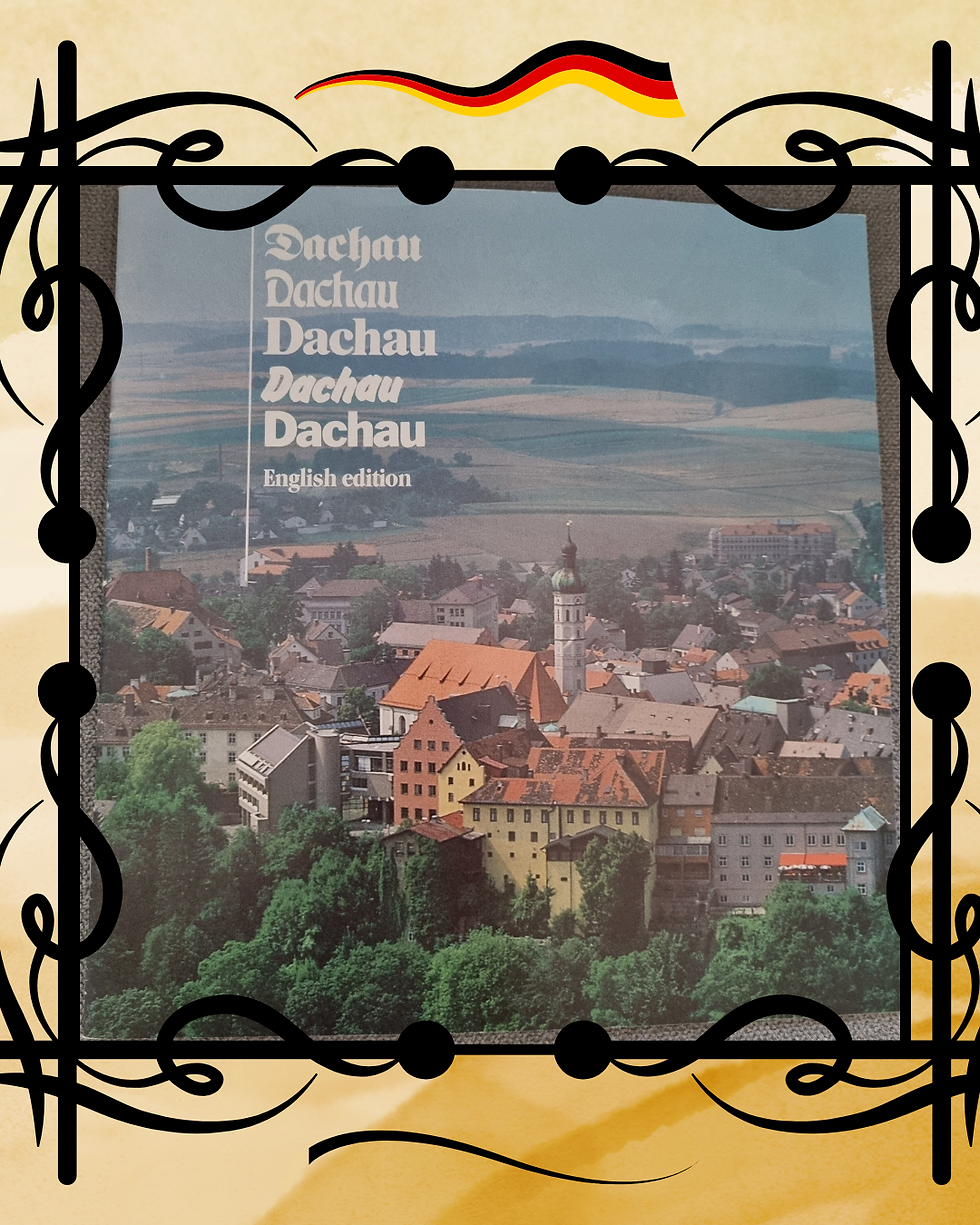
After that sobering and thought-provoking visit, we headed along the autobahn again, travelling three and a half hours and 330km to Heidelberg. We broke our journey at yet another motorway rest stop for lunch, this time near Stuttgart. Heidelberg is a special place for me as I’d had a German penfriend, Clara, who lived there when we used to correspond when I was learning German at high school. (Yes, I am old enough to have had a penfriend!)

Our visit was hampered by the cold, showery weather (this is summer?), but we still managed a stroll around the main square and glimpses of the ruined castle that looms over the town. We bought this cute little teddy bear wearing traditional lederhosen from some markets and had a drink in a student inn. Fun!
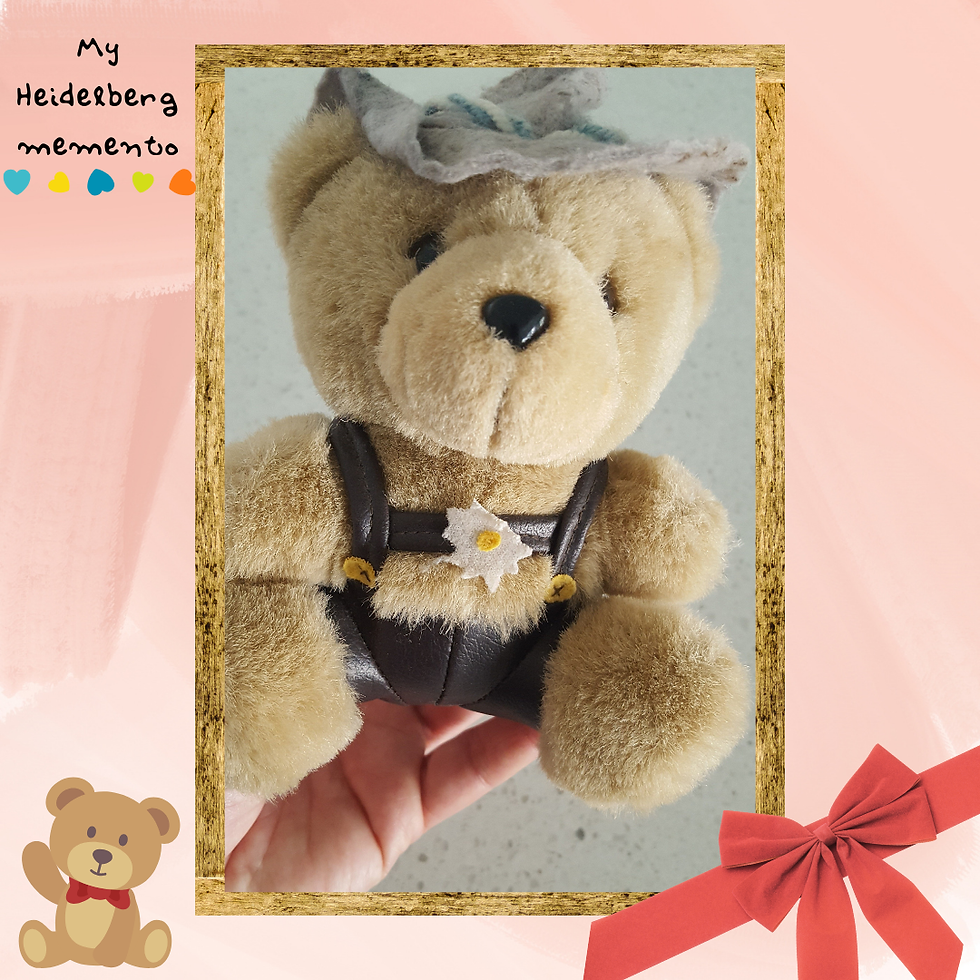
Our day was not over yet, as we then headed a further 2 hours and 155km north to St Goar to embark on our Rhine cruise. My head cold had really set in by then and I was feeling very under par. The cruise was so cool, though, passing by vineyards, castles and gorgeous hillside homes. The weather improved a little, too (although you can't tell from the photos!)

Our rest stop for the night was in nearby Koblenz, in a hotel with a magnificent view of the Rhine - until the fog set in, that is! I remember the hotel dinner was delicious, but I was feeling horrible by then and just wanted to go to bed. The below shot is the view from our hotel room.
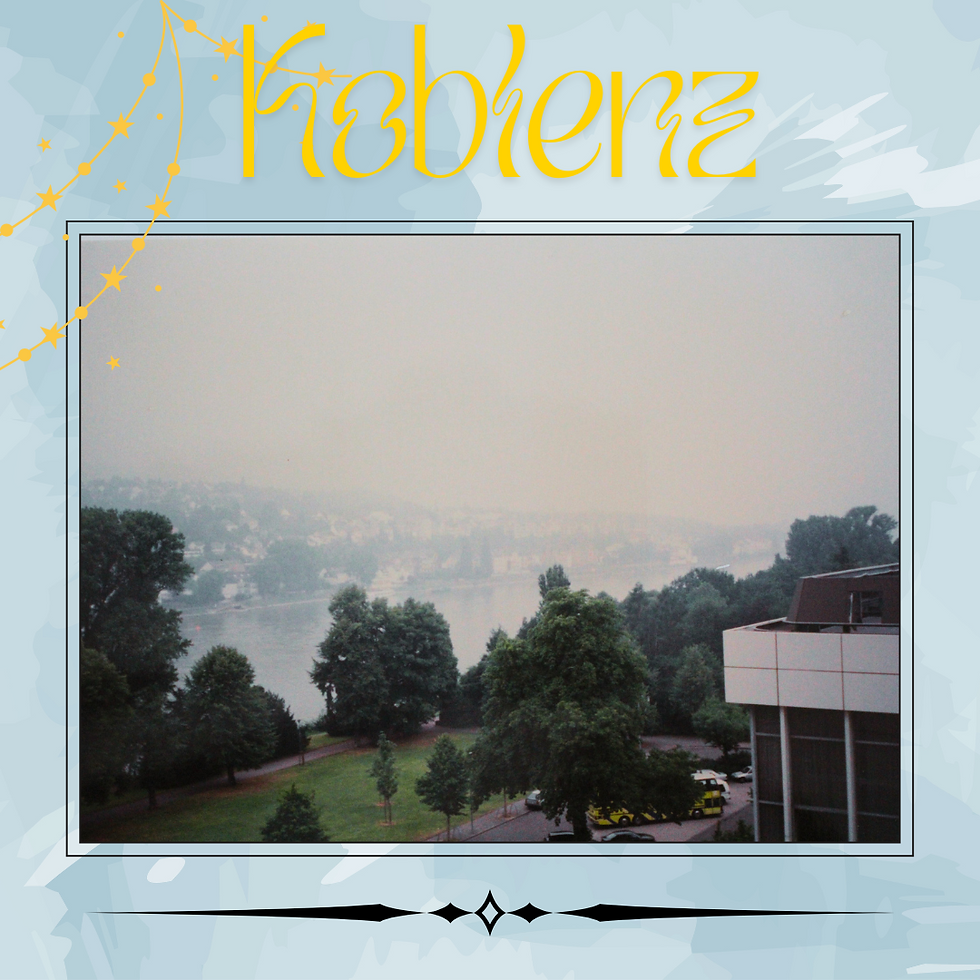
Leg 12: Koblenz to Brussels via Luxembourg🚌
Day 19 was our maddest one of the tour. We travelled through three countries, starting in Germany and ending up in Belgium via Luxembourg. We covered 400km that day, around five hours of travel. Most of it is a blur to me, to be honest, as my cold hit a low that day.

We set off in the morning for Trier, the oldest town in Germany and our last stop in the country. I loved Trier – so pretty with its distinct architecture and lovely square. Trier is 130km south west of Koblenz.

We used up our DM on bread and fruit and checked out the UNESCO World Heritage Site Roman gate, Porta Nigra (black gate) in the town with its huge portcullis. It was built in AD 170. How amazing is that?

Our Germany experience 💭Germany was one of the places on the tour I’d been dying to experience, after learning German at high school and gaining a small taste of it from our Berlin side trip at the start of our adventure. I had dreamed of visiting Europe since I was small and I found Germany to be as I expected, with picturesque green landscapes and a strong sense of order and tidiness. Unfortunately, the itinerary didn’t allow us to take things in with any depth, as each place we visited only gave us a short amount of time to explore. The lousy weather and my equally lousy cold didn’t help matters. That said, the highlights were the glockenspiel in Munich, the Dachau experience, and visiting Trier and Heidelberg. I wish we’d had more time in the country and that our visit had come earlier in the tour when we weren’t so exhausted. |
That was it for Germany! An hour after leaving Trier, we were in Luxembourg! It is so weird for us as Australians to comprehend traversing three countries in one day (for we would end up in Belgium by that evening). I remember thinking, through my cold-addled brain, that Luxembourg was stunning. We wandered around the main square and took in the views from The Rock lookout. Honestly, we were only there for a couple of hours – definitely a whistle stop visit!
Our third country for the day - Belgium - was up next. We were excited to experience Brussels, but we were absolutely ready to be off the tour by then. We stopped at Bastogne in the afternoon, a short drive from Luxembourg just inside the Belgian border. We only had a little bit of free time, and I wasn’t up to much exploring, so we stuck around the Sherman Tank Memorial at the intersection of Place General McAuliffe and Rue de Sablon, commemorating the 1944 Battle of the Bulge.

We arrived in Brussels in the middle of the afternoon after a further 150km, 2-hour drive north. There was the usual rushed drive around the city in the bus. I remember thinking that the city was one of sharp contrasts between beautiful homes on tree-lined streets and quite shabby areas, but I guess you can say that about any city. The Brussels experience is quite a blur to me as we really only had a few hours in the city. I was lucky to return to the city in 2011 for a proper poke around.

We were able to get off the bus and wander around The Grand Place, with its beautiful buildings, unspoilt by fast food restaurants. Graeme took us for a walk to see Mannekin Pis, the 55cm bronze fountain sculpture of a little boy urinating. I know it's a huge tourist drawcard, but it's so weird.

This was our final night of the tour, and we chose the optional farewell dinner at a local restaurant Graeme raved about but then couldn’t find. We were in a seriously dodgy part of town, but the meal was lovely, and we had the best table in the room, right in front of an incredible mural. I had been feeling rotten all day but perked up a bit by the evening.
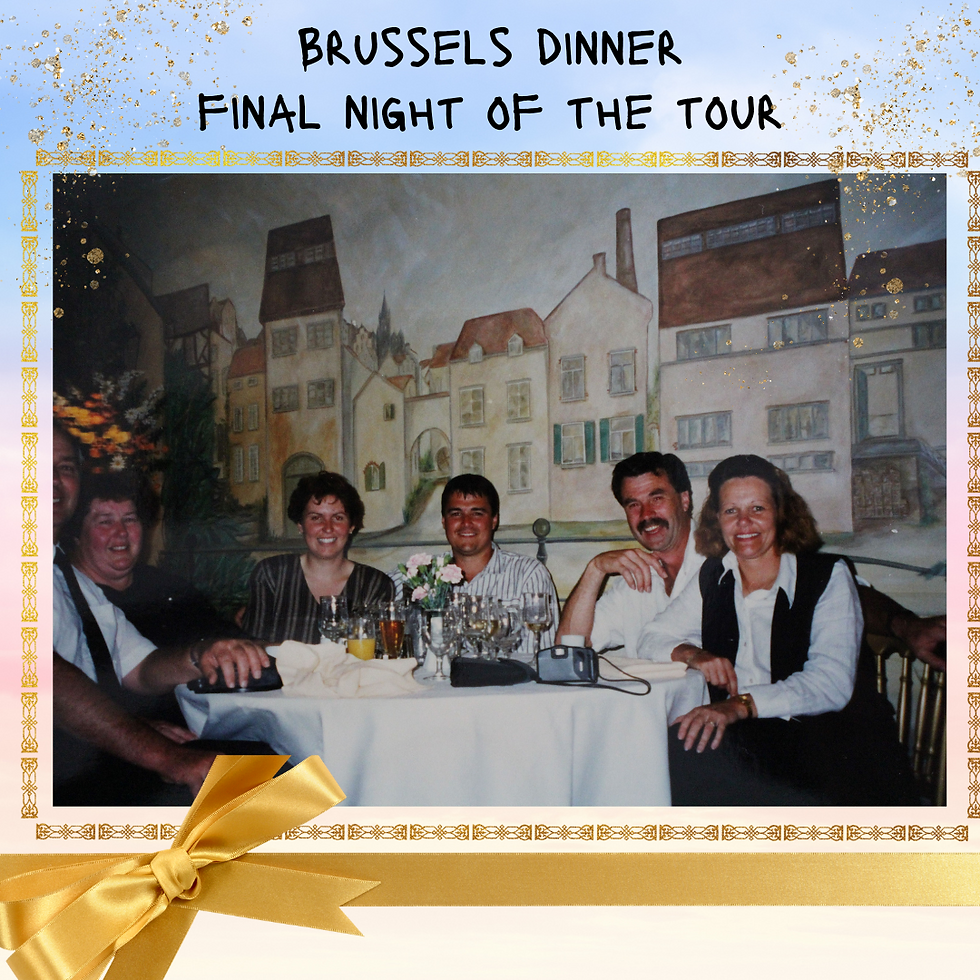
Our hotel was the Renaissance in the centre of the city, complete with the gaudiest carpet I have ever seen in the lobby. I don't have any photos - shame - but below is what the hotel looks like today. I don’t remember much of our stay there as my cold was still bothering me and we’d had enough of being on the tour. I felt better on the final day, but all we wanted was to get back to London and be on our own again.

Leg 13: Brussels to London🚌
The buffet breakfast on the final day (Day 20) was lovely, and we even had toast. Ha! Our final leg took us back to London, around four and a half hours of bus travel plus the return ferry across the Channel.
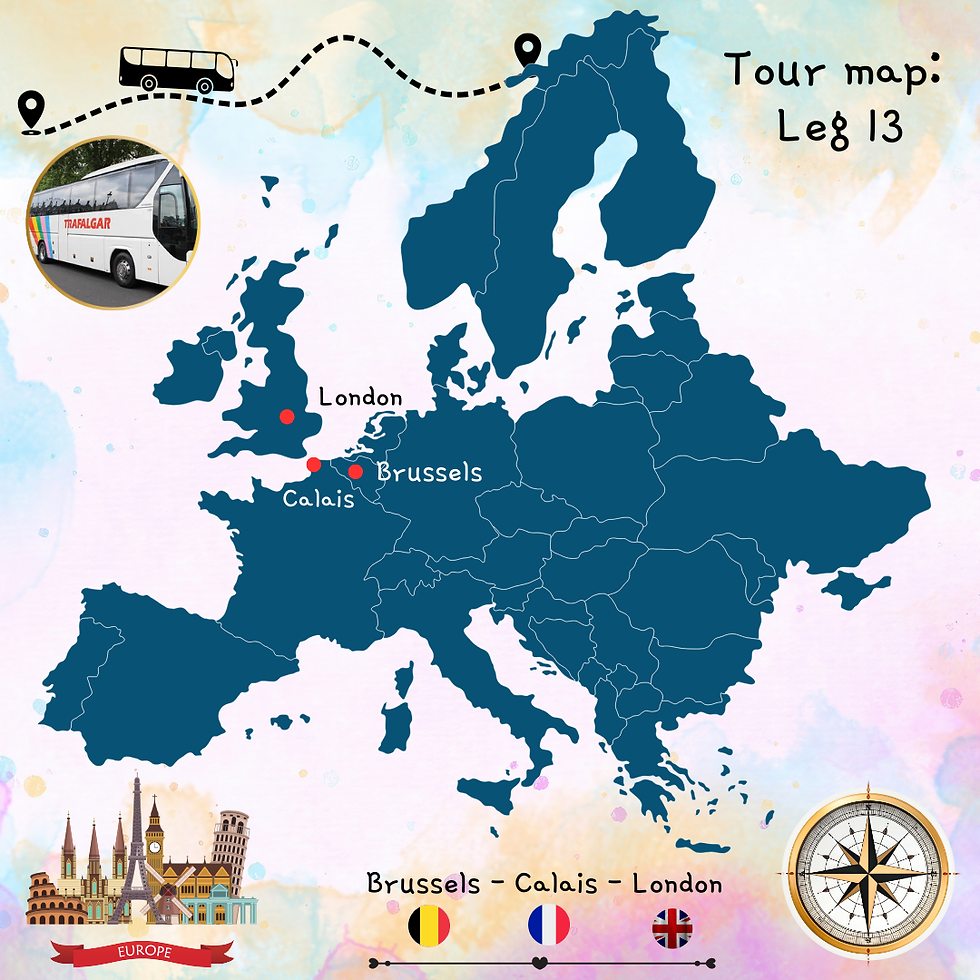
We stopped briefly on the outskirts of Brussels to take photos of the Atomium. The Atomium was built for the 1954 World Expo and was not intended to be permanent, but it has stayed, becoming an international symbol of Brussels. I was able to go inside on my return visit in 2011, but this time, we only had a fleeting glance of the impressive structure on our way to Calais.
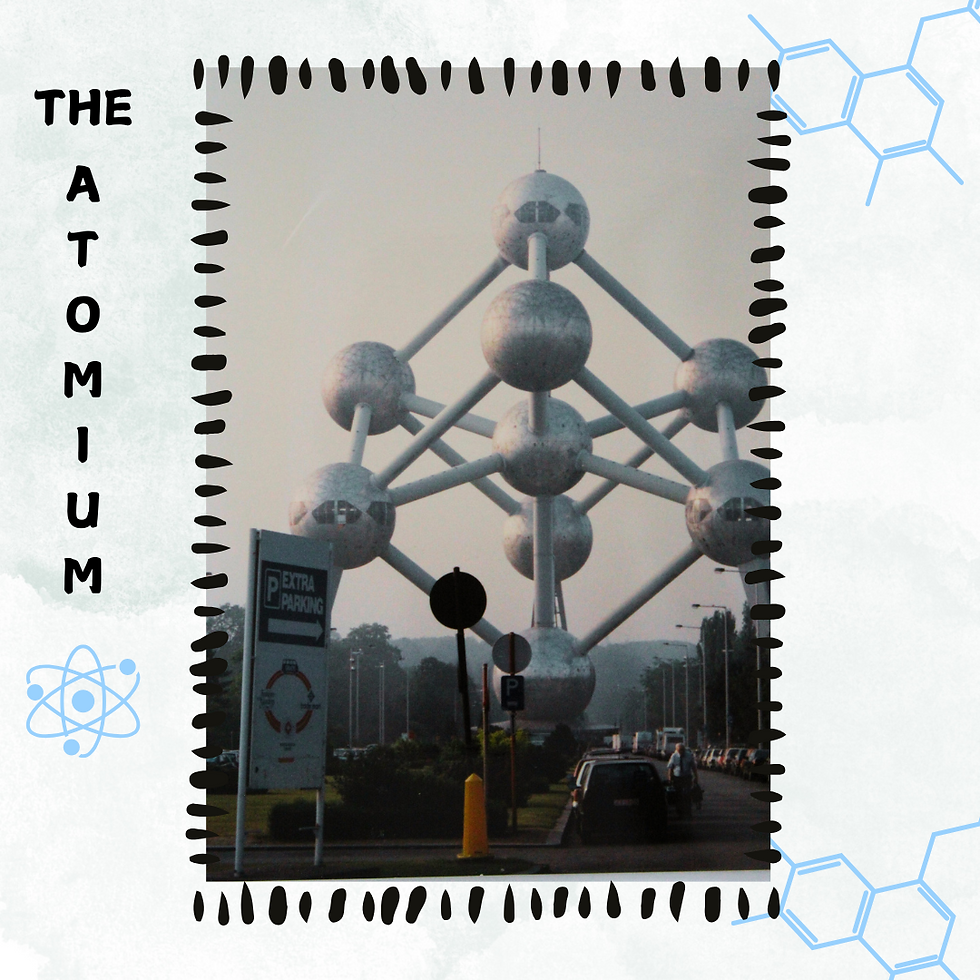
Our Belgium experience💭I remember thinking how flat the Belgian countryside was after the mountainous landscapes of some of the other countries we’d visited. It seemed so familiar after all the war films I’d watched over the years, especially the villages and farmhouses. I loved what I saw of Brussels but wished we’d had more time to explore. The Grand Place is so beautiful. I’m glad I have been able to return to Belgium to truly experience it. |
We farewelled Luc in Calais to lots of hugs and cheek-kissing. We gave him a $40 tip as Graeme had given us a stern talking to about how we needed to tip Luc. Tipping is not customary in Australia, so it felt awkward (and expensive to us!) to give money to Luc but he was a lovely man and an incredible driver. The things he did with that bus to manoeuvre around European city streets!
I hardly remember the return ferry crossing and I didn’t note anything in my journal at the time. We were met by a charter bus, and everyone was dropped back at their London hotels, although most people were staying at the Tower Thistle, where the tour had begun. Graeme shook our hands, and that was the end of our whirlwind adventure!
We were so relieved to be off that darn bus and away from all the people we’d been stuck with for three weeks T&D were in a room at the Thistle two doors down from us, so we met them later in the evening to stretch our legs and buy dinner at the nearby Safeway’s we’d found the night before the tour began. We went back to our room after dinner and watched the tour footage we’d shot on our video camera. It was hard to comprehend all that we’d seen and done over the course of the tour.

T&D were heading to Amsterdam in a few days, but we were off in the morning to Heathrow to collect our hire car for the final two weeks of our Grand Adventure, a road trip around England, Scotland and Wales . We were sad to say goodbye to T&D as we’d grown close to them during the tour, but completely and utterly relieved to be on our own again.
Our tour experience: The positives👍🏼
Let’s start with the positives. We experienced so much in a brief time, seeing and doing things we’d never have been able to do on our own in 19 days. Touring with a group is a timesaver purely by avoiding having to line up at key sights. This advantage was evident at the Eiffel Tower and the Sistine Chapel where we would have waited for half the day had we been on our own. Today that is less of an issue, though, as tickets can be pre-purchased online for set entry times.
Having Graeme or local guides to take us around was also a bonus, and we learned lots of interesting things from all of them. Graeme always gave us valuable advice about local customs, shopping, food, and places to check out during our free time. He had over 20 years of experience as a guide and it showed, as his knowledge was endless. His dry wit made him fun to listen to and we never tired of his stories. These were the pre-Google days, too, when information wasn’t as accessible. Nowadays, having a local guide is not as important, I suppose.
Other Trafalgar perks included access to restaurants and last minute changes to the itinerary all taken care of – essentially it was a hassle-free experience. We didn't have to worry about where to sleep at night and most morning and evening meals were covered. Being driven everywhere was pretty cool and our bags were even deposited to our room each evening! The optional excursions were all worth it, too, despite our budget taking a nosedive. We’d paid a lot for the tour in the first place and a huge chunk of money added to that initial price made the total cost high. Again, you are paying for the convenience. If food is your thing, tours are great. For us, as nice as all the included meals were, we could have done a cheaper tour as food definitely isn't our thing.

I was glad we had chosen an open-age tour, despite being considerably younger than most of our fellow travellers, as the general vibe suited us. We'd avoided the post-partying hungover crowd that we saw when we ran into Contiki groups (who were wearing “I partied in x places” t-shirts) as it’s just not our thing. I guess that meant we did fewer ‘fun and adventurous things’ and more things of historical and cultural interest but that was perfect for nerds like us! We had so many unforgettable experiences from the extensive itinerary. Even all these years later it is hard to comprehend all that we saw and did.

Our tour experience: The negatives👎🏼
Now for the negatives. There were 46 people in the tour group, made up mostly of Americans and Australians and a few Canadians and New Zealanders. This was our first Big Adventure, so we’d not been in a tourist situation before. You sure do learn a lot about human behaviour!
Some of our fellow travellers were a bit loud and obnoxious, failing to listen to instructions and follow directions, and asking what we thought were kind of dumb questions (only dumb because they weren't listening properly). There was a lot of complaining about things we didn't think mattered. We were just happy to be there! There was stuff that bothered us (the tight schedule and having to wait for other people, for example), but we didn't dare complain.
As introverts, we just struggled with having to be at close quarters with such a large group of people for an extended period. The socialising was exhausting. We were glad to have found tour buddies in T&D and we kept in touch with them for some years afterwards. We did have a few laughs at some of our tour companions' antics, even making up pet names for some of them. That probably sounds mean, but I'll have to be honest and admit that a lot of people were irritating.
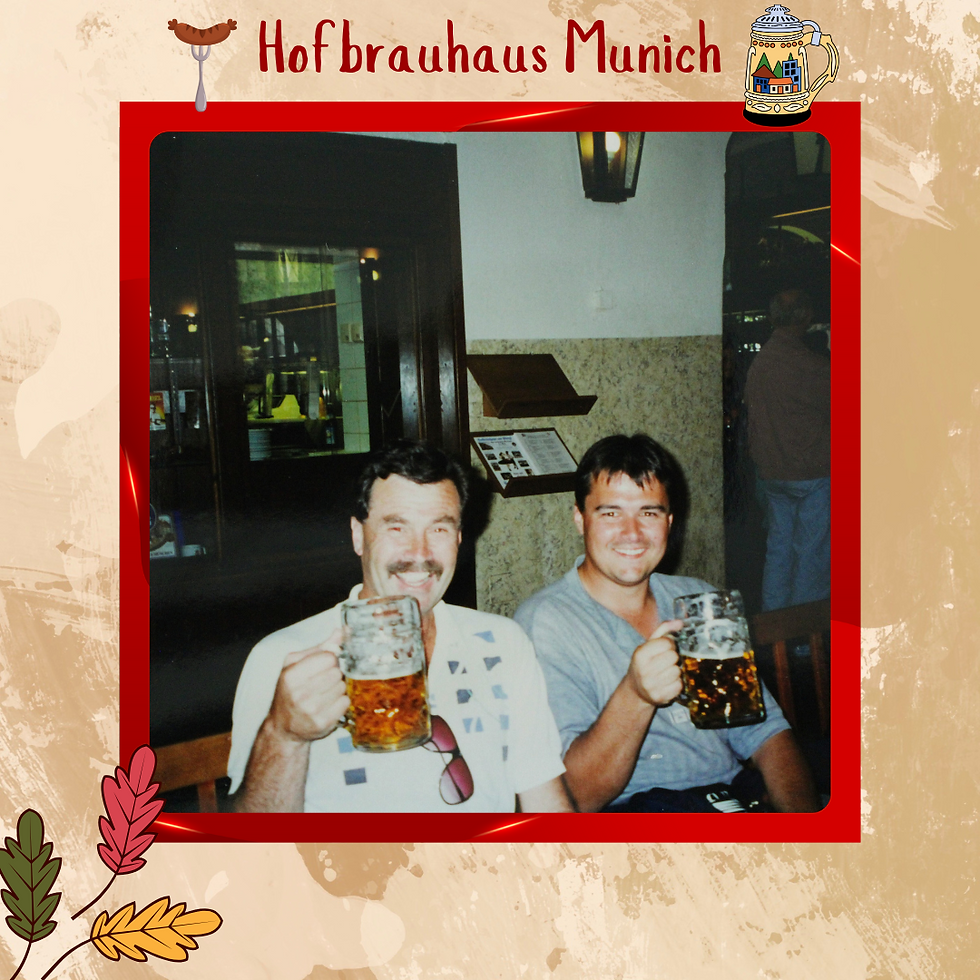
There were several people who stood out with their quirkiness, and I still remember them to this day. There was a couple from San Francisco who were elderly; Mrs G had dicky knees, I recall. They were slow - and I get it - but they complained a lot and we wondered why they'd even done the tour. They also refused to get back on the bus until the exact time we’d been told to reboard, so we often sat in our seats, watching them hover outside before they finally got on the bus.
There was another American couple who were super nice, but I felt kind of bad for them as they didn’t seem to have much money to spend. We didn't, either, but enough to do a good selection of the optional extra trips. They didn’t do any of the optional extra tours and we noticed them taking food off the buffet table each morning to eat during the day.
There was a solo female traveller from Atlanta, and she told us she was renting her house out for an exorbitant price during the Olympics. She said she was desperate to be out of Atlanta! Another solo American woman was from NYC; she told us her husband was a pro golfer and she was on the tour on her own as compensation for being a golf widow. She was quite nice but seemed unwilling to step out of her comfort zone or think for herself, even to the point where she’d thrust a heap of currency at us constantly and ask us to tell her how much money she had. I remember her asking us one day, "Do I have enough for an ice cream?" I mean, really, just count it!
There were two married women on the tour, one of whom was travelling with her senior mother and one with her 20-something daughter. One ended up involved with the tour director and the other flirted with all the men on the bus, including my husband (who was pinched on the butt at one stage). You do you, but I was embarrassed for both of them as their behaviour was a little cliched. The woman who was flirting had people's attention. I'd be mortified if I knew the group was watching me like that. I’m not sure whether the others noticed the woman who was involved with the tour director, but we did and so did T&D. She looked exhausted the longer the tour went on. I have no idea how she kept up a relationship with the tour director, on top of the tour activities.
Reading my comments on our travelling companions again, they sound a bit petty and judgy, but when you're stuck with people on an extended bus tour, you notice things. Even slightly irritating behaviour gets on your last nerve after a while. We were also young and naïve!
The hardest part of the tour was the hectic pace and the stress of constant clock-watching to keep to the schedule and to manage any free time. The amount of time allocated to wander around on our own didn’t always align with our expectations especially since the emphasis often seemed to be on shopping. There were lots of instances where we wished we’d had more time to soak up a place and others where we wish we’d had less. Without the benefit of Google and mobile phones and pre-knowledge of the free time, we couldn't plan for it, so it was sometimes a challenge to make the most of non-scheduled periods.
The relentless pace and whiplash you experience from seeing so much so quickly is exhilarating but also exhausting. There's no down time to process all that you have seen and experienced. While we felt it was an incredible experience, there is something less adventurous about being on a bus tour and not having to fend for yourself. I’ve had so many amazing experiences since then where I’ve been on my own and had to navigate unfamiliar places.
The fun bits
Even though I've written a lot about the negatives, we did have an amazing adventure. I still can't believe I have been to all those countries! This guy, whose name I can't remember, was originally from Italy, living in Melbourne at the time of the tour. He was adorable and entertained us singing in Italian as we drove to dinner in Florence.
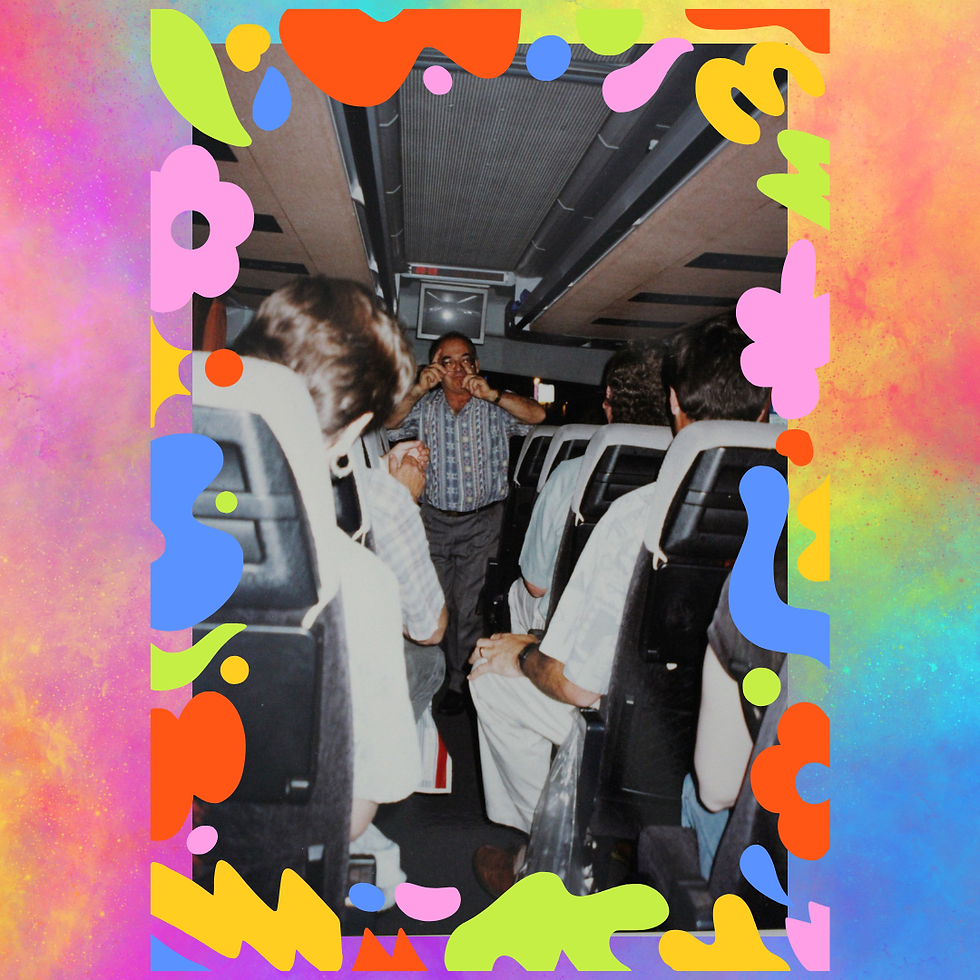
Graeme was super knowledgeable and fun to be around. We thought he'd be stricter with punctuality, though. He seemed reluctant to answer tricky questions and deal with complaints. His lecture about tipping Luc was a bit much, too. Just ask us politely to tip the guy, mate, without making us all feel shamed into doing it! He ignored us because we caused him no problems, but that was OK with us.
Even though others complained, we had no issues with the hotels as a nice bed and warm shower are all we need. We had expected from the tour information that the hotels would be more centrally located, as we’d imagined wandering around at night on our own. That said, there were often included night-time tours or dinners at local restaurants, so we didn’t have much free time in the evenings. On top of that, we were always knackered from the day’s activities.
From my experiences since the European tour, day tours are a great option, as you can mix up independent travel with the safety and ease of seeing things that would be harder to experience on your own. I have done lots of such trips in the years that have followed that have given me amazing memories. I've visited places on day tours I never would have gotten to on my own, for example Transylvania in Romania, and Gallipoli in Türkiye. Shorter tours with more time to explore places are also great, as was my experience in Morocco in 2007.
Travel tip: if you want to do an extended tour, choose wisely. Pick something that will allow you a nice mix of guided excursions and free time or at least one that has a quieter pace so that you have time to truly immerse yourself in unfamiliar places and spaces, not dash madly from one place to another. I realise reading this post how many things we either drove or walked by and didn't have the chance to even go inside, let alone explore in any depth.
Whew! This post is MEGA, but so was the tour. Here are my reflections on what the experience meant to me.
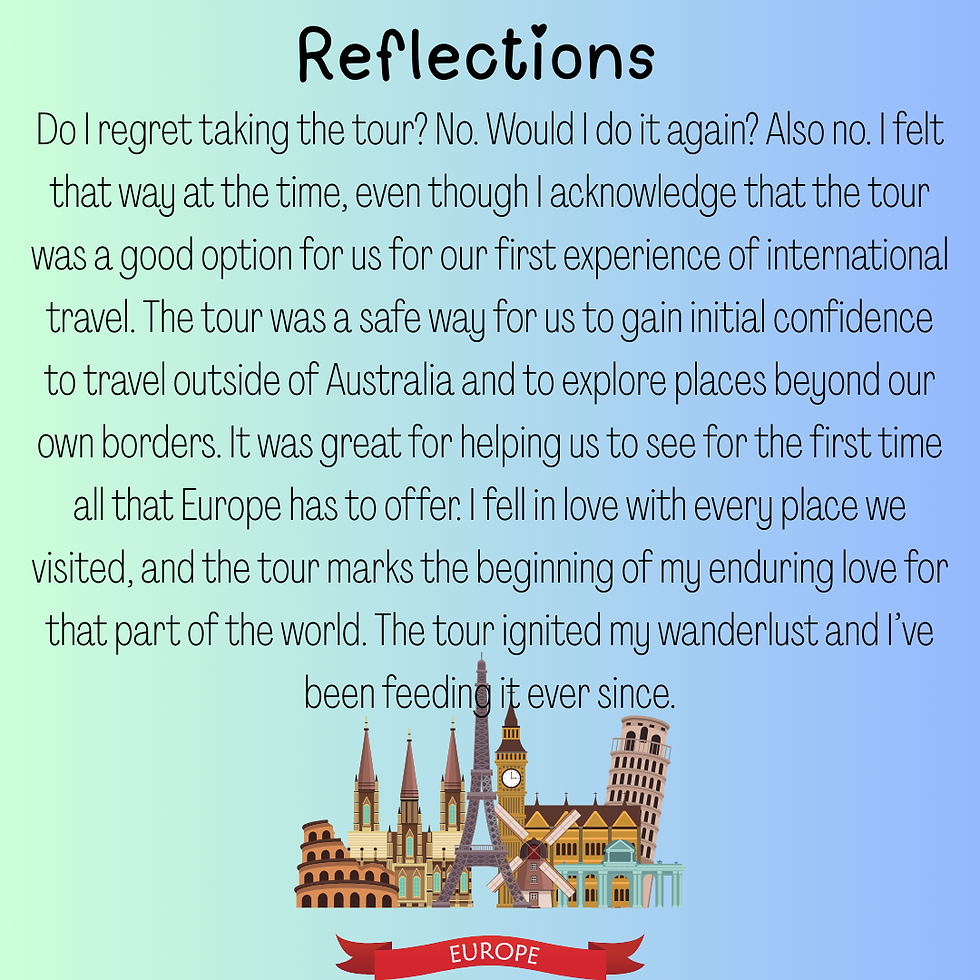
Footnote: I've included below a picture of the currency pack we were given, in exchange for 100 GBP, to see us through the tour for small purchases. How funny it is to think of this now, with credit cards and Euros the norm.
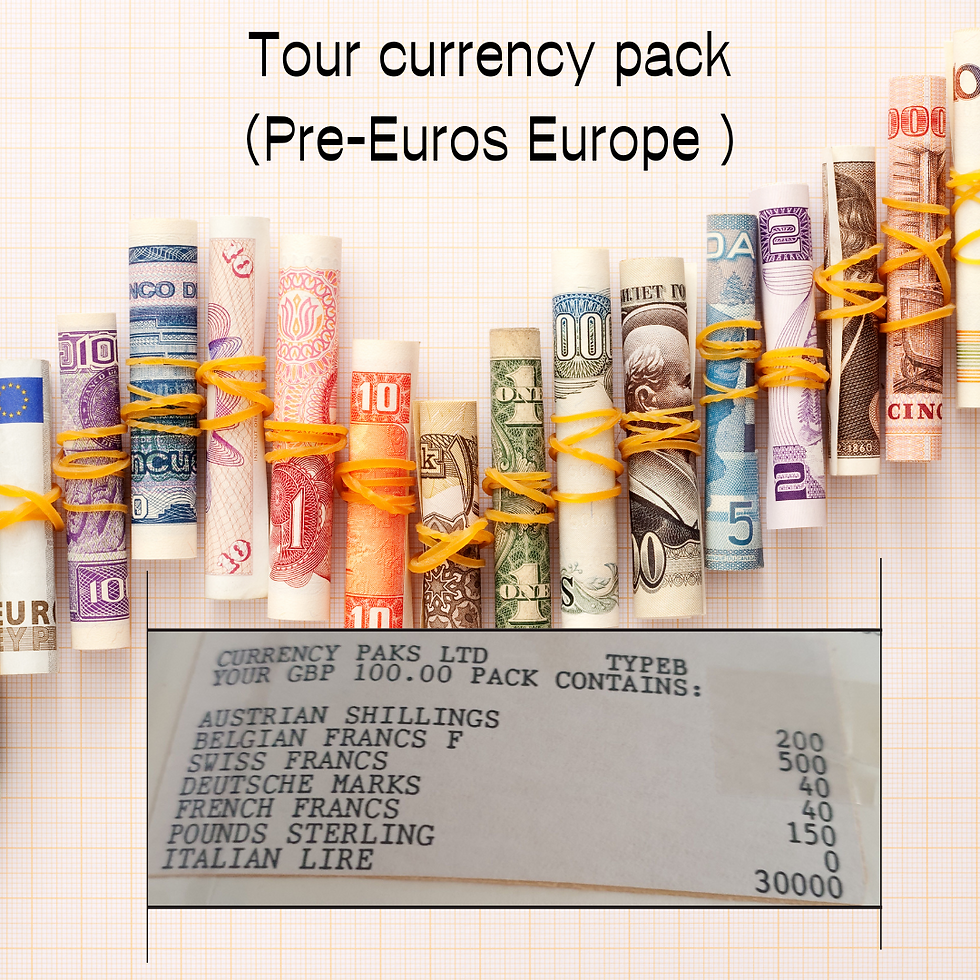
What next?
After we finished the tour we picked up a hire car at Heathrow and did a self-drive for two weeks around the UK (minus Northern Ireland). Read my post about our car trip around England, Scotland, and Wales to complete the posts on our 6-week first foray into the world.
(We eventually had the chance to visit Northern Ireland, and the Republic of Ireland, too., but not until our 25th wedding anniversary. You can read about those wanderings on my blog.)





Loved reliving your journey in 1996